








































Our new electric lineup made a lot of noise in Vegas. Which is impressive, since they cut noise in half while keeping the same power. That means you can work overnight or indoors. And we also built them to fast charge at a station, or recharge directly on the jobsite, because even small machines should deliver big results.

2023 CONEXPO, Work Truck Week Showcase Equipment. Highlights of both shows included rebranding, brand personalities, new compact electric machinery and green truck initiatives.
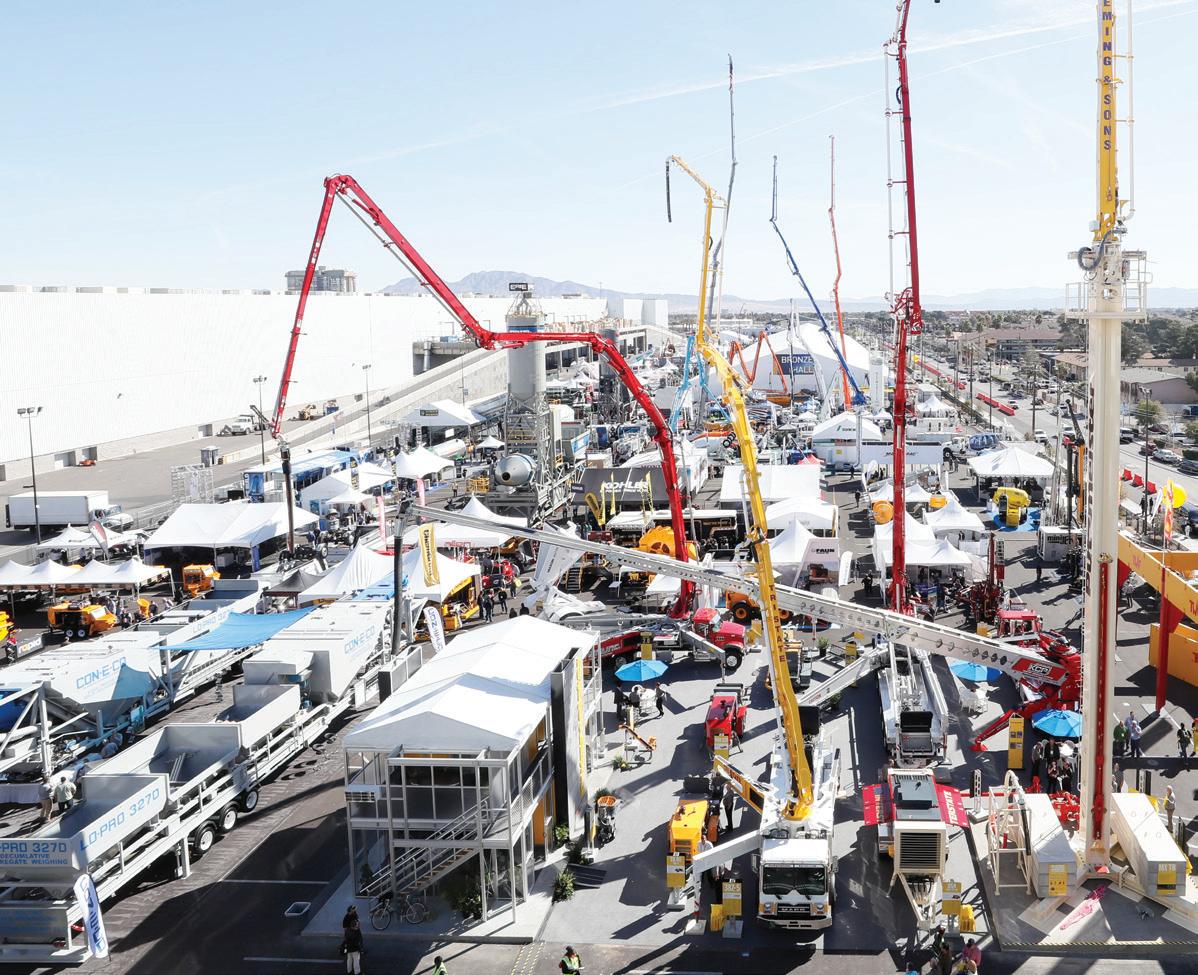
BREAKING GROUND
2023 CONEXPO and Work Truck Week Usher in Spring with Refreshed and New Equipment
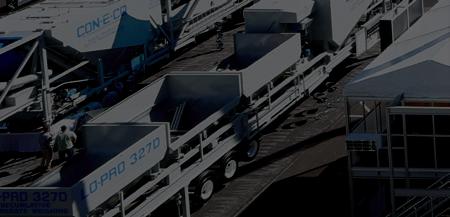
The first CONEXPO after the simultaneous pandemic shutdowns of March 2020 did not disappoint.
EQUIPMENT INTRODUCTIONS
Big Iron
Check out the newest construction equipment and products, many of which are from CONEXPO.
PROFIT MATTERS
Heidelberg Materials Rolling Out IoT In-Drum Monitoring in Southeast
In-drum sensors and supporting software from Command Alkon already reducing waste and saving dollars by enabling concrete re-use and improving quality.
BRIDGING THE GAP
Inexperienced Worker Conundrum: Help Protect Your Employees and Your Bottom Line
How green are your workers? Protect your construction business from business issues related to injuries and accidents.
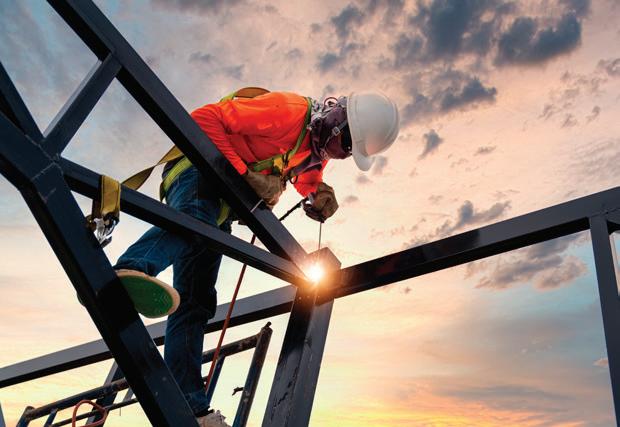
RUNNING THE BUSINESS
How to Handle Construction Equipment Spending in 2023 Business owners need to be careful with their spending and managing their balance sheets during 2023, to avoid the pitfalls of inflation and overspending.
FLEET MANAGEMENT
Mobile fueling, generators, chargers and more to maintain a sound fleet.
TECHNOLOGY
Surveying and layout software to plan the perfect worksite.
18 24
EARTHMOVING TRENDS

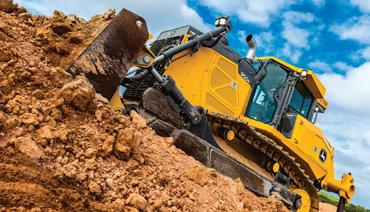
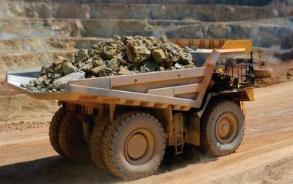
Alternatively Powered Wheel Loaders Perform Heavy Lifting on Jobsites
Wheel loaders with traditional combustion engines are practical, well-established and familiar to fleet managers and operators alike, and yet the new, electric versions don’t have engine maintenance costs, have fewer emissions and can be used indoors.

FLEET MANAGEMENT
Maintaining Equipment, Following Best Grading Practices Earn Contractors High Marks
Not only is proper grading on construction jobsites crucial to a job’s long-term success, but improper grading can have significant ramifications on a job’s timelines and costs.

FLEET MANAGEMENT
28
Electrification is Coming for Mid-Size Fleets
With the electric medium-duty vehicle market booming and sustainability deadlines looming, companies must keep a pulse on these four key industry trends throughout 2023.
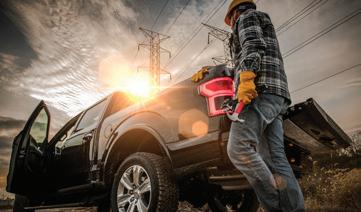
31
FLEET MANAGEMENT
Increase Site Responsiveness With Mobile Fuel Tanks
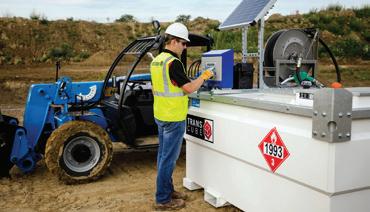
Transportable fuel tanks can help control costs and allow contractors to respond to the quickly changing market conditions that impact their bottom line.
TECHNOLOGY
36 39
How Technology Revamped a Historic Racetrack
The Walbec Group worked with Road America to repave the historic track.

TECHNOLOGY Using Autonomous Reality Capture on Jobsites and Why it Matters

As reality capture technology is more commonly used on construction jobsites, decision makers are constantly evaluating the upside of the investment.
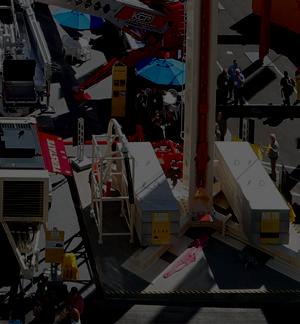
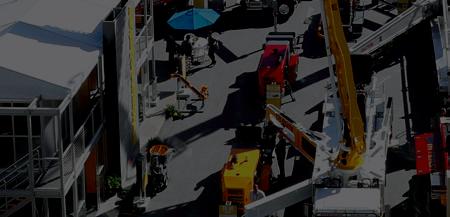

VIDEO NETWORK https://eqtoday.co/k2p285
DIGGING DEEPER PODCAST https://eqtoday.co/s7sfkm

PREMIUM CONTENT
https://eqtoday.co/9pd73s
Spring is a time of new life and renewal, so it is fitting that the April issue of Equipment Today should publish shortly after the biggest construction equipment show in North America, the once-everythree-years extravaganza of CONEXPO-CON/AGG.
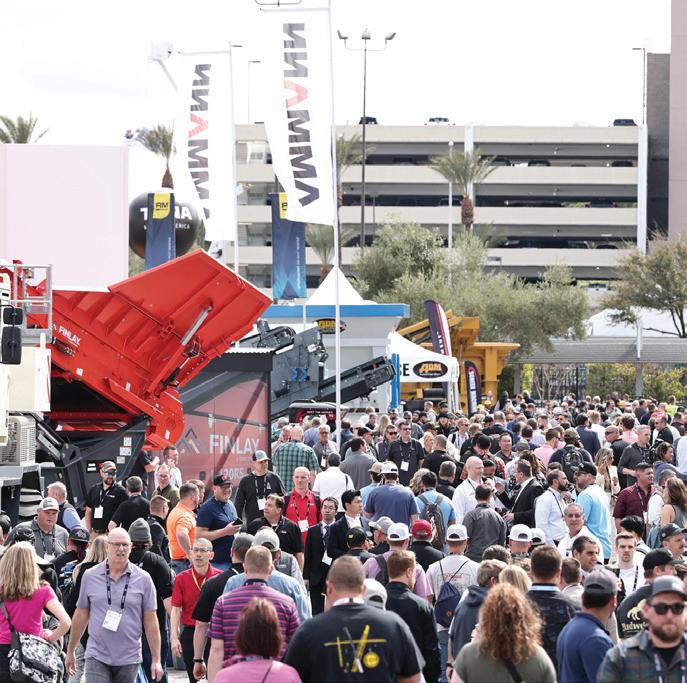
Spring is a time of new life and renewal, so it is fitting that the April issue of Equipment Today should publish shortly after the biggest construction equipment show in North America, the once-everythree-years extravaganza of CONEXPO-CON/AGG. Fresh new branding (DEVELON), a decisively customer-centric attitude (CASE), a commitment to going green (Volvo) and electric innovation (Bobcat Co.) were all highlights of this year’s CONEXPO. Alternative power – hybrid and electric fuels in particular – continues to proliferate throughout the industry, a forward-thinking attitude reflected both by the machines at CONEXPO and the stories in these pages.
Similarly exciting, electrified products and solutions-oriented equipment shone at Work Truck Week earlier in March, though it occurs every year. Ford Pro, Ram, Mack Trucks and Mercedes-Benz all demonstrated commitment to solving customers’ challenges, one feature or engine at a time, or with entirely new models. Keep an eye out for our Work Truck Week coverage both in this issue and on ForConstructionPros.com.
The impressive construction heavy equipment product launches of the past six months will set the tone in the construction equipment industry for the next decade, at least. A bold statement? Perhaps. But by the time you read this editor’s letter, 2023 CONEXPO-CON/AGG, IFPE and Work Truck Week will be over, with many new products, machines and technologies launched at the shows. Many of the products, equipment and tech touted and displayed at CONEXPO had their big launch on the global scene at bauma 2022, which took place in Munich in October 2022, a mere six months ago.
While the time between those massive outdoor displays in Germany and the splashiness of 2023 CONEXPO’s many equipment demos might seem short, the quick-turnover
and fanfare of the high-power tradeshow season are a celebration of years of hard work, behind-the-scenes innovations, and long-view engineering. CONEXPO 2023 may very well have been the most all encompassing, innovative lineup of construction heavy equipment in the show’s history. Creative brainstorming, constant thought, meticulous design, intense collaboration and dedicated cross-departmental product management and marketing efforts brought us these new and exciting machines. There were so many new machines presented at CONEXPO 2023, we decided to create a special product section in this issue of Equipment Today, to feature a smattering of the thousands of machines at the show. While only a small sampling, we hope you find the entries useful as you look to update your fleets. The technologies have really been fine tuned and improved in recent years, making an alternative-fueled construction vehicle fleet one step closer to becoming a reality. Let’s not forget, however, our traditionally-fueled equipment, which continues to power our jobsites. There were many Tier 4 engines on display, featuring tech improvements to reduce fuel use and maintenance downtime.
We want to thank the countless heavy equipment manufacturers who hosted us at their exhibit booths, gave us demonstrations and walked us through their newest technologies. We are grateful for the time you took to share your knowledge with us so we can pass it on to our readers. Look for CONEXPO coverage in the pages of this and future issues of Equipment Today, on our website, ForConstructionPros.com, and in our social media videos and our podcasts.
EDITORIAL
Editor-in-Chief Erica Floyd efloyd@acbusinessmedia.com
Digital Content Director, IRONPROS Wayne Grayson wgrayson@acbusinessmedia.com

Managing Editor Gigi Wood gwood@acbusinessmedia.com
Technology Editor Charles Rathmann crathmann@acbusinessmedia.com
AUDIENCE
Audience Development Manager Angela Franks
PRODUCTION
Senior Production Manger Cindy Rusch crusch@acbusinessmedia.com
Art Director April Van Etten
ADVERTISING/SALES
Brand Director Sean Dunphy sdunphy@acbusinessmedia.com
Assoc. Brand Director Nikki Lawson nlawson@acbusinessmedia.com
Sales Representative Kris Flitcroft kflitcroft@acbusinessmedia.com
Sales Representative Tadashi Soma tsoma@acbusinessmedia.com
Sales Representative Kristin Pride kpride@acbusinessmedia.com
Sales Representative Megan Perleberg mperleberg@acbusinessmedia.com
Sales Representative Greg Schulz gschulz@acbusinessmedia.com
AC BUSINESS MEDIA
Chief Executive Officer Ron Spink
Chief Financial Officer JoAnn Breuchel
Chief Revenue Officer Amy Schwandt
Chief Digital Officer Kris Heineman
Brand Director, Supply Chain & Green Industry Jason DeSarle
Brand Director, Construction Sean Dunphy
VP, Audience Development Ronda Hughes
VP, Operations & IT Nick Raether
Content Director Marina Mayer
Director, Online & Marketing Services Bethany Chambers

Content Marketing, Marketing Services Jess Lombardo
Director, Demand Generation & Education Jim Bagan
CIRCULATION & SUBSCRIPTIONS
PO Box 3605 Northbrook, IL 60065-3605, Phone: (877) 201-3915 Fax: (847)-291-4816 circ.EquipmentToday@omeda.com
LIST RENTAL
Sr. Account Manager Bart Piccirillo, Data Axle 402-836-2768 | bart.piccirillo@data-axle.com
REPRINTS & LICENSING
Assoc. Brand Director Nikki Lawson nlawson@acbusinessmedia.com
E @EquipmentToday D @EquipmentToday
C @equipment-today-magazine-official Q @equipmenttoday


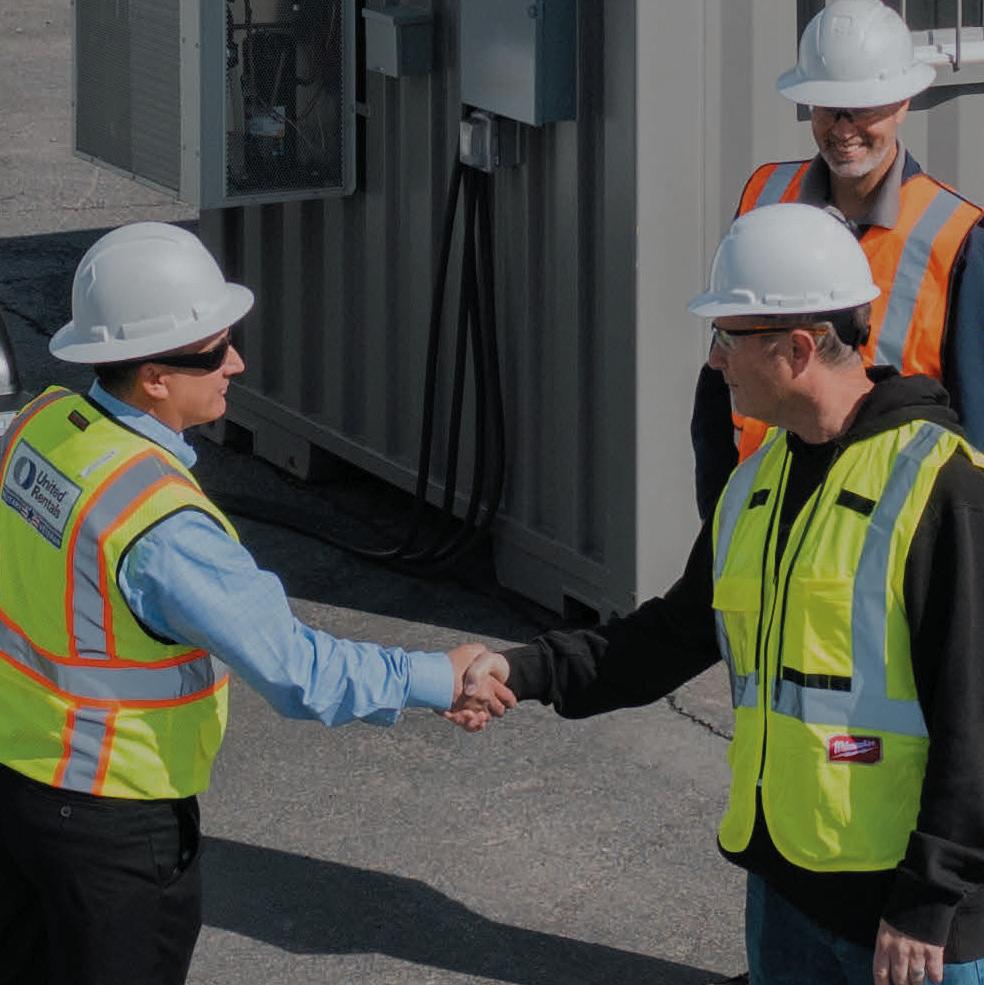





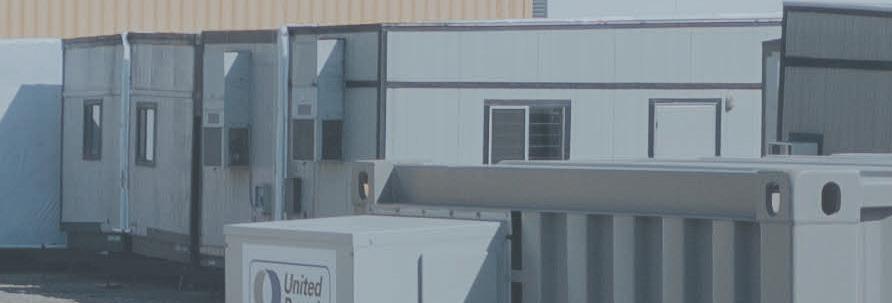







Tsurumi America has a new line of electric submersible pumps, engine pumps and generators. The pump manufacturer displayed a range of newer products at the ARA show, including its TM, HSE and UT series. Tsurumi also showed the LSC and LSR drainage pumps and will highlight the recent introduction of Vanguard Series engine pumps, as well as its new line of Honda-powered heavyduty contractor-grade generators with carbon monoxide detectors.
The product lineup on display at this year’s event includes:
• HS Series (HS, HSD, HSE and HSZ) submersible pumps
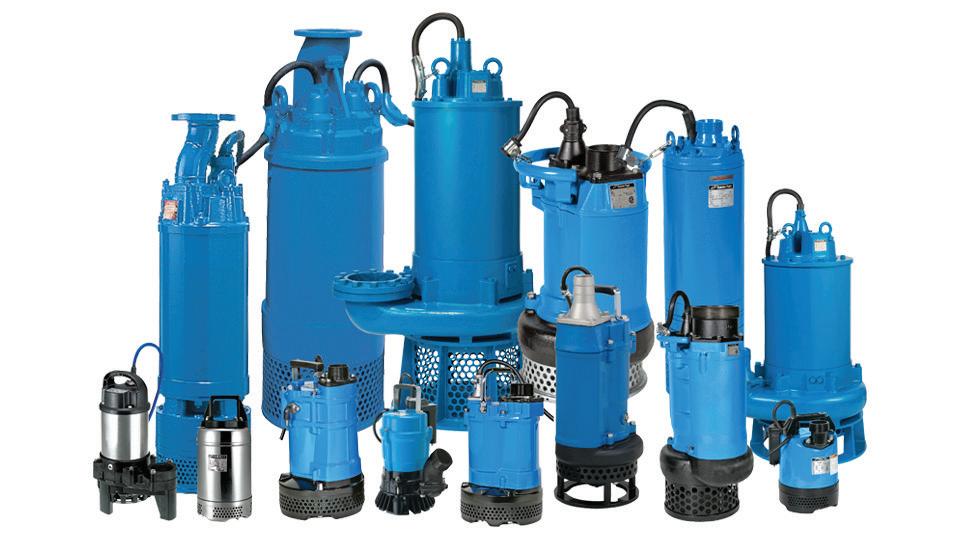
• LSC and LSR series low-level, highvolume drainage pumps
• LB Series slimline dewatering pumps
• NK Series high-volume contractor pumps

The SW405K has an operating weight of 40,786 lbs., a full turn tipping load of 28,881 lbs. and is powered by a 252-net-hp Deutz TCD 7.8, four-cycle, turbocharged, electroniccontrolled diesel engine.
• Z-bar linkage design delivers nearly 40,000 lbs. of breakout force
• Comes with a 4.2-cu.-yd. bucket capacity and has a 123-in. maximum dump height
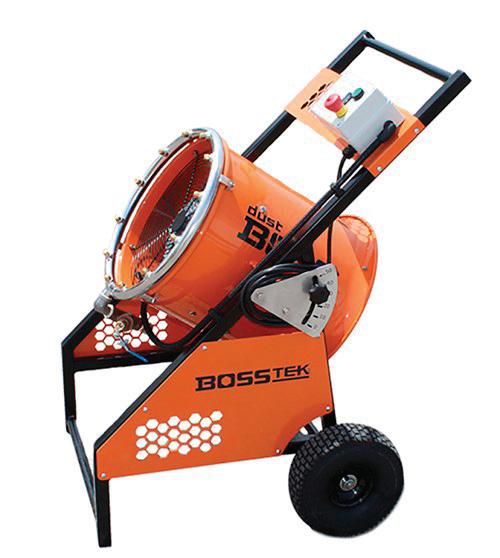
The NANO10-XD has a compact design and eliminates the potential risk of an oil leak for environmentally-sensitive applications due to zero hydraulic oil with all-electric lift, steer and drive.

The NANO10XD delivers extended battery duty cycle with standard lithiumion batteries while requiring less charge time and delivering more up time. With a platform height of 10 ft., the new scissor can be used in data centers, hospitality, food service-related operations and pharmaceutical applications. Along with being lightweight at 1,235 lbs. and low ground pressure, the machine can be used on a wide range of floor types. At 63 ft. tall and with no folding rails, the machine can pass through standard door frames.
ELGi has launched its portable compressed air solutions for the construction industry, the D185T4F and GP75 compressors. Powered by a Kohler KDI diesel engine, this portable air compressor provides a compressed air source with a capacity of 185 cfm at 100 psi or 150 cfm at 150 psi. The Kohler engine design enables the portable air compressor to achieve Tier 4 Final EPA requirements without the need for a Diesel Particulate Filter (DPF) or a Diesel Exhaust Fluid (DEF) system. In addition, the D185T4F is equipped with a new DeepSea controller and Intelligent Start-Stop System that prevents coldstarting and blowback.

The all-new AS750, AS850 and AS1000 swing loaders feature a rigid chassis and three steering modes. At just over 11,000 lbs. (5,000 kgs) and with a bucket capacity of 0.98 yd3 (750 liters), the AS750 is the second smallest swing loader model. The mid-size AS850 has an operating weight of 13,184 lbs. (5,980 kgs) and a bucket capacity of 1.1 yd3 (850 liters). This model encapsulates the capabilities of the AS series swing loaders with optional increased travel speed up to 25 mph (40 km/h). A step up in power from the AS850, the AS1000 is also a mid-size model at 14,639 lbs. (6,640 kgs) with a bucket capacity of approximately 1.3 yd3 (1,000 liters). It is powered by a 4-cylinder 75 hp (55.4 kW) high-torque engine.

• High-pressure, load-sensitive hydraulics offer a 10% to 15% reduction in energy usage

• Features a boom suspension system, bucket self-leveling, return-to-dig and automatic transmission kickdown
Cannon
BossTek has introduced the DustBoss DB-10 atomized mist cannon, which can be used to suppress indoor particulate emissions during demolition and raw material handling.
Engineered for enclosed working environments, the maneuverable unit provides suppression in a compact, portable design. The outcome is airborne particle control with minimized emissions and less standing water. The compact mist cannon is mounted on two wheels with a tall handle. A ¾-hp fan delivers 3,335 cfm of airflow, powered by 120-volt current. Mounted on the front of the cannon is a circular manifold with 12 atomizing nozzles that fracture pressurized water into a fine mist. About as loud as a hand-held hair dryer, the fan forces air through the barrel then pushes millions of tiny droplets in a cone-shaped pattern up to 30-ft. (10 meters).

The 3-ton WL28 has a compact design with minimized tailswing and optimized steering angle that allow navigation in tight spaces.


• 45- or 54-hp Yanmar Stage V engine offers an efficient regeneration system, optimal power-to-weight ratio and lower fuel consumption
• Electronic regulated drive system provides improved pushing power, speeds up to 18.6 mph and an electronic parking brake with hill-hold function
• Standard auto/eco mode and optional attachment mode




• Cab offers increased operator space, improved ergonomics with intuitive controls, air conditioning and increased visibility on all sides
Compatible with Genie S-45 XC, S-65 XC and S-85 XC boom lifts, the 13-ft. platform is for tasks that involve an extensive working area, as well as jobsites with limited space to maneuver on the ground. The extra space in the platform also provides access to twice as much work area with the same number of boom movements, compared with a standard sized 8-ft. (2.44 m) platform. After following instructions to install the 13-ft. platform and calibrating the machine, the S-45 XC, S-65 XC and S-85 XC can take up to two workers to height and deliver a 600-lb. lift capacity. Additionally, operators can utilize other features on Genie’s XC machines, including automatic envelope control, working curve and active load sense.



ASV's lineup includes four Posi-Track loaders for landscaping, construction and forestry. The repowered RT-40 compact track loader includes a more powerful, new 38.2-hp Tier 4, three-cylinder Yanmar engine. The small-frame machine is for landscaping applications, rental and more. Its operating weight is 4,005 lbs, with a rated operating capacity of 931 lbs. Ground pressure is 3.3 psi. ASV’s MAXSeries RT-135F and RT-75 loaders include a next-generation cab featuring 360-degree visibility, an operator area, a fully adjustable seat, a new touchscreen display and more. The RT-135 Forestry Posi-Track loader features 10% more horsepower than the previous titleholder it replaces, the RT-120.

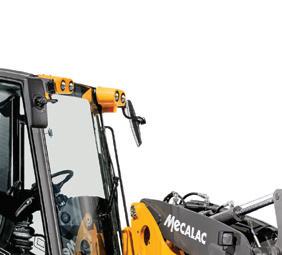
The PC210LCE was created for construction businesses that need a high-performance machine. The excavator has 451 kWh of battery capacity and is designed for up to eight hours of operating time. The lithium-ion battery technology was developed by Proterra. Designed to reduce operator fatigue with less noise, exhaust emissions and zero engine vibration, the PC210LCE is for use in urban areas and indoor environments. The low operating noise levels of the PC210LCE allow for nighttime construction work both indoors and out. Coming soon to North America, the PC210LCE supports Komatsu’s global sustainability targets of 50% reduction in CO2 emissions by 2030 and complete carbon neutrality by 2050.
Komatsu displayed the PC210LCE at CONEXPO-CON/AGG with Smart Construction Retrofit, a guidance kit that gives operators in the field and managers in the office access to 2D and 3D design and payload data. Installed by a local Komatsu distributor, this technology upgrade is designed to support grading performance and drive operations.
Subsite Electronics has introduced the Marksman for shallow bore projects. The Marksman is the second product introduced in the Marksman series of HDD guidance systems, following the release of the Marksman+ in 2021. The Marksman features single-button calibration, minimizing the risk of human error and supporting the preparation process. Six frequency options and simplified features are designed for completing shallow bores for service installation. The Marksman is compatible with Subsite’s TD Recon and Commander 7, as well as the Subsite Field Scout.

Pettibone has showcased the Cary-Lift 204i wheel loader for material handling jobs on construction sites. The Cary-Lift 204i is part of the company's line of pole and pipe handlers. The machine is built to deliver safety and performance on the jobsite.
Features:
• Overhead lift arm design gives operator full front visibility when transporting loads
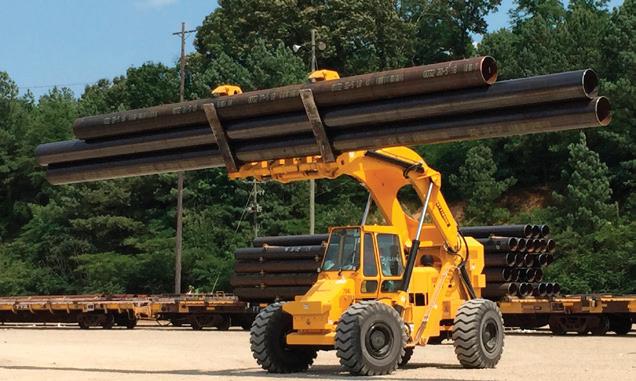

• Lifting forks capable of tilting down 90° for specialized lifting tasks
• Powered by a 200 hp Cummins QSB6.7 Tier 4 diesel engine
• Maximum load capacity of 20,000 lbs. and max lift height of 16 ft.

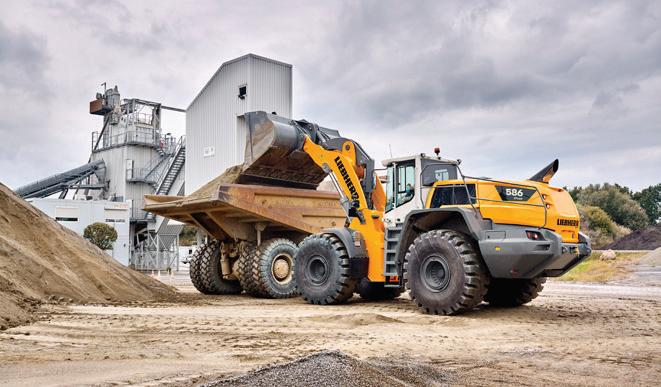

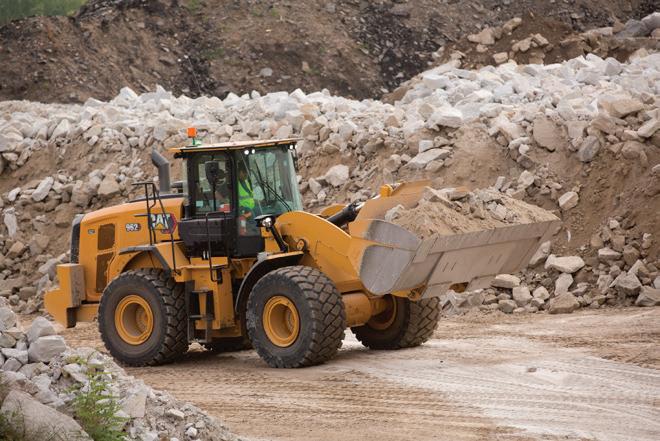
Ditch Witch has introduced the W12 truck vacuum, for potholing applications or cleaning up spills and debris. The W12 features 1,200 gallons of fresh water and a 12-cubic-yard debris tank. With 5,000 cubic feet per minute (CFM) and 27 feet Hg of vacuum power, the truck vac comes with a remote-control system for managing the water system and boom, as well as for lifting and lowering the tank. The design and layout of the debris tank, positioned between dual 600-gallon saddle tanks of fresh water, supports operation. Operators can stay on the job with the 2,400-gallon tank capacity and powerful vacuum.
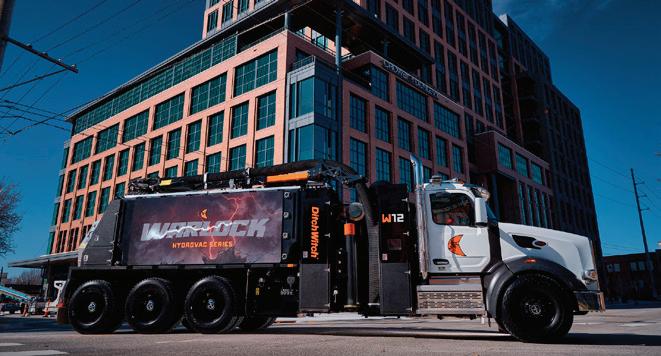
Volvo Construction Equipment has developed a solution to convert the L120 wheel loader to electric. Developed in conjunction with partners – Parker Hannifin and converted by Volvo Group’s own CE Engineering Solutions – the 20-ton L120H Electric Conversion will be commercially available for select customers in Europe in 2023. The electric conversion model will deliver the same performance with zero emissions. Powered by 240 kWh batteries, it provides a runtime of five hours in most mediumduty applications. It is estimated to charge from 0-100% in just 1.5 to two hours.


The Merlo eWorker has a maximum load capacity of 5,511 lbs. It features a maximum lift of 15 ft., 7 in. and a load capacity of 3,307-lbs. at maximum lift. The no-flex boom has a maximum reach of 8 ft., 5 in., handling a maximum load of 1,984 lbs. The eWorker can put in a full day’s (eight hours) work without recharging. It is a compact machine with dimensions similar to those of an industrial forklift. Equipped with a telescopic boom, the machine has a low center of gravity. Stability is gained by positioning the battery in the middle of the vehicle. The telescopic boom operates from its own electric motor that is connected to a load sensing hydraulic pump. A dedicated electronic control unit manages the rpm of the electric motor and the oil flow of the hydraulic distributor. In addition, the telescopic boom descends by gravity via a valve controlled by the same control unit.

The three models, L 526, L 538 and L 546, in the latest Generation 8 have bucket sizes between 2.2 and 3.0 m3 in the standard version and are characterized by an increase in performance compared to the previous generation. The new L 526, for example, has around 20% more engine power and over 20% higher breakout forces than its predecessor. The newlydesigned lift arm ensures maximum breakout, holding and lowering forces. It has optimized z-bar kinematics and improved working hydraulics. Increases in engine power and tipping loads prepare the wheel loaders for demanding operations in various sectors, such as excavation, recycling or log handling. Available in Europe, the L 538 and L 546 models also have performance increases in various areas: for example, with the optimized travel drive, providing increased traction to ensure that the new wheel loaders accelerate dynamically in everyday work, and can penetrate powerfully into all materials.
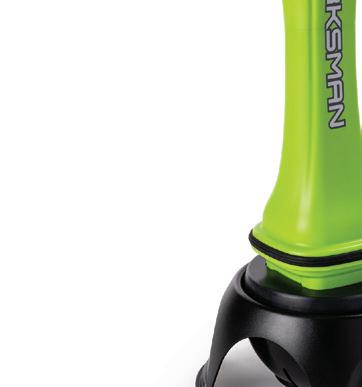
The updated L350H wheel loader has a more responsive hydraulics system featuring new lift and tilt cylinders, and an increased hydraulic working pressure for 10% faster work cycles and higher productivity. The upgraded driveline features new Volvo axles and an all-new Volvo transmission, which enables the third-generation OptiShift to be equipped as standard. This technology integrates the Reverse By Braking function and the lock-up function in transmission to improve fuel efficiency by up to 15%. An optimized gear shifting ratio and a new converter that delivers outputs of up to 22% more tractive force depending on the selected gear and machine speed. The machine also has a tougher form with a more robust upper center hinge bearing and updated frames to accommodate the new axles and transmission. The L350H
comes with a Z-bar lifting arm with double sealing on each of the pins, and strong frame structure, which is joined by a reinforced upper center hinge and new Volvo axles. Updates also include extended service intervals that increase uptime and reduce maintenance costs. The engine service interval has doubled to 1,000 hours, and axle oil change intervals have been extended to 4,000 hours thanks to an axle oil cooler with filtration fitted as standard.
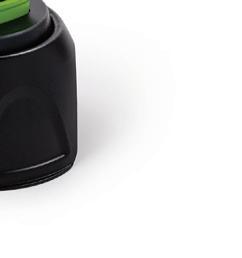
John Deere is launching E-Power machines with battery solutions from Kreisel Electric. Offering a hybrid solution, E-Drive machines feature an electrified drivetrain with an engine as the primary power source. In addition, E-Drive machines support powertrain component life and provide pushing power. The 644 X-Tier Wheel Loader offers performance with its combined E-Drive and Power Shift transmission system. In addition, the 944 X-Tier wheel loader is newly rebranded from the 944K Hybrid to align with the John Deere performance tiering strategy. With over 3 million collective customer hours since entering the market, John Deere E-Drive machines are built on customer experience and electric technology. Other new E-Drive machines include the 850 X-Tier dozer, which has been recently upgraded from the 850L model, providing customers with multiple operating models to tailor performance and fuel consumption to their specific jobsite needs. The less complex drivetrain powers each track with an electric motor to maintain the maneuverability and control of a traditional hydrostatic John Deere dozer. Lastly, the 744 X-Tier E-Drive wheel loader, featuring an electric variable transmission, provides performance in worksites.
The new 950 and 962 Next Generation Wheel Loaders have a Cat C7.1 engine with high-power density with a combination of electronics, fuel and air systems. Equipped with the automatic Cat regeneration system, the engine meets U.S. EPA Tier 4 Final, EU Stage V, Korea Tier 5 and Japan 2014 emission standards without interrupting operation. Electric fuel priming pump, fuel-water separator and secondary fuel filter combine with component design and machine validation to offer reliability and uptime. A range of standard technologies on the 950 and 962 wheel loaders monitor, manage and support jobsite operations. Providing accurate weighing of material, Cat Payload with Assist displays data in real time. The operator can now fully automate bucket loading using new Autodig to boost fill factors and loading times. Working in combination with Autodig, new Auto Set Tires facilitate proper loading technique to reduce tire slip and wear.
DEVELON, formerly known as Doosan construction equipment, has introduced its next-generation tool carrier models — the DL200TC-7 and DL250TC-7 — in the United States and Canada. These new models round out the 7 Series wheel loaders for the company.
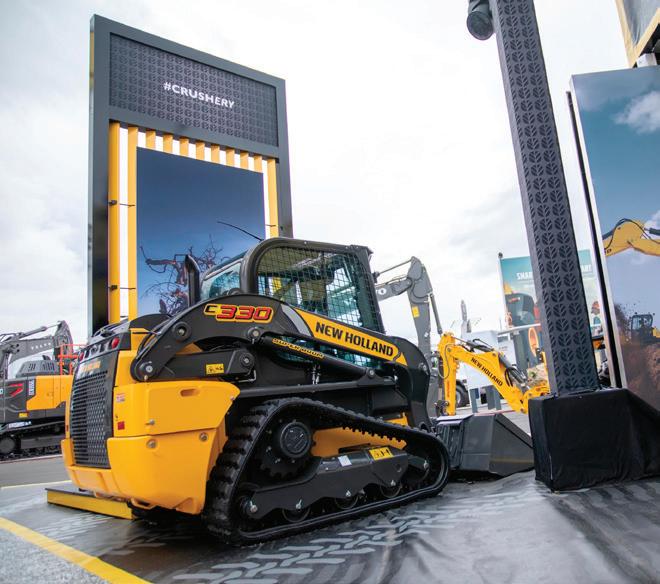
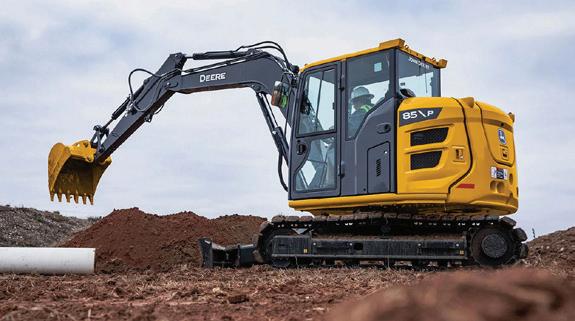
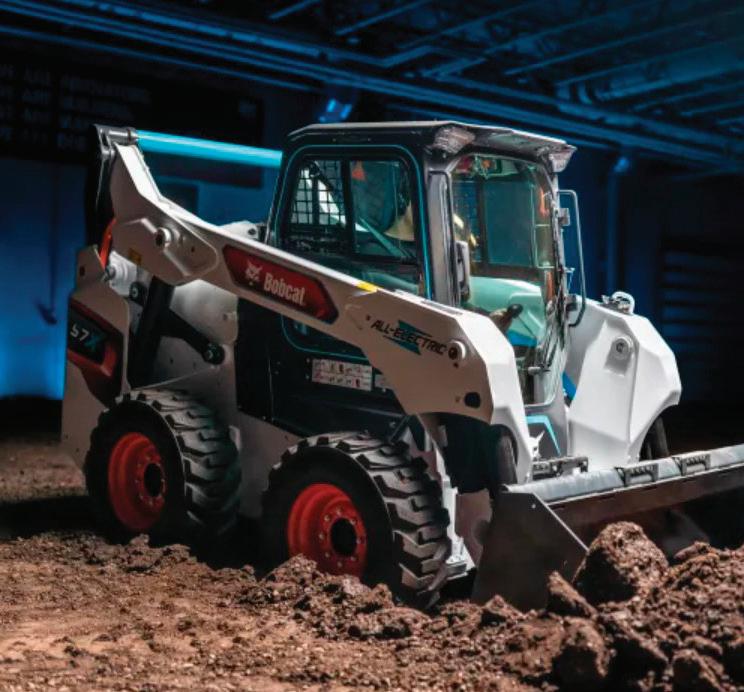
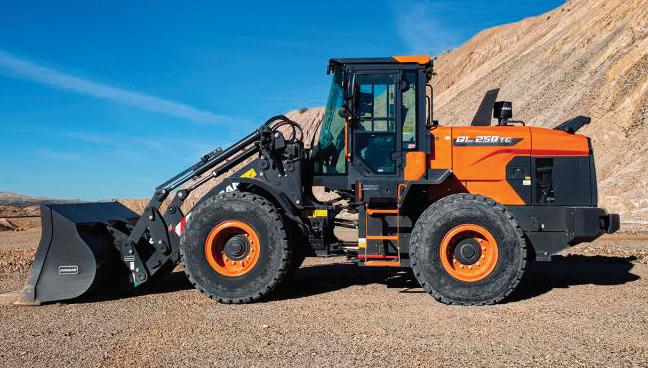
DL200TC-7 (replaces the DL200TC-5)
• 142-hp (104 kW)
• Operating weight: 26,868-lbs. (12,187 kg)
• Bucket capacity: 2.6-cu.-yd. (2 m3)
• Dump height: 8-ft.,10-in. (2.7 m)
Breakout force: 20,682-lbs. (9,381 kg) with 2.6 cu. yd. bucket
DL250TC-7 (replaces the DL250TC-5)
• 172-hp (127 kW)
• Operating weight: 31,350-lbs. (14,220 kg)
Bucket capacity: 3.1-cu.-yd. (2.4 m3)
• Dump height: 8-ft., 9-in. (2.7 m)
• Breakout force: 20,231-lbs. (9,177 kg) with 3.1 cu. yd. bucket
Compared to the 85 G-Tier model, the new 85 P-Tier offers an 18% engine horsepower increase and the addition of turbo for high altitude performance. Hydraulic performance improvements include increased pump torque and improved dig forces. The redesigned cab is equipped with an 8-in. monitor with Bluetooth and a 270-degree camera system integrated into the main monitor. Improved service access and optional features, such as angle blade with float and continuous flow auxiliary hydraulics, round out the updates. Coming in at 51-metric tons, the 510 P-Tier is a replacement of the current 470 P-Tier model. Including a variable undercarriage and the ability to handle buckets five yards and above, this new model will continue to deliver performance and capability in its class. This machine is designed to deliver performance to customers in mass excavation or deep underground applications.
Mack Anthem 6x4 Day Cab and 6x4 70-in. Stand-Up Sleeper
The Mack Anthem day cab is outfitted with a Cummins Compressed Natural Gas (CNG) engine with 400-hp, 1,450-lb.-ft of torque and a 12-speed automated manual transmission (AMT). The Mack Anthem 70-in. stand-up sleeper is powered by the Mack MP 8HE engine with 445-hp and 1,860-lb.-ft. of torque. Transferring that power to the wheels is a Mack mDRIVE 12-speed automated manual transmission. Both Mack Anthem models are equipped with Mack GuardDog Connect, Mack’s integrated telematics solution.
Mack Anthem 6x4 Day Cab
• Engine: Cummins ISX12N-G 400-hp ,1450-lb.-ft. torque
• Transmission: Eaton Endurant 12-speed Overdrive AMT
Features: Mack GuardDog Connect; Mack Road Stability Advantage; Bendix Wingman Fusion 2.0 front and side collision avoidance system and Mack aero+ day cab roof fairing
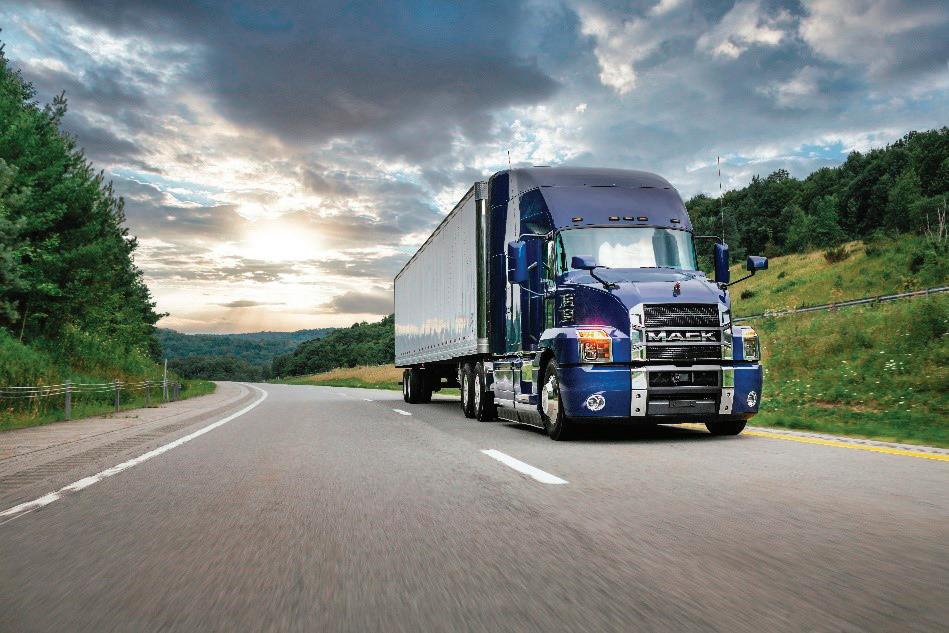
Mack Anthem 6x4 70-in. Stand-Up
Sleeper
• Engine: Mack MP8-445HE engine, 445hp, 1,860-lb.-ft. torque
SEPPI has launched its latest mulching equipment: the MAX 50 le, a mulcher than can be operated by remote control, the MICROFORST cl compact mulcher for skid steers or compact track loaders and the MINISOIL cl that crushes stones and mulches wood. The MAX 50 le can be operated from a safe distance by using a remote control that displays key machine data like fuel, rpm and speed. The MICROFORST cl is a compact mulcher that can attach to any compact track loader or skid steer loader that delivers between 13 gpm and 27 gpm of hydraulic flow. The MINISOIL cl takes the power of a PTO stone crusher and mulcher and brings it down to size for skid steers, compact track loaders and hydraulic tractors that deliver at least 28 gpm to 66 gpm of hydraulic flow.
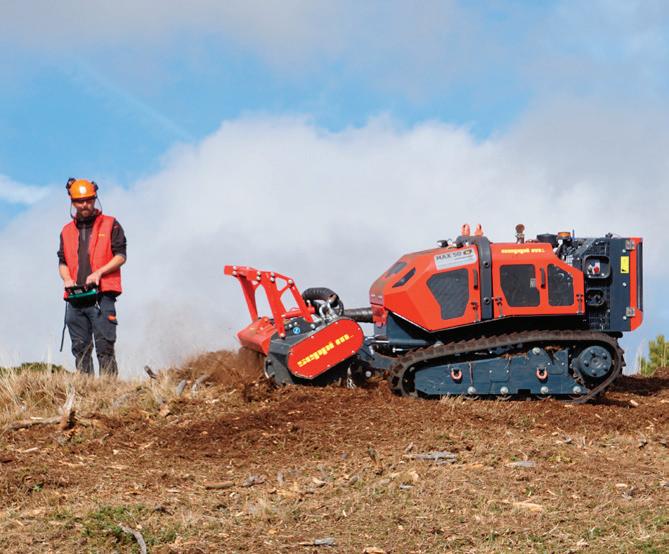

Makinex has announced it will launch a 32 kW Power Generator. The new model contains advanced alternator technology bringing control, flexibility and reliability to construction sites. The 32 kW Power Generator is the smallest generator in its class. The 32 kW generator allows for seamless running of both three-phase and single-phase equipment, is light enough to transport in the bed of a pickup truck or trailer and small enough to fit through standard doorways. With less than 3 percent harmonic distortion, no transients or voltage spikes on load rejection, the 32 kW Power Generator offers brushless three-phase power. Equipped with a permanent magnet alternator, the generator does not use electronics to regulate the voltage.
New Holland Construction added the C330 vertical lift compact track loader: a medium frame, powerful machine with the ability to maneuver in tight spaces. Notable items include:
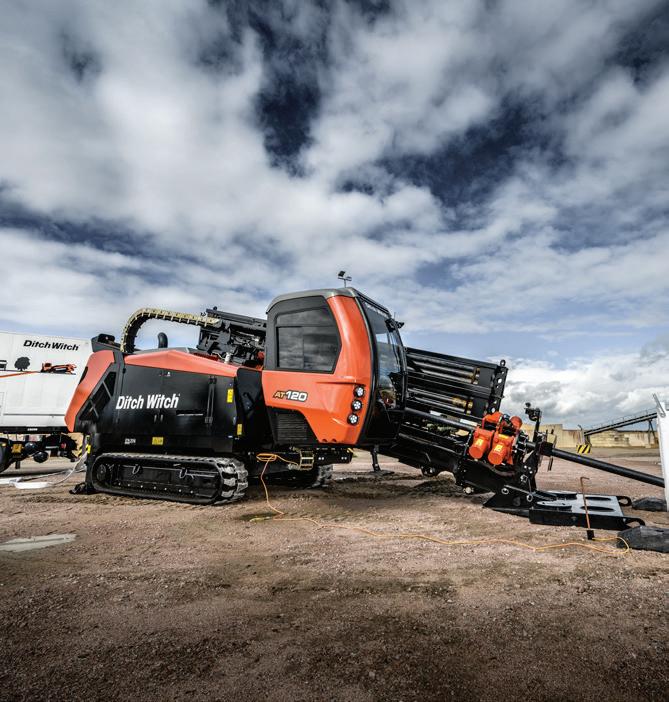
The AT120 features 15,500 ft.-lbs. of rotational torque and 3,000 ft.-lbs. of inner rotational torque, a 50 percent increase over the AT100. With 120,000 lbs. of thrust and pullback, the AT120 allows operators to take on a wide variety of projects, as well as move through longer bores and larger diameter installations more efficiently. The drill is powered by a 280-hp Cummins Stage V diesel engine that meets European emissions standards for cleaner jobsites. Built to boost jobsite uptime, the AT120 offers a 20-ft. end-to-end drill pipe on board, helping operators put more pipe in the ground. New technology enhancements include a patent-pending Virtually Assisted Makeup and Breakout (VAM) solution, which ensures the drill pipe and tooling are at the correct levels observed by the torque gauge during a bore.
• The C330 vertical lift compact track loader, with 68-in. working width and 67-hp engine, features the super boom design, New Holland Construction’s Super Boom lift, with low shoulder positioning and small towers to enhance operator visibility and worker safety on the jobsite.
The track loader allows operators to switch between ISO and H-Pattern controls, providing control over drive function and attachments.
• The power management function enables RPM speed management to deliver power to the drives, while the loader valve is under load. This allows the operator to move heavy loads without interruption.
• The C330 vertical lift compact track loader offers more height and reach to load materials into high-sided trucks.
• Engine Brake: Mack PowerLeash
• Transmission: Mack mDRIVE 12-speed overdrive AMT Manual
• Features: Mack Command Steer; Mack MP8HE+ full aerodynamic package; FlowBelow rear chassis fairing; Bendix Wingman Fusion 2.0 front and side collision avoidance system and Mack GuardDog Connect
The S7X is all electric, as it is powered by a 60.5-kWh, lithium-ion battery, features electric drive motors and utilizes ball screw actuators for lift and tilt functions. Together, the battery and electrical powertrain generate performance characteristics, with instantaneous torque that is as much as three times greater than traditional loaders. The loader balances sustainability and performance with zero emissions and is equipped to outperform its diesel-powered equivalent. This skid-steer loader offers operators a smooth and comfortable experience with minimal vibration and nearly silent operation. The S7X can operate for up to eight hours on a single charge depending on the application, giving most operators more than a full day’s work when breaks and downtime are considered. A full charge takes approximately 10 hours. At this time, the S7X skid-steer loader is being debuted as a prototype with plans to move to commercialization.
The LiuGong 856H-E MAX Wheel Loader is part of the company’s range of electric construction vehicles worldwide. The 856H-E MAX is reinforced by an IP67 rated wiring harness and waterproof integrated battery package. This machine is designed for worksites where traditional combustion engines aren’t allowed, or in fixed site operations where investments in charging infrastructure make sense. During use, the 856H-E MAX consumes zero fuel, produces zero emissions and creates lower noise and vibrations. The 856H-E MAX features intelligent controls and a human-centric design to support the operator experience. This includes load-sensing hydraulics, an EAT700 transmission with electro-proportional valve for shifting and independent control of the dual-motor drive for hydraulic lift.
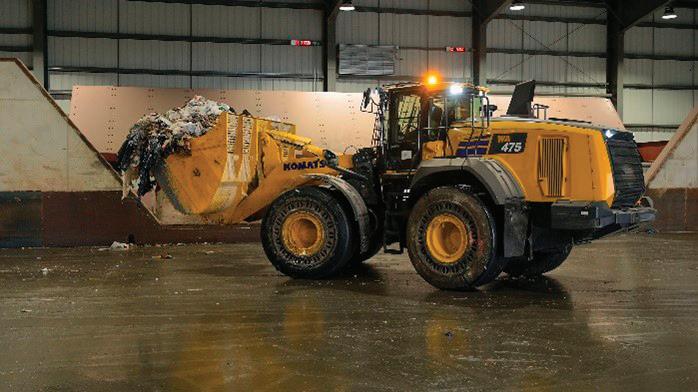
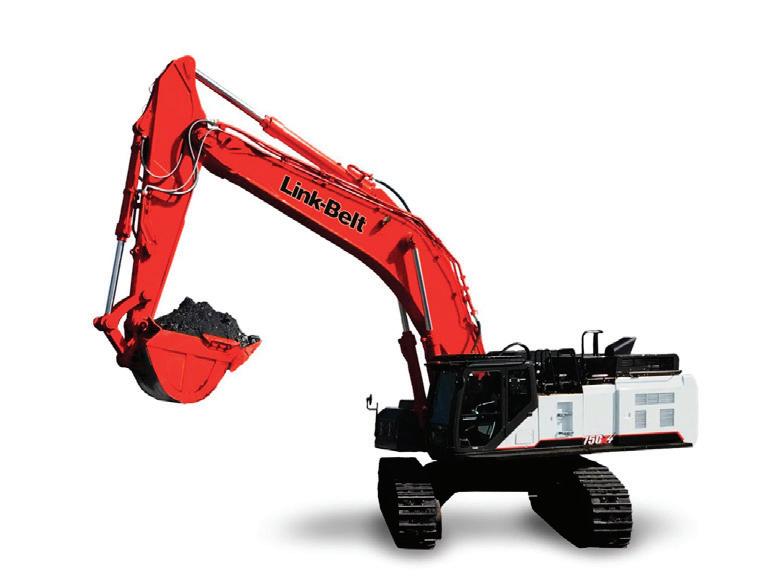
Greater digging power and increased lift capacities are the result of the Spool Stroke Control (SSC) system, which reduces pressure loss and distributes hydraulic oil more smoothly. Pilot pressure sensors detect the type of work being done, such as digging or leveling, and then relays that data to proportional solenoid valves that quickly determine where optimal hydraulic pressures should be directed for that operation. Two electronically-controlled Kawasaki variable-displacement axial-piston pumps and one Kawasaki gear pump assure that hydraulic power is delivered precisely when and where it’s needed. At the same time, hydraulic flows in noncritical areas of the system are reduced. The result is better breakout force, more lifting strength and faster machine response. The X4 Series features innovative EPAcertified Final Tier 4 engines from Isuzu that strike a balance between power, productivity and fuel efficiency.
To meet the challenges of waste management, Komatsu’s WA475-10 WH is a heavy-duty wheel loader with customizable waste guarding packages and tire options that can be configured for specific waste or scrap handling applications. Displayed at CONEXPO/CON/AGG 2023, the WA475-10 WH was developed based on customer feedback and incorporates a pressurized cab, machine visibility and operational features like independent work equipment control. In addition to the customizable waste guarding package, optional joystick steering for maneuverability and visibility is also available. The model includes the next-gen Komatsu hydraulic mechanical transmission (K-HMT).

The Bobcat RogueX combines technologically advanced features to make it a one-of-a-kind conceptual machine. While most closely resembling a track loader, the machine is in a category all its own. As a research and development project, the machine was built as a proving ground to advance the Bobcat innovation roadmap, evaluate customer perceptions and test the limits of machine functionality. As jobsites change and operators turn to remote operation, Bobcat took its concept further by fully eliminating an operator station. The machine explores the idea of operating where humans cannot go to tackle more work in more places than ever from a remote position. RogueX is in the early research and development stage at Bobcat. No additional details on future commercialization are available at this time.
The PC210LCE was created for construction businesses that need a highperformance machine. The excavator has 451 kWh of battery capacity and is designed for up to eight hours of operating time. The lithium-ion battery technology was developed by Proterra. Designed to reduce operator fatigue with less noise, exhaust emissions and zero engine vibration, the PC210LCE is for use in urban areas and indoor environments. The low operating noise levels of the PC210LCE allow for nighttime construction work both indoors and out. Coming soon to North America, the PC210LCE supports Komatsu's global sustainability targets of 50% reduction in CO2 emissions by 2030 and complete carbon neutrality by 2050.
The CL36EV compact wheel loader is designed to deliver all the benefits of electrification in a machine with a small footprint that will excel in applications such as supply yards, large-scale building renovations and construction where indoor operation may be required, and any other operation that may require less noise and no emissions. The CL36EV is a 3.6 metric ton machine with a hinge pin height of over 10 ft. Additional product information and commercial availability at CASE dealers in North America for the CL36EV will be announced at a later date. The updates also include all-new collaborative fleet management capabilities with the introduction of the CASE SiteConnect Module. It improves telematics data transfer, and allows for remote access and software uploads.
In 2024, New Holland Construction will be launching the C314 mini track loader, its first mini track loader to accommodate general contractors.
A lightweight stand-on mini track loader, it's built to maneuver on a variety of jobsites and handle a range of task including loading, dumping and drilling. Additional features include:
• 25 hp
• Paired with an extensive list of loader attachments that can be used with the machine, the new C314 mini track loader has the versatility to dig, load, drill and more.
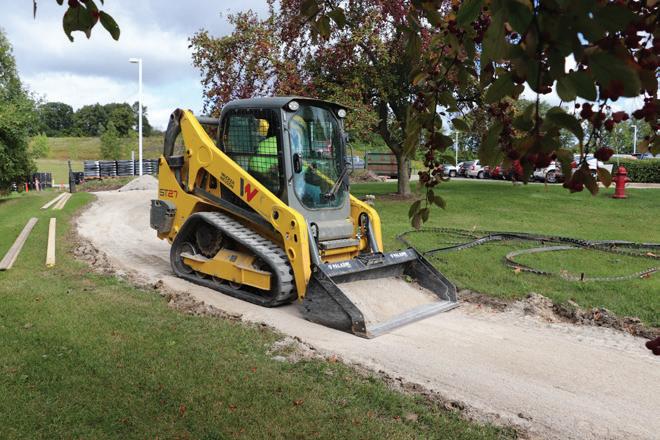
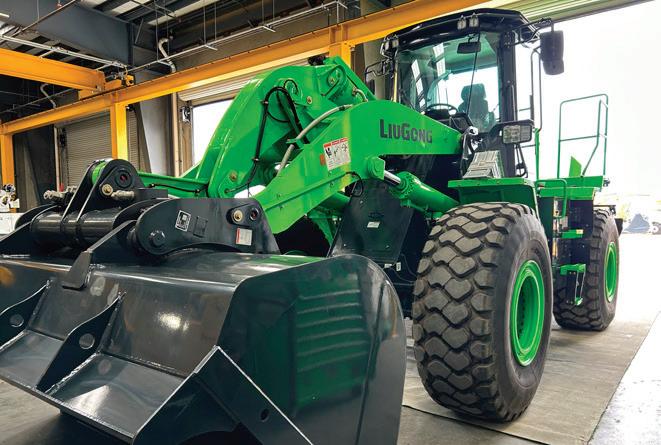
• The new machine is compatible with New Holland Construction’s 29 attachments and is enabled to operate this wide range of attachments due to its auxiliary flow rate of 15 gallons per minute.
• Thanks to its approximately 1,000-lbs. rated operating capacity (at 35 percent of tipping load) and 35 in. of working space, operators are able to power through mild structural projects, like laying footings for a small building, fence line work and irrigation or drainage tasks.
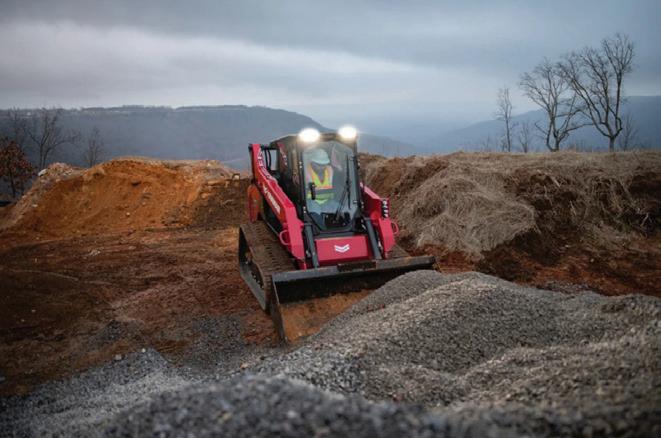
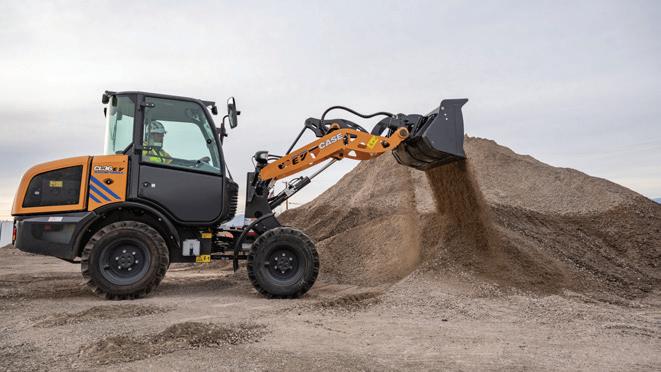
Weighing in at only 7,350 pounds, this machine is easily towable and with a Rated Operating Capacity (ROC) of 1,890 pounds (@35% of tip), it can do more than many of its heavier competitors. The ST27 comes with a 74-horsepower Kohler KDI 2504 turbocharged engine. The compact design, measuring 60-inches wide and under 80-inches in height, makes it a good fit for working in tight spaces with low overhead clearance. The design also maximizes the ROC of 1,890 pounds, while offering best-in-class reach at dump height of 36.5 inches. This extra reach at max height means it is easier to dump
material into the center of a dump box and keeps the loader farther away from the vehicle or trailer being loaded. The vertical lift, ST27 offers a hinge pin height of 120 inches and dump height of 94.3 inches. Wacker Neuson’s ST27 features a 2-speed standard travel drive that offers an impressive 9.1 miles per hour resulting in faster cycle times. Enhancing the driving experience is a standard auto-shifting twospeed drive system which can be active or disabled based on the application. It automatically senses the operators need to shift. The auto feature engages in and out of the two speeds based on joystick input and eliminates the need for the operator to make manual shifts.
Yanmar Compact Equipment launched a new line of compact track loaders at CONEXPO 2023 in Las Vegas, Nevada. The TL65RS, TL75VS, TL80VS and TL100VS are constructiongrade machines featuring the company’s performance, technology and reliability standards. Ranging from 67-hp to 103.5-hp, the new compact track loaders cover a range of customer needs. They round out Yanmar’s compact equipment lineup made up of mini excavators, compact wheel loaders and tracked carriers. The new line is designed for construction work, rental applications and more. Tier 4 Final Yanmar diesel engines offer performance in outdoor jobsites. The machines have 360-degree visibility and a standard suspended seat. A removable roof hatch escape offers a safety feature for operators. The TL100VS will start production in the spring of 2023 while the other three machines will begin production in late 2023.
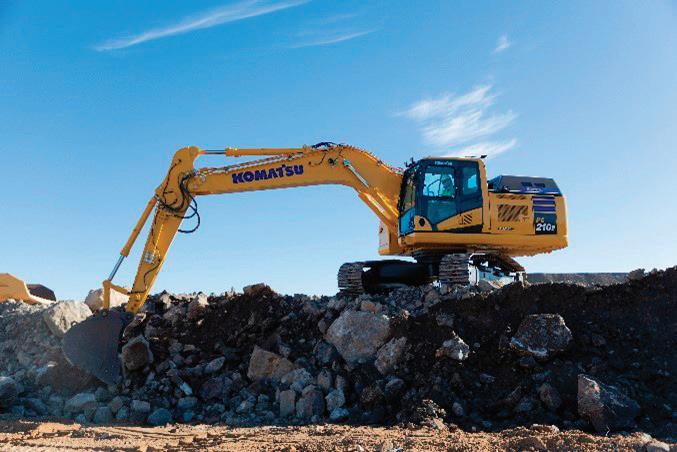


Weighing in at 270 lbs. (dry), the Boss BA870 utilizes a single-stage, hydraulic motor-driven, 8-cyl. engine that produces up to 70 cfm at 100 psi. Based on the piston air compressor BA 440, this new BA870 piston compressor is almost twice the performance but not twice the size. By putting two BOSS V4 piston compressors inline and utilizing the efficiencies of the hydraulic system, the BA870 is designed for the big jobs that require big power. At the heart of the system are two aluminum, single stage, V4, pressure and splash lubricated reciprocating air compressors. Fully assembled in the U.S., the aluminum compressor assembly offers lighter weight and higher thermal efficiency than cast iron compressor assemblies. The BA870 includes an internal oil pump for increased lubrication over that of splash lubrication only compressors. And to make life easier for you, all routine maintenance is accessible without removal of the canopy.
The Next Generation of Cat 926, 930 and 938 Wheel Loaders can be customized and equipped direct from the factory or through aftermarket upgrade kits. Target production date is Q4 2023. The models have four powertrain operating modes and Cat Payload for improved precision. Smaller cab pillars, increased window area, heated and electric rearview mirrors with lower parabolic, and standard rearview camera combine to improve operator visibility around the machine. The in-cab display delivers a view of operating parameters. Up to 50 different operating profiles can be set through the display, which the loader can recall when an operator starts the machine. Engine oil and filters and fuel filter service intervals increase to 1,000 hours.
The 3.5-cu.-yd. wheel loaders feature 33,047-lbs. (1,490 kg) of operating weight. The ZW180-7 offers either standard or high-lift front arms for bucket applications. The ZW180PL-7 features a parallel link arm configuration, and can be used in fork and tool carrier applications by keeping attachments parallel with the ground as the loader arms move up or down. Both models are powered by a 173-hp (129 kW) Cummins engine. Approach speed control and an auto power up function are available on the machine. With approach speed control, the travel speed can be adjusted with fewer pedal operations during loading. New for the ZW180-7, a payload weighing system uploads information reporting data to the ConSite telematic system. Operators can check the weight of the load in the bucket from the inside cab monitor and log the material loaded. It offers four modes — tip-off to truck, tip-off to pile, auto-add and manual-add. These modes allow the payload weighing system to manage loads according to their application. In addition, the unit is equipped with a warning function that reacts when the bucket is overloaded.
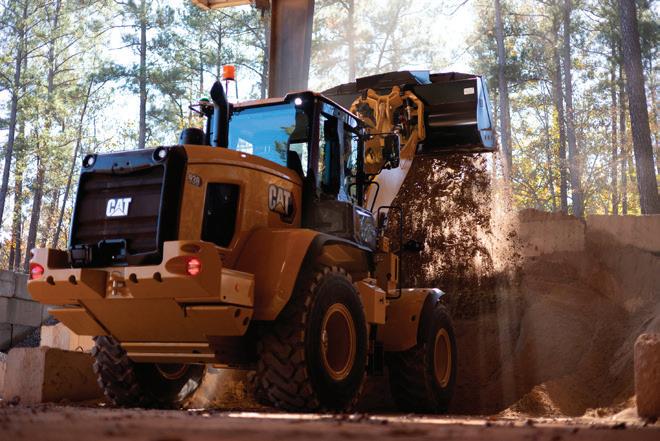
The addition of a zero-tailpipe emissions, battery-electric vehicle (BEV) to the Mack medium-duty lineup supports the company’s long-term sustainability goals. The Mack MD Electric will be available like its diesel counterpart in Class 6 and Class 7 ratings. The Class 6 model has a Gross Vehicle Weight Rating (GVWR) of 25,995-lbs., and the Class 7 model has a GVWR of 33,000-lbs. Both models are exempt from the 12 percent Federal Excise Tax (FET). The MD Electric’s three-phase Permanent Magnet Synchronous motor and all on-board accessories are powered by Nickel Manganese Cobalt (NMC) Oxide lithium-ion batteries, either in a 150 kWh or 240 kWH configuration. The MD Electric can be charged through AC or DC charging units.

The CX15EV is a 3,186-lb. mini excavator powered by a 21 hp/16 kW electric motor and the CX25EV is a 4,828-lb. mini excavator running with a 27 hp/20 kW electric motor. The lithium-ion battery featured in both machines is charged either by the 110V/220V on-board charger, or via an external rapid charger that can have the machine charged within 90 minutes, all while delivering the benefits of electrified construction equipment: no emissions, reduced noise, and less lifetime maintenance thanks to the elimination of the diesel engine. Both machines feature standard 1-way/2-way hydraulics with an electronic detent hold to reduce operator fatigue, and an optional 2nd auxiliary circuit (2-way only) can be added for more hydraulic options. The new LCD monitor allows flow settings to be set and stored for up to five attachments.
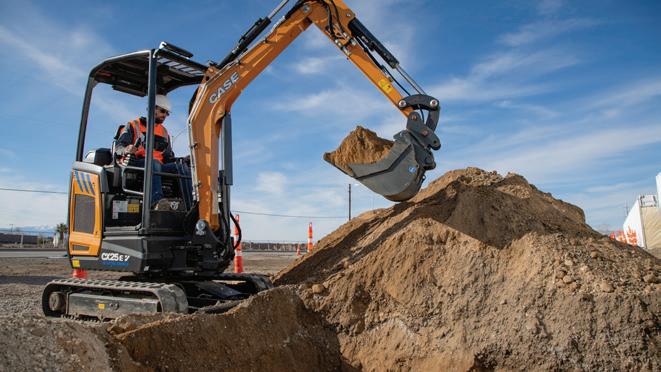

Available in 2024, the 116-hp compact track loader is the company’s first entry in this product category for the North American market. The DTL35 is on the large frame size of compact track loaders from a horsepower perspective. The compact track loader will come standard with a torsion suspension system, providing a smooth ride for operators and durability for use on jobsites. Additional stability with lifting and carrying loads is a benefit of the torsion suspension system.
• Horsepower: 116 hp (86.5 kW)
• Operating weight: 12,604
lb. (5,717 kg)
• Rated operating capacity: 3,657 lb. (1,662 kg)
Ground pressure: 5.7 psi (39.3 kPa)
• Auxiliary hydraulic flow, standard: 23 gpm (87.1 L/min.)
• Auxiliary hydraulic flow, high-flow: 40 gpm (151.4 l/min.)
Japanese-made and U.S. customized and distributed, the IC100-5 is versatile and powerful, designed for a wide range of construction applications. It features a 268-hp Cummins diesel engine to power through heavy-duty tasks, and a joystick for smooth operation and easy maneuverability in tight spaces. This 12-ton machine has a high-capacity payload of 22,000 and a low center of gravity. It is only 102 in. wide, which means it doesn’t require a wide-load permit. This crawler carrier also comes with an optional hydraulic winch. The IC100-5 is designed with both operator safety and comfort in mind. It features a spacious cab and ergonomic controls, which provides maximum visibility and ease-of-use for the operator. The carrier is also equipped with a number of safety features, including multiple camera angles and a ROPS-compliant cabin.
With a powerful Cummins engine and well-constructed componentry throughout, the XE155UCR 16 tonne excavator is designed and manufactured for a wide range of worksites: excavation, mining, loading, leveling, trenching, crushing, drilling, clamping, lifting, etc. With structural components, performance, comfortable operation and safety, the XCMG XE155UCR excavator is designed for any and every operator seeking a value machine in the 15 / 16 / 17 tonne size class.
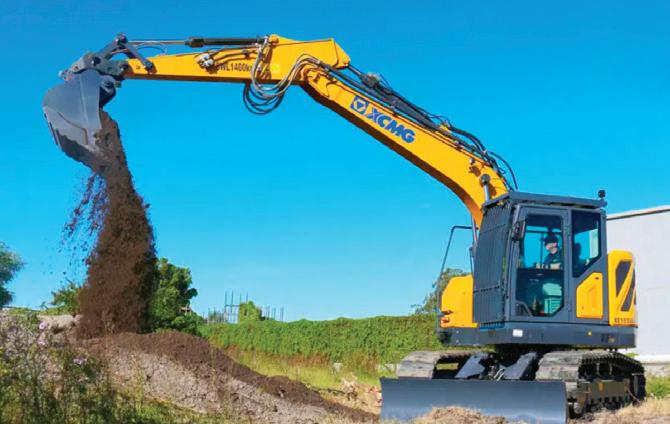
Overall width: 2,490 mm
Flow range: 2x113.4 lpm
Operational weight: 16,670 kg
Engine: Cummins B4.5
Power: 90 kW/121 hp
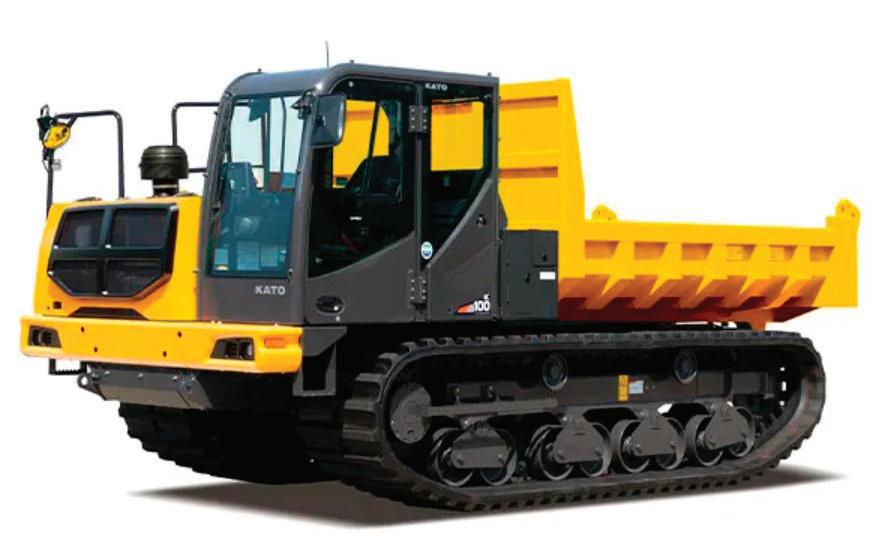
As the largest model in Hyundai’s A series wheel loader product line, the new Hyundai HL985A wheel loader offers a standard bucket capacity of 9.1-yd3 (7.0-m3) for use in highproduction jobs such as quarrying, aggregates and other mass-volume material handling applications. The HL985A wheel loader is powered by a 430-hp (320-kW) Cummins X12 Performance Series engine, delivering power and torque, while meeting Tier 4 Final and Stage 5 emissions standards. Heavy-duty ZF axles with wet outboard brakes and with coolers are standard equipment on the HL985, which is powered by a ZF 5-speed transmission. The Hyundai HL985A offers a range of standard features. For example, Smart Power Mode adjusts the engine speed in heavy-duty applications. This can help with balancing traction and breakout forces. Hyundai’s Eco Gauge function enables the operator to monitor fuel consumption in real time or to review historical data. Displayed values include engine torque, fuel efficiency, as well as average and total fuel consumed. Hourly and daily fuel consumption are also viewable through the menu.

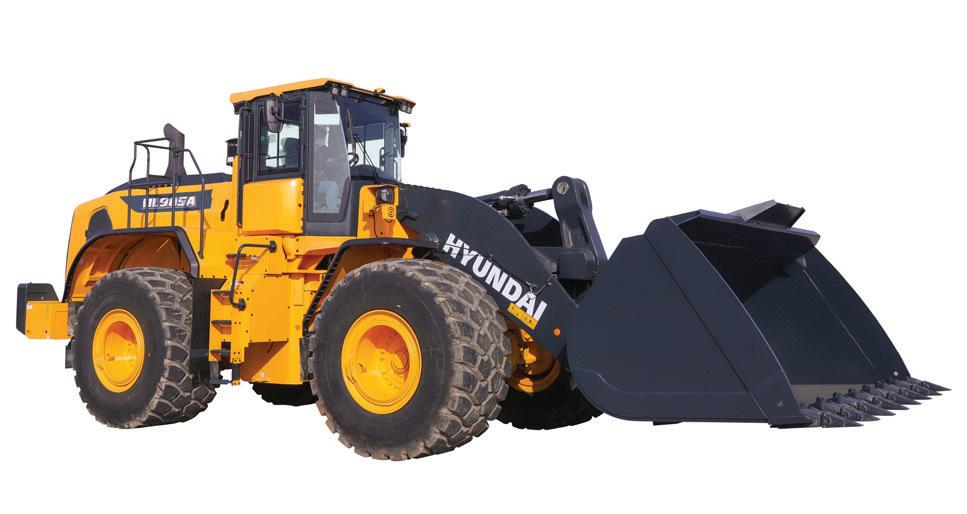
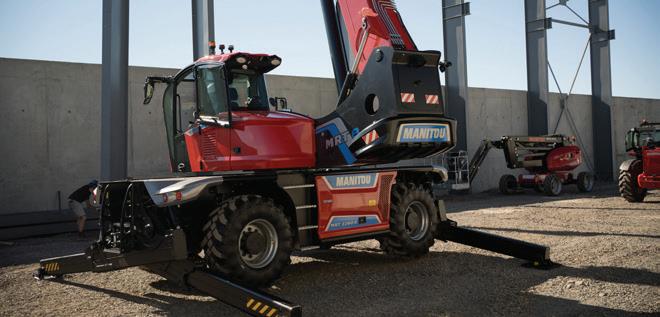
Manitou has launched a new line of electrified telehandlers to the North American market — two rotating telehandlers and a compact telehandler — all part of the manufacturer’s “Oxygen” line of low emissions equipment. The new electrified lineup includes the MRT 2260e and MRT 2660e VISION+ rotating telehandlers and the MT 625e compact electric fixed telehandler.
The MRT 2260e and the MRT 2660e are an extension of the manufacturer’s VISION+ line of rotating telehandlers — both delivering 13,200-lbs. of maximum capacity in a 100 percent electric machine. The 700V-65 kWh lithium-ion battery


The C550 55-ton hydraulic removable gooseneck construction trailer delivers more load versatility and faster turnaround times to ensure you get more out of every minute on the road or on-site. Premium QT100 steel construction and the largest deck well in the industry enable you to haul a variety of equipment with ease. These trailers are reliable, designed with long-lasting components that eliminate costly repairs and reduce the total cost of ownership. They are also backed by unmatched customer service and support. Through its collaborative product design process, Brandt has consulted extensively with customers to create heavy haul trailers that set the standard for the industry, providing versatility and reliability in a premium product offering.
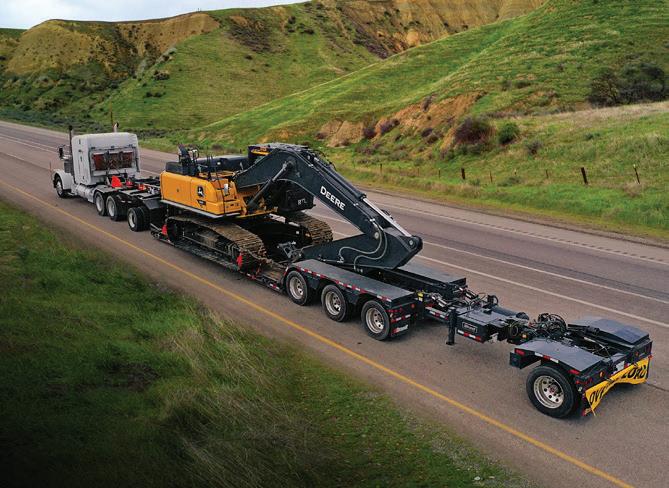
is built to sustain work in outdoor environments and an optional second battery doubles the battery capacity available for work. Charging times vary. An optional on-board fast charger can achieve charging times in less than an hour in the right conditions and an optional E-Xtra Generator delivers a hybrid experience that can be added to supplement the electric power. There is also a “plug-in” mode that allows the machine to operate while connected to the main energy supply when the stabilizers are extended.
The MT 625e is a 100 percent electric fixed compact telehandler with a maximum capacity of 5,500-lbs., max reach of 19-ft., 2-in., and a max outreach of 11-ft., 1-in. Outfit with either a 25 (standard) or 35 kWh (optional) lithiumion battery, the machine achieves a full charge in just over two hours when equipped with the optional 9 kW on-board charger (3 kW standard). Its compact size (6-ft., 4-in. tall; 5-ft., 11-in. wide; 10-ft., 10-in. turn radius) allows it to work indoors and in tight spaces while still delivering reach and capacity.









The Polaris Pro XD Mid-Size, the Pro XD Full-Size and the all-electric RANGER XP Kinetic are designed for material handling, transporting equipment and moving cargo on construction sites. Pro XD comes in full-size and mid-size versions. The Pro XD Full-Size is offered in both gas and diesel with two- and four-seat versions. It offers a payload of up to 2,075-lbs. and towing of up to 2,500lbs. The vehicle features maintenance intervals of up to 200 hours. RANGER XP Kinetic features an all-electric powertrain giving customers a sustainable option for off-road work needs while addressing the limitations of combustion fleet expansion. It has 110-hp, 140-lb.-ft. of torque and the ability to tow 2,500-lbs. and haul 1,250lbs. The RANGER XP Kinetic has a quiet electric powertrain, as well as a rigid one-piece chassis, full-body skid plate and large front bumper.











The Sullair E1035H features a number of proprietary and patent-pending features which focus on environmental responsibility and user-friendliness. The E1035H is the first to feature swing-out coolers, a patent-pending design which allows users complete access to the coolers – both front and back – enabling more thorough cleaning which helps keep the compressor running optimally. Additionally, the E1035H features unique condensate management technology which helps eliminate the need for additional equipment to dispose of condensate. Delivering equivalent power capacity and efficiency as similar-sized diesel-powered compressors, the E1035H produces 1035cfm at 150 psi, and the Sullair proprietary Electronic Spiral Valve (ESV) provides industry-leading efficiency. The E1035H also boasts added flexibility with its emissionless design allowing it to be used indoors and wherever a 60Hz power source is available. The E1035H runs exclusively on Sullube, a biodegradable, varnish-removing lubricant engineered by Sullair for performance and efficiency.

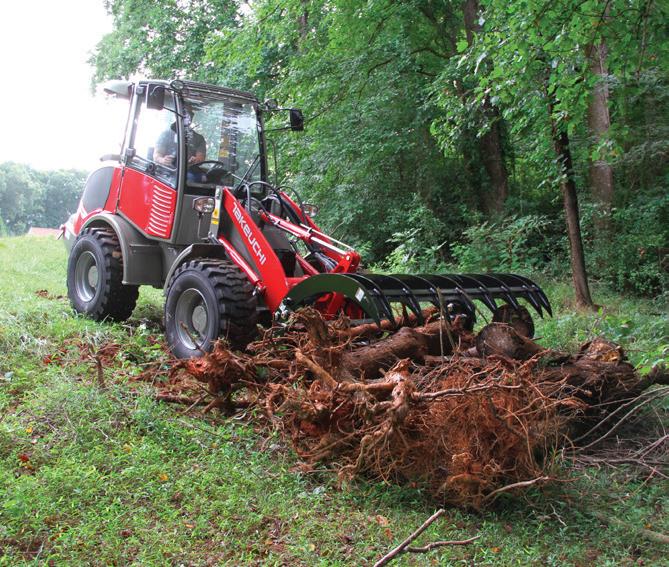

The all new redesigned KATO 9V5 mini excavator will debut summer of 2023. This ultra-mini zero tail swing excavator is a much faster and easier alternative to any shovel or wheelbarrow for working in tight spaces. With it’s ultra small size and roll down ROPS the 9V5 can even fit through doorways, standard yard gate, and even the tightest spaces making it perfect for any project. Need more stability? Standard equipment includes expandable tracks to help you power through your job with stability and ease. All new 9V5 will be available summer 2023.
Hyundai Construction Equipment Americas revealed three new models in its HX-A series of compact hydraulic excavators: the HX35AZ, HX40A and HX48AZ. All three new models feature low-emission engines that are Tier 4 Final compliant. The Hyundai HX35AZ excavator is powered by a Kubota D1703 diesel engine with a net power rating of 24.8-hp (18.2 kW), while the HX40A and HX48AZ feature Yanmar 4TNV88C engines, rated at 37.4-hp (27.5 kW). The HX35AZ has an operating weight of 8,300lbs. (3,765 kg), dig depth of 9-ft., 8-in. (2.95 m) and bucket breakout force of 7,081-lbs. (3,212 kg). The HX40A has an operating weight of 9,479-lbs. (4,300 kg), dig depth of 11-ft., 2-in. (3.4 m) and bucket breakout force of 9,846-lbs. (4,466 kg). The HX48AZ has an operating weight of 10,912-lbs. (4,950 kg), dig depth of 11-ft., 5-in. (3.5 m) and bucket breakout force of 8,223-lbs. (3,730 kg).
Capable of mulching overgrowth, underbrush and small trees, the FMX28 offers a solution for clearing land and more. Paired with 3.5- to 8-ton excavators, the compact package makes it easy to access traditionally difficult-to-reach places. The excavator-mounted FMX28 allows for precision in vegetation management, enabling the removal of a single tree in a group or even specific branches that need to be trimmed back, an ability traditional skid-steer mounted mulching heads can’t offer. Unlike competitive units which are simply shrunk down from a larger design, the FMX28 features a design purpose-built and optimized for standard flow excavators that are 3.5- to 5-tons and can operate with as little as 12 gpm, ensuring exceptional performance in demanding site clearing and mulching applications. With an overall width of 40 in. and a working width of 28 in., the attachment mounts on excavators up to 8 tons, allowing a narrow mulching cut for precision removal.

Compact and nimble, the TW60 Series 2 is well equipped to handle a wide range of jobs and attachments. A universal hydraulic skid steer coupler enables the TW60 Series 2 to utilize a wide range of skid steer attachments, and it is easily controlled from the operator’s station. The quiet and turbocharged engine is equipped with a DOC/DPF exhaust aftertreatment system and produces 61 horsepower (45.6 kW) for excellent power and performance around the job site. 100% locking differentials can be engaged at low speeds allowing the operator to work in varied terrain and extreme conditions. Daily maintenance and inspections are simple to perform on the TW60 Series 2 due to the engine hood that opens overhead providing access to key inspection points and grease points that are easily accessed on the loader and articulation points.


The Hitachi ZX130-7 and ZX160LC-7 excavators are fullsized hydraulic excavators engineered for a wide range of tasks on the jobsite. The 30,870-lb. (14,000-kg) ZX130-7 offers a maximum dig depth of 19-ft., 9-in. (6.03 m) and a bucket breakout force of 23,380-lbs. The ZX160LC-7 has an operating weight of 39,463-lbs. (17,900 kg), a maximum dig depth of 21-ft., 4-in. (6.49 m) and a bucket breakout force of 25,179-lbs. The HIOS IV hydraulic system helps minimize hydraulic loss during operation. It ensures a responsive boom, arm and bucket with intuitive control. The ZX130-7 and ZX160LC-7 feature adjustable attachment, arm and swing priority through the monitor to match machine performance with the attachment. The ZX130-7 uses a 100-net-hp (74.9 kW) Isuzu engine. A durable Yanmar engine powers the ZX160LC-7, producing 132-net-hp (98.6 kW). It features economy, power and high-power modes to match available power to the working conditions. An auto idle system with auto shut-down control prevents wasted fuel.

Apply today at BestContractorsToWorkFor.com
APPLICATION DEADLINE JULY 7, 2023
Wacker Neuson is expanding its utility track loader lineup with the launch of the SM60 and SM120, which complements the launch of the SM100 in late 2021. These stand-on utility track loaders are designed for operator comfort, ease of operation and to reduce maintenance costs and total cost of ownership. The smallest in the series is the new SM60. This unit is ideal for rental and homeowner applications. It is powered by a 26.5-horsepower Kohler Command Pro EFI gasoline engine, which is easy to start, fuel efficient and easy to service. The SM60 is designed for smaller, DIY jobs with 7.1-in. wide tracks and an overall machine width of 35.5 in. It has a rated operating capacity at 35 percent of 600 lbs., travel speed up to 3.9 mph and hinge pin height of 75.6 in. to reach into truck beds and dumpsters. Weighing in at only 2,760 lbs., this machine is easy tow. The SM60, with all its versatility is a great choice for the weekend warrior who needs to complete a to-do list. The largest in the series is the SM120, designed for the professional who needs to lift, move and place more during their landscape, tree service and site work. Powered by a 24.7 hp Yanmar diesel engine, the SM120 has a rated operating capacity at 35 percent of 1,226 lbs. and a travel speed up to 5.2 mph, providing fast cycle times. The 41-in. wide machine is equipped with 11-in. wide tracks providing ultra-low ground pressure to greatly reduce turf and soft ground disturbance, while also enhancing traction and stability for hill operation. The SM120 also features an optimized radial path design that provides vertical path performance with best-in-class hinge pin height of 85.6 in., which allows for dumping into high-sided trailers, truck beds and dumpers.

The VMAC DTM185 air compressor is a directtransmission mounted PTO driven air compressor that delivers 185 CFM. The DTM185 was designed and engineered by VMAC to meet the demand for a powerful vehicle integrated air compressor for charging gas lines, fixing potholes, installing fiber optics, and breaking up concrete. This system has enough air to power two 90 lb. jackhammers at 100% duty cycle, or one jackhammer at PTO idle.
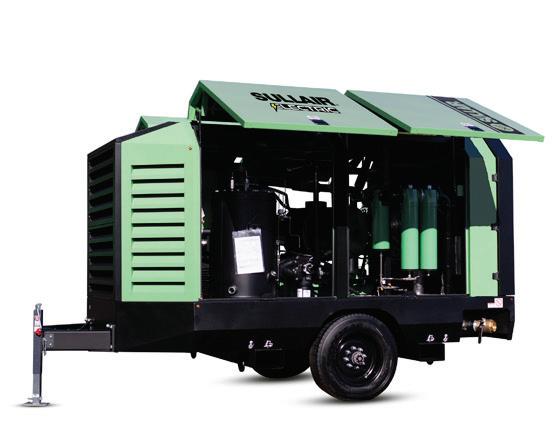
Apply for a chance to be acknowledged as an exceptional employer that demonstrates people are their most important asset.



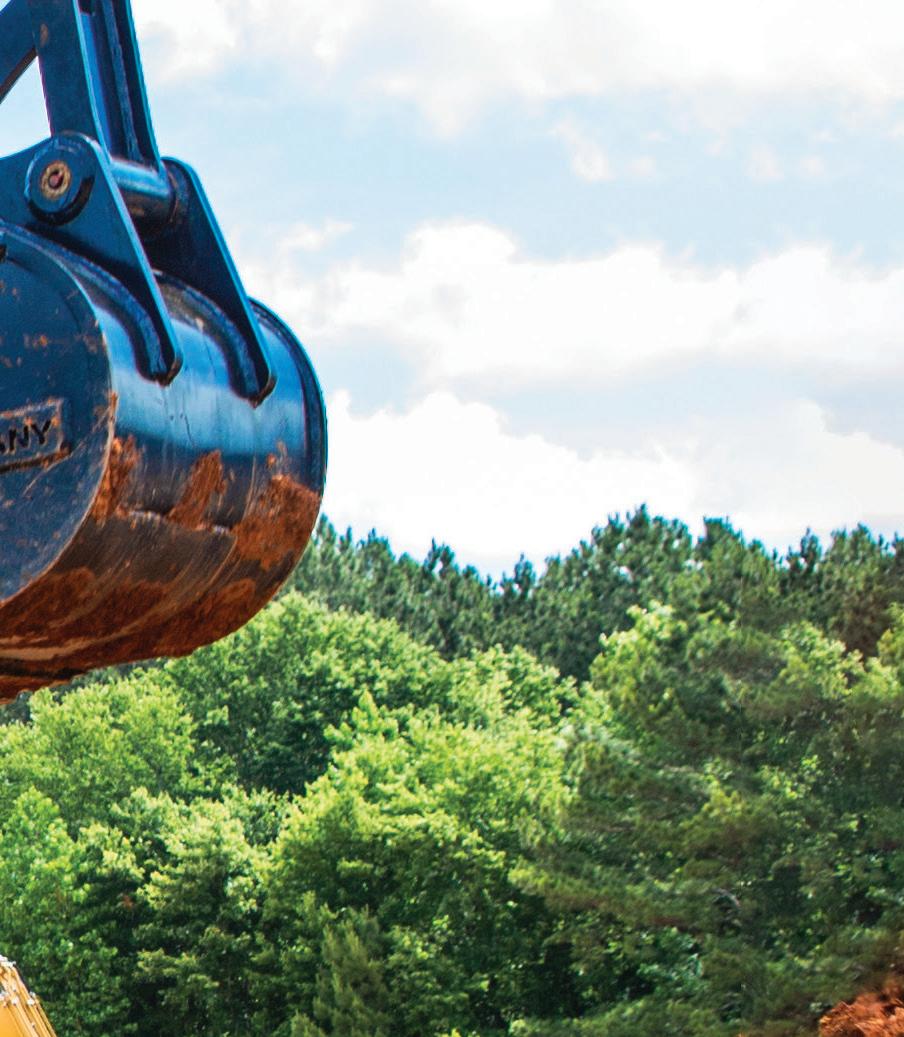

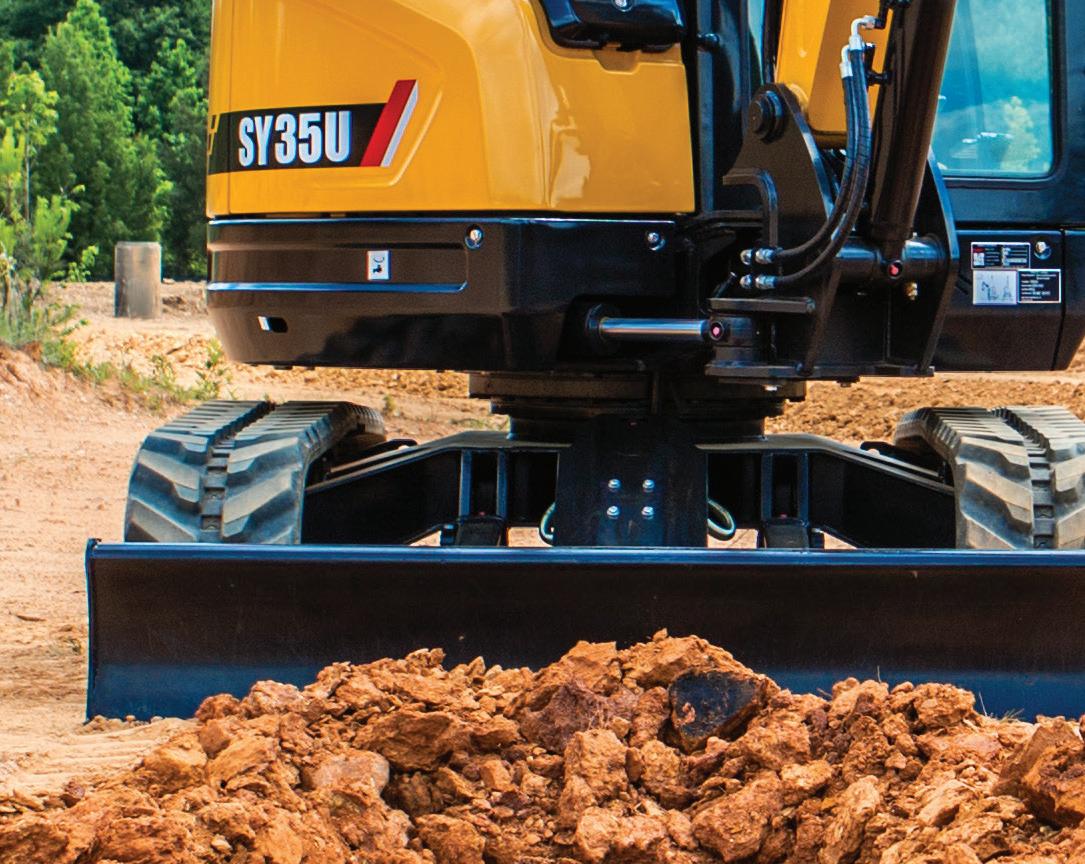
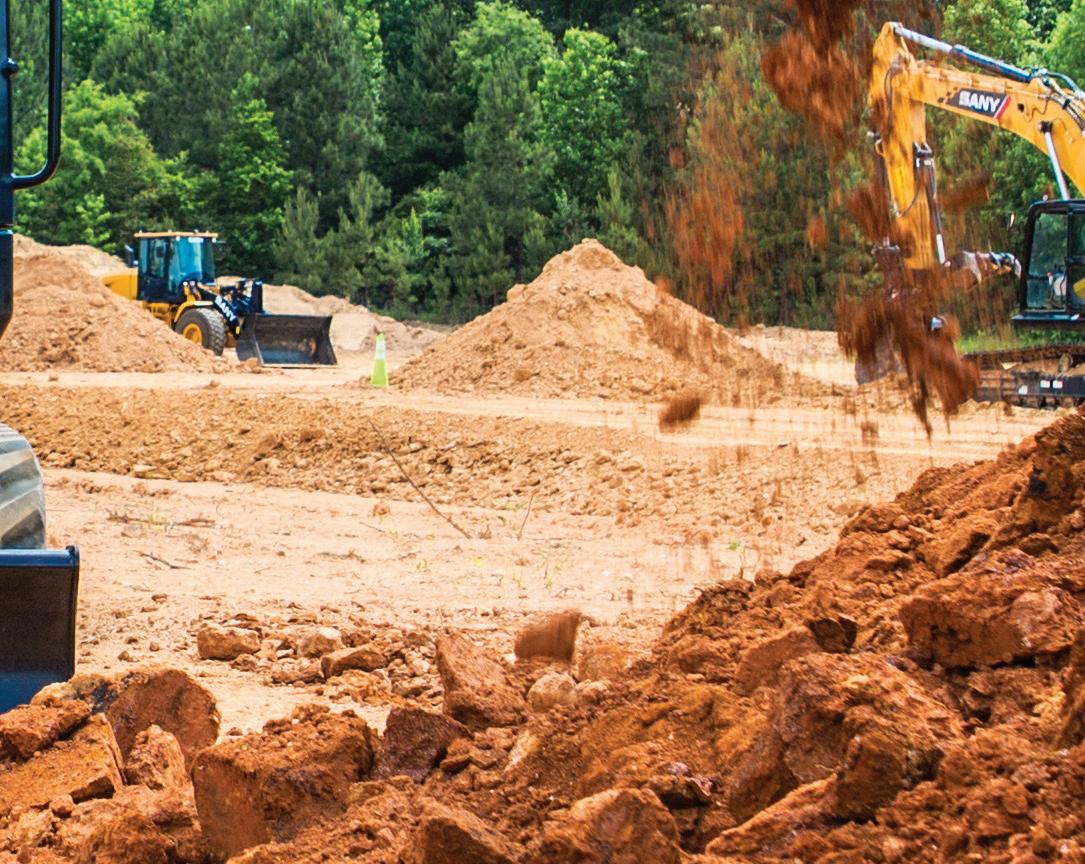
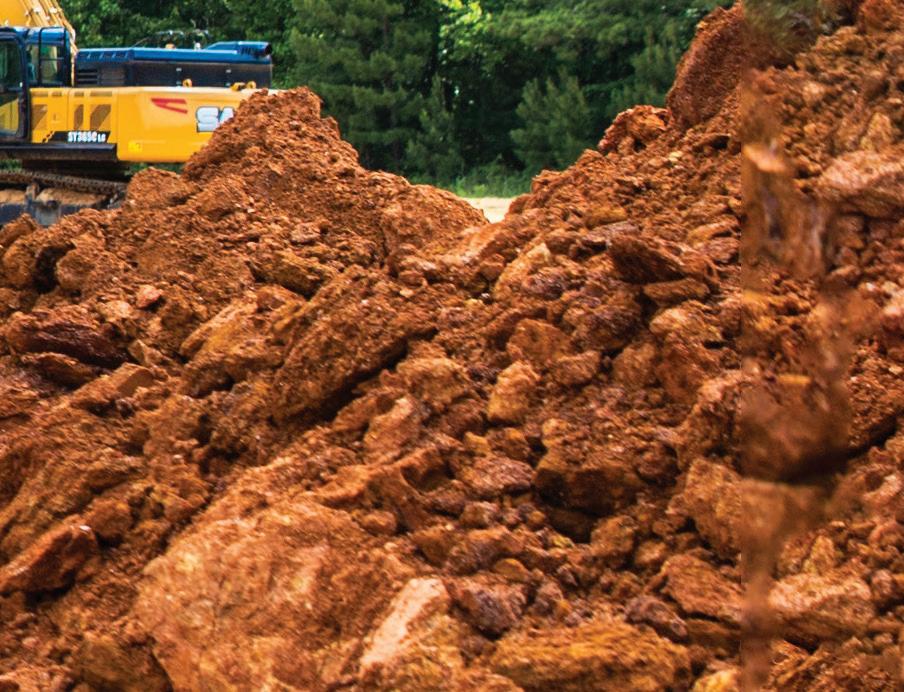


















Manufacturers have spent years honing technology to allow contractors to do more with less and find ways to complete projects more effectively and with fewer emissions.
Whether you attended Work Truck Week in Indianapolis or CONEXPO-CON/AGG & IFPE 2023 (CONEXPO) in Las Vegas in March, or stayed home and followed show updates from your smartphone, one thing was abundantly clear: this year’s construction industry tradeshow
season did not disappoint. Per usual, CONEXPO, North America’s largest construction heavy equipment exhibition was brimming with innovation throughout the 3 million square feet of show space.
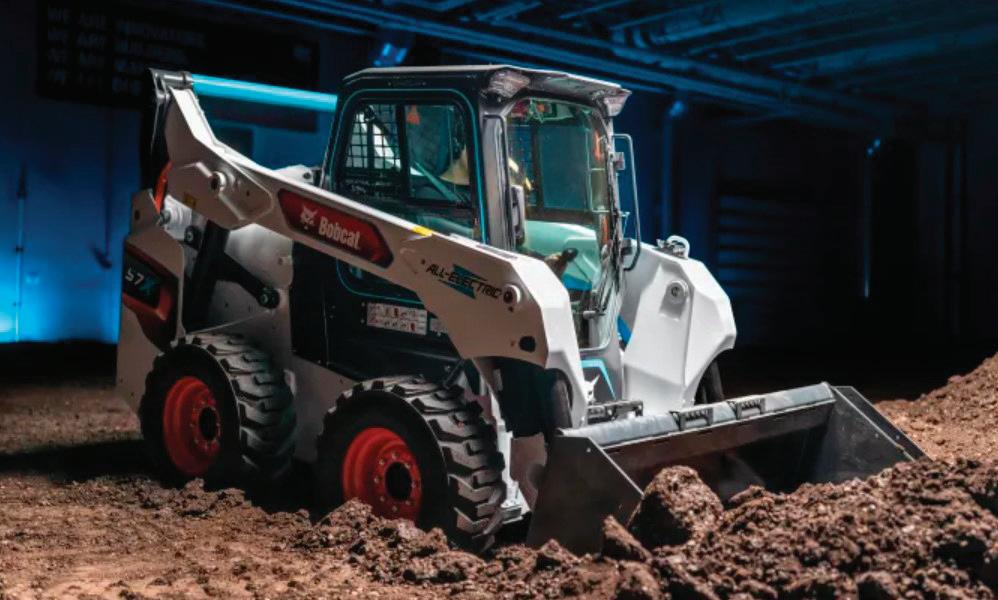
The nearly 140,000 industry professionals who ventured to the record-attendance tradeshow were
able to network with peers, see new and updated heavy equipment, view demonstrations of the latest innovations and hear the latest business developments from their favorite manufacturers.
Specifically, industry-wide themes at CONEXPO included topics such as new product development, artificial

intelligence and automation, new power sources and technological advances in fuel efficiency, productivity and safety. Manufacturers have spent years honing technology to allow contractors to do more with less, to more quickly train new workers and to find ways for construction companies to complete projects more effectively and with fewer emissions.
Construction heavy equipment is our passion at Equipment Today, so naturally, we took our entire team with us to the show to cover it as thoroughly as possible. Throughout the pages of this issue (and upcoming magazines issues, as well), we’ve highlighted some of the trends and more than 100 products from CONEXPO. Many manufacturers gave booth tours and product walkarounds, which we filmed on video and recorded for podcasts and wrote several articles about – all of which can be found on our website, ForConstructionPros.com.
There is so much news and updates to share with you about CONEXPO, it’s challenging to summarize it all in one place. Here, we chose to focus on some of the world’s largest construction heavy equipment manufacturers and what they shared with us at the show. Many discussed new technologies they’ve integrated into their machines and ways to lower emissions. There were several announcements about continued business expansion throughout North America and improvements to the equipment supply chain. In this issue, we focus on wheel loaders, while in May, you’ll see more compact track loader coverage and in June: excavators.
The world’s largest construction heavy equipment manufacturer had one of the largest outdoor demonstration areas during the show, at 70,000 square feet, where attendees flocked to see more than 30 new machines, watch the Global Operator Challenge Finals and visit the company’s Services, Technology and Sustainability hubs. The company exhibited many new technologies designed to improve uptime and keep costs down. The Cat Command for Loading remote control system for its small wheel loader line was one of the many technologies demonstrated at the show. Cat also unveiled its 950 and 962 Next Generation Wheel Loaders that aim to increase productivity 10% while meeting U.S. Tier 4 Final emissions
standards. Meanwhile, Cat Payload is more widely available, as it now comes standard on the 926, 930 and 938 nextgen wheel loaders.


There are new options for the Cat Smart Grader Blade and Smart Dozer Blade. The new external control kit for GB120 and GB124 smart grader blades expands the use of these blades to Cat D and D2 series SSL and CTL machines, allowing customers with previous model fleets to run smart blades. The new 3D grade control kit uses existing connections to add automatic blade
control to the Cat Smart Dozer Blade. The new external control kit allows operators to run smart grader blades on all D-series and select older Cat machines and includes a third joystick for operating blade raise/lower, tilt, angle and wing functions like smart control for D3 series machines. Cat also showcased new mobile apps: Cat Central that can help locate replacement parts and manuals. The SIS2GO app helps users with maintaining, troubleshooting and repairing Cat equipment. The VisionLink app helps
simplify fleet management accounts for contractors, offering asset tracking and more.
At its Sustainability Hub, Cat exhibited four battery-electric machine prototypes: the Cat 301.9 mini excavator, 320 medium excavator, 950 GC medium wheel loader and 906 compact wheel loader, including AC and DC charging solutions. The Caterpillar-designed batteries are built on lithium-ion Cat technology with a modular design that offers
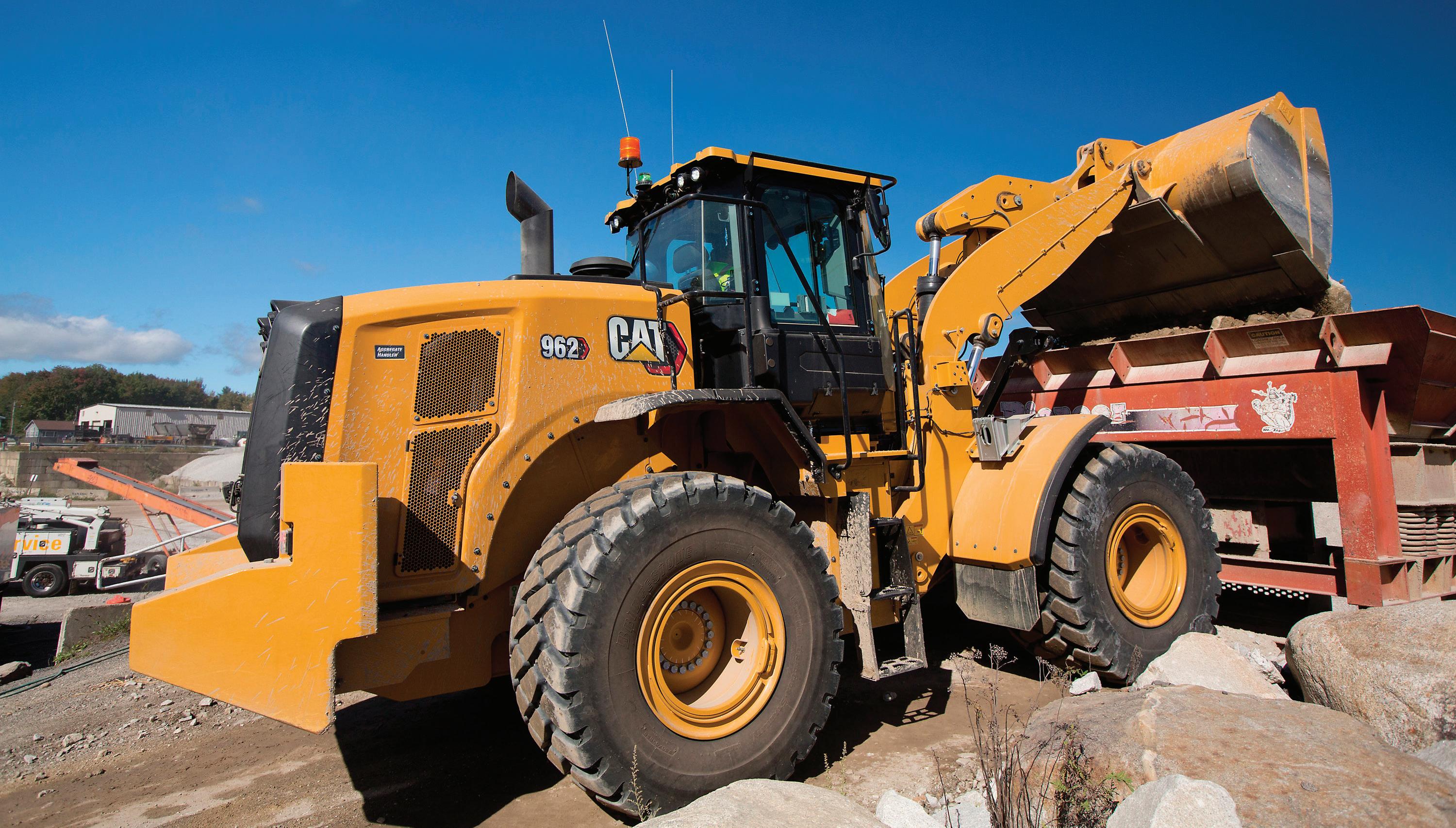
flexible configurations across multiple applications.

To showcase the capabilities of its Cat Remanufacturing services, the company exhibited a rebuilt dozer with a remanufactured engine at its CONEXPO exhibit.
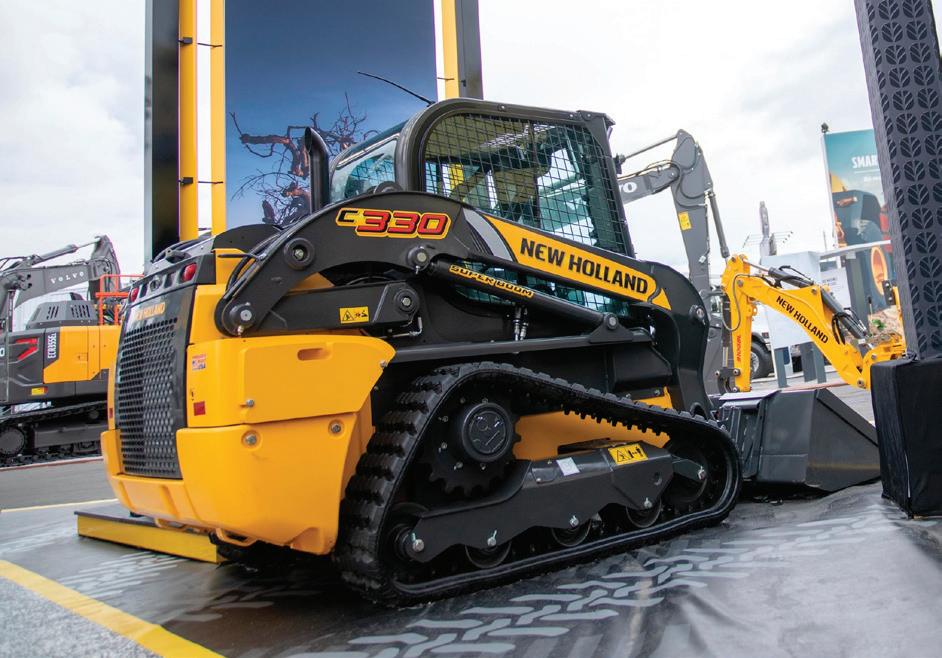
“At Caterpillar, our machines are built to rebuild,” said Brian Edwards, a senior vice president of Caterpillar who oversees the Cat Remanufacturing Division. “So we design with the purpose of providing multiple lives (for equipment). Not only does that allow them to really maximize their investment, but we focus on the total cost of ownership. We’re constantly trying to provide valuable solutions that lead them to lower their cost of operating every day.”
Another big hit at the Cat booth was the 6-cylinder Cat C13D engine platform, which will offer eight power ratings from 456 horsepower (hp) to 690 hp—340 kilowatts (kW) to 515 kW with up to 3,200 Newton meters of peak torque. Enginemounted aftertreatment and cooling packs will be available from the factory to reduce installation and validation costs. The C13D will meet the emissions standards of higher regulated markets, such as EU Stage V, U.S. EPA Tier 4 Final, China Non-road IV, Korea Stage V, and Japan 2014, with models available for lesser regulated markets, said Dustin Childers, global marketing manager, Caterpillar Industrial Power Systems Division.
CASE
CASE Construction Equipment also unveiled more than 30 new machines, including new attachments, technology and more. CASE spotlighted its backhoe loaders, which have been outfitted with new configurations and abilities. Among them, the industry’s first electric backhoe loader, the 580 EV. The machine promises to need less maintenance and emit less noise and emissions than its traditional counterparts.
The company also featured its TV620B compact track loader, one of the largest in the industry, with a 114-hp engine and a 6,200-lb. rated operating capacity. Its heavy-duty undercarriage and heavy-duty 17.7in. rubber tracks allow for 6.1-psi ground pressure and performance on improved surfaces.
The 3.6 metric ton electric CL36 EV compact wheel loader also made an appearance. Designed to include the benefits of electrification with a small footprint, the machine can be used indoors and outdoors.
67-hp engine, features the super boom design, New Holland Construction’s Super Boom lift, with low shoulder positioning and small towers to enhance operator visibility and worker safety on the jobsite.
“The C330 vertical lift compact track loader creates the perfect mix of job versatility and maneuverability on any residential construction and landscape jobsite,” said Ryan Anderson, product marketing manager for New Holland Construction North America. “We can’t wait to get this machine out into the field to showcase how our power management technology and enhanced visibility to get the job done more efficiently performs.”
New Holland also displayed its new D Series backhoe loader, economy-class B75D backhoe loader, C314 mini track loader and E15X electric power mini excavator.
Cummins
our customers and the important jobs they need to do every time.”

The company is pursuing development of engines that will use diesel, natural gas, gasoline and propane, as well as other sources.
John Deere
Another one of the largest exhibitors at CONEXPO-CON/AGG, with 80,000 square feet of exhibit space, John Deere hosted a large outdoor area with a variety of equipment on hand. Of that space, 10,000 square feet was dedicated to Deere technologies, including SmartGrade and SmartDetect systems.
“Over the last couple of years, we’ve introduced a lot of new features, specifically with wheel loaders, when it relates to better visibility on the jobsite and better safety features,” said Luke Gribble, solutions marketing manager for John Deere.
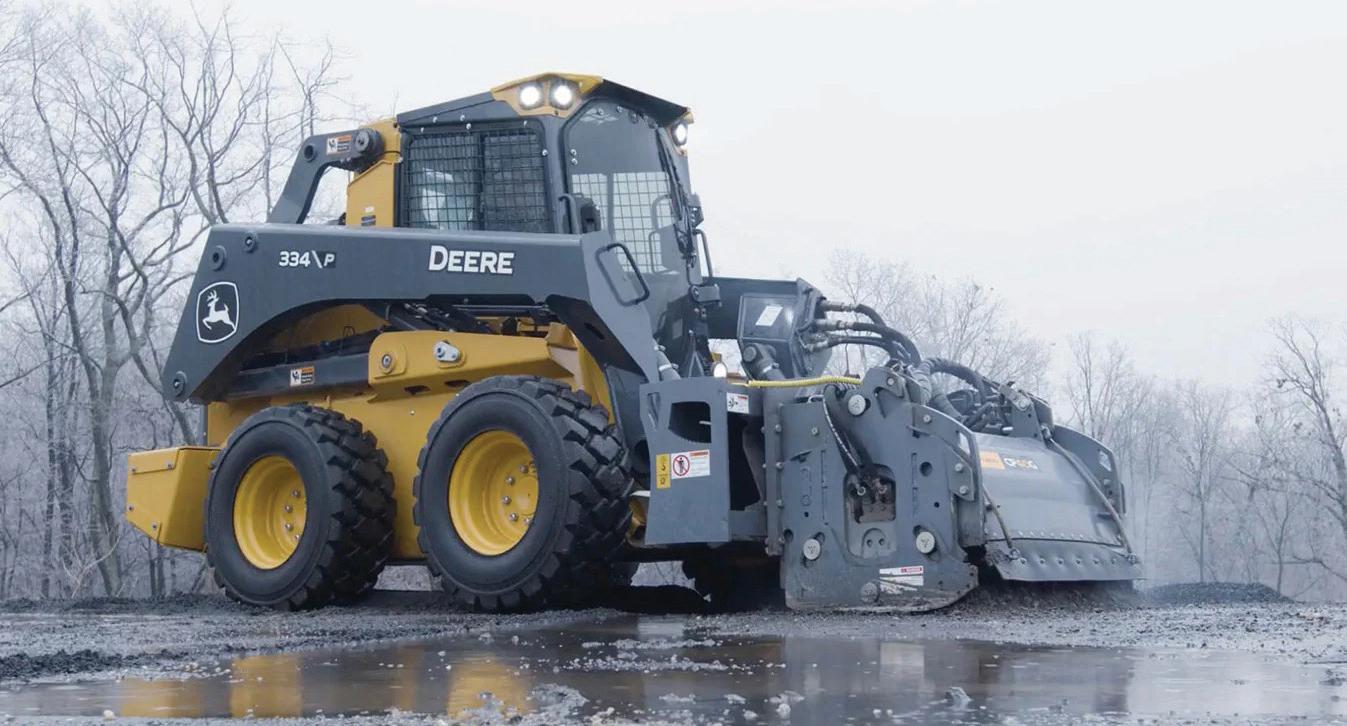
“CASE is building on an enviable, 180-year heritage of making a difference in our industry and the world,” says Terry Dolan, vice president — North America, CASE Construction Equipment. “The past three years have led us to the next chapter in our evolution, focused on one goal: to help customers get more work done, easier and more profitably than ever before. We are committed to the promise that no one will outwork us in earning customers’ trust and helping their businesses thrive.”
CASE’s parent company, CNH Industrial, recently acquired Sampierana, to boost CASE’s miniexcavator lineup. CNH also signed an agreement with Tobroco-Giant for sales, distribution and support of CASE small articulated loaders.
CASE has also expanded its CASE SiteConnect Module and launch new programs like CASE TrackCare, an undercarriage monitoring program for the lifecycle care of steel undercarriages.
Also owned by CNH Industrial, New Holland Construction had several CONEXPO-CON/AGG product launches of its own. One of the more popular launches was the C330 Vertical Lift Compact Track Loader, with its compact, medium-sized frame. The C330 vertical lift compact track loader, with 68-inch working width and
Of note is recent announcements made by engine manufacturer Cummins. At Work Truck Week in March, the company announced the launch of its zero-emissions brand, Accelera. A business segment of Cummins, Accelera will serve as a components supplier and will focus on batteries, hydrogen fuel cells, e-axles, traction drive and electrolyzers. Accelera currently has operations in North America, across Europe and in China, with additional joint ventures that operate in the Netherlands and China.
Cummins also recently announced its X10 diesel engine that will be available in 2026, when it will be compliant with the U.S. Environmental Protection Agency’s 2027 emissions regulations.
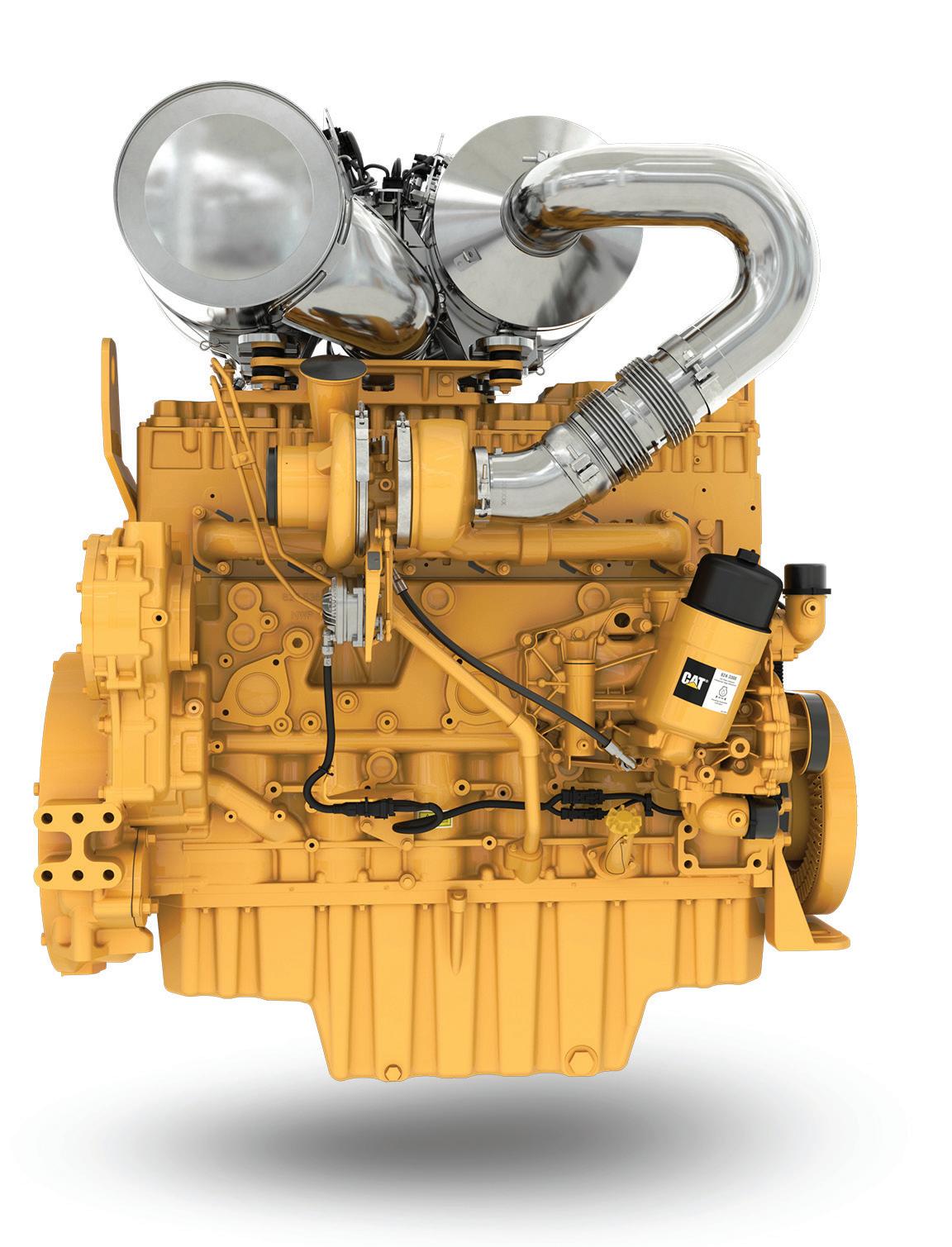
SmartDetect uses a camera system with object detection technology, which can discern people from objects. The machine can even automatically slow down when objects enter its path.
Meanwhile, SmartWeigh, which is available on P- and X-Tier utility wheel loaders, is a payload weighing system that helps operators hit loading targets and minimize material loss.
Overall, Deere unveiled 36 products at the show. One of the highlights was the debut of its new P-tier construction machines, including dozers, skid steers, cold planers, excavators and more. The machines include upgradable technology and improved operator comfort and cab functionality. With EZ Grade in base models with EH controls, as well as optional slope control and 2D laser capabilities, the 450, 550 and 650 P-Tier machines have many technologies available.
“We are committed to advancing diesel technology while our markets and our customers need it to run their businesses. The new X10 has been designed drawing on our decades of experience as a leader in the medium and heavy-duty space,” said José Samperio, executive director, North America On-Highway at Cummins Inc. “We have applied those learnings to ensure the product will perform for
All models are compatible with laser receivers, helping control elevation and slope while using a rotating laser. The P-Tier small dozers with EH controls arrive from the factory with EZ Grade features, however, the owner can upgrade to Slope Control or SmartGrade technology in the future,. As an additional feature, the new 8-in. touchscreen cab display offers
navigation of slope control and machine settings on EH machines.
DEVELON
Formerly known as Doosan, DEVELON celebrated the launch of several new machines at CONEXPO with a ribbon cutting on the first day of the tradeshow. At that event, parent company Hyundai Doosan Infracore CEO Young-cheul Cho said it was DEVELON’s goal to become a top five heavy equipment manufacturer for the North American market by 2025. He said the company has plans to improve its performance in the compact equipment segment and grow its dealer network.
“This shows our commitment to North American customers,” Cho said.


The company has launched a mini excavator and a compact track loader in the North American market and has plans to add a small dozer to the lineup soon. Plans are also in the works to add electric versions of the machines.
The company announced several new products and upgrades to existing machines at the show. One of the product launches was the 116-horsepower DTL35 compact track loader, the company’s first entry in this product category for the North American construction market.
An existing machine, the DL3207 wheel loader, which is part of the next-generation 7 Series lineup, for example, received upgrades such as increased bucket capacity, redesigned cab with comfort improvements and fuel-saving technologies. The improved cooling system features wider radiator fin spacing and a reversible fan to clear debris and reduce clogging. The wider front fender also offers better windshield protection.
Bobcat
A member of the Doosan Group, Bobcat showcased two concept machines at CONEXPO.
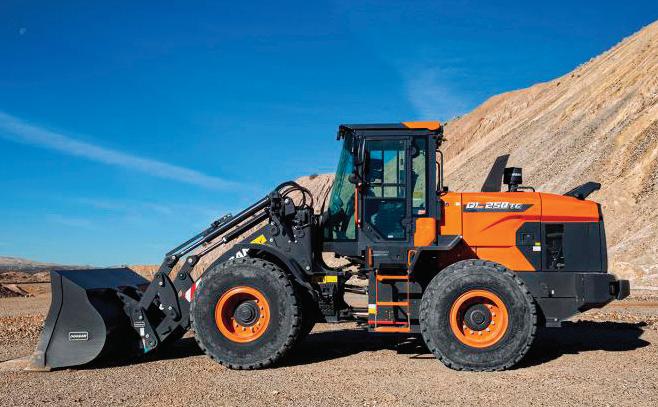
The Bobcat T7X is the first allelectric compact track loader and the S7X electric skid steer loader. The S7X is powered by a 60.5-kWh, lithium-ion battery, features electric drive motors and utilizes ball screw actuators for lift and tilt functions. It can operate for eight hours and takes 10 hours for a full charge.
Bobcat launched its RogueX track loader at the show. The machine was
designed with remote operations and autonomous functionality in mind.
"We challenge what's possible, break new ground and empower people to do more," Doosan Bobcat North American President Mike Ballweber said.
Hitachi Construction Machinery Americas
Several new and improved machines were rolled out by Hitachi Construction Machinery Americas at the show, including excavators and wheel loaders.
The 33,047 pound, 3.5 cubic-yard Hitachi ZW180-7 and ZW180PL-7 wheel loaders offer standard or high-lift front arms. The ZW180PL-7 specifically has a parallel link arm configuration for fork and tool carrier applications.
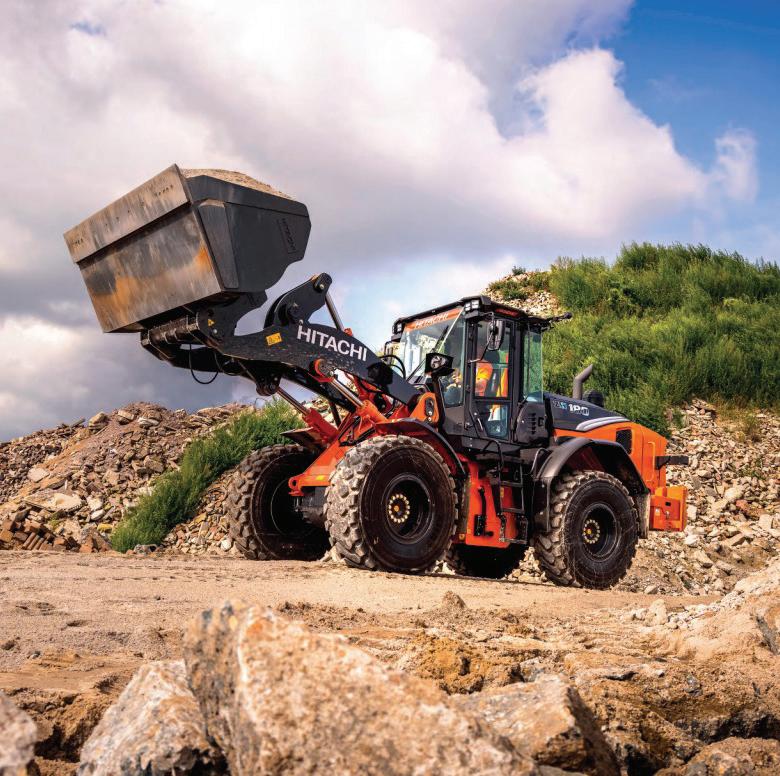
“With the three front linkage options, these wheel loaders offer the versatility to handle any application, whether the loader is used to move pallets around the yard, load materials into trucks or manage stockpiles,” said Matt Koester, wheel loader product manager for Hitachi.
At its 31,000 square foot exhibit at CONEXPO, Hyundai Construction Equipment Americas displayed and demonstrated a variety of compact excavators, skid steers, compact track loaders and wheel loaders.
The three compact excavators at the show included the HX35AZ, HX40A and HX48AZ, which comply to Tier 4 Final emissions standards and have increased cab visibility and a number of operator comfort features.
The new Hyundai HL985A wheel loader, with a bucket capacity of 9.1-yd3 is designed for use in highproduction jobs such as quarrying, aggregates and other mass-volume material handling applications.
“We refer to the HL985A as a ‘true two-pass’ wheel loader because it can fill one of our HA30 articulated dump trucks with two bucket loads,” said Joe Turnage, Senior Product Manager, Hyundai Construction Equipment Americas. “With the addition of the HL985A, the Hyundai wheel loader line includes models that fulfill the needs of every important wheel loader application. At the same time, like every A Series wheel loader model, the new Hyundai HL985A provides the combination of power, performance, fuel efficiency, and operator safety and comfort that successful contractors expect from Hyundai.”
Jennifer Rumsey, president and chief executive officer of Cummins, gave the keynote address at the Green Truck Summit on Tuesday, March 7, highlighting her expansive industry knowledge and providing thoughtful analysis of what she deemed, “the messy middle,” or the time before complete decarbonization occurs in the on-highway trucking industry. Be sure to listen to OEM Off-Highway's exclusive interview with Rumsey here.
At the semi-annual work truck industry 2023 economic overview with NTEA director of market data and research Stephen Latin-Kasper, Kasper shared statistics on the United States’ and Canada’s current economic activity, including truck manufacturer production, orders, housing starts and inflation.
The NTEA research demonstrated that a small but likely quick recession may occur in the second half of 2023, but consumer spending is still well above typical recession time expenditures. And Kasper said, "we are expecting that [consumer expenditure] to continue growing."
"So, in '23, in all of these big segments of the industry, is expected to be a reasonably good year for sales," Kasper said of the commercial vehicle market. "The primary limiting factor is going to continue to be the availability."
Both Isuzu and Mack launched medium-duty electric trucks at Work Truck Week, on the heels of Navistar International's medium-duty electric truck launch in 2022. The Isuzu N-Series EV is the first electric truck from Isuzu to be introduced in the US market. It has a 19,500-lb. gross vehicle weight rating and will use 20 kWh lithium-ion battery packs in configuration options of three, five, seven or nine battery packs. Isuzu leadership predicts the truck will be available for purchase in early 2024. Its all new cab will be featured in the entire Isuzu lineup in 2024 and 2025.
"The charging infrastructure has grown considerably over the last several years. We have customers that are moving toward carbon neutrality and state and federal programs will reward early adopters," said Shaun Skinner, president and CEO of Isuzu Commercial Truck of America and Isuzu Commercial Truck of Canada. "We're ready for a future with multiple powertrain offerings. Gas, diesel and electric. And that means more power for our customer to choose the perfect truck for their needs."
The new Mack MD Electric will be available, like its diesel counterpart, in Class 6 and Class 7 ratings. The Class 6 model has a gross vehicle weight rating (GVWR) of 25,995 pounds, and the Class 7 model has a GVWR of 33,000 pounds. The MD Electric’s three-phase permanent magnet synchronous motor and all on-board accessories are powered by nickel manganese cobalt (NMC) oxide lithium-ion batteries, either in a 150 kWh or 240 kWH configuration. The MD Electric can be charged through AC or DC charging units.
Both Ford Pro and Ram launched new all-electric vehicles loaded with features. The new Ford Pro electric model is an all-electric school bus, an ideal EV because of its cyclical routes and ability to return to a home base for charging every day.
Ram estimates that its new electric pickup will be available by late 2023. However, this may be ambitious, given the persisting supply chain difficulties and tight labor market that Kasper referenced in his NTEA work truck industry economic overview, but we will see what happens later in the year.
Read more of this article at ForConstructionPros.com.
AC
Editors
Read more at: https://eqtoday.co/sf8h6q
There is no doubt about it. Reliability is critical for wheel loader owners. And, over the years, traditional wheel loaders have proven to be highly reliable, day after day, year after year.
It is no surprise then that manufacturers like John Deere continue to offer a variety of traditional wheel loaders in its lineup. In fact, a majority of its wheel loaders are considered traditional. And they provide operators several performance features that, simply put, enable them to be highly capable for practically any application.
Yet, despite some customers’ hesitancy to explore hybrid style wheel loaders, as they’re afraid of replacing their longstanding, reliable machines, John Deere is certainly not afraid to think outside of the box, as it’s looking ahead to the future. And the future — without question — is wheel loaders powered by alternative fuels.
Alternative fuel-powered wheel loaders are definitely not “new” or unproven in the field either, as several have been in the marketplace for years. One such example is John Deere’s E-drive loaders, particularly its 644 X-Tier and 944 X-Tier, each of which is hybrid powered.
“If customers are on the fence between purchasing a traditionally powered wheel loader and a hybrid-powered wheel loader, they should know that John Deere’s E-drive loaders have accumulated more than 3 million field hours between them,” said Luke Gribble,
solutions marketing manager, John Deere. “The 944 X-Tier is even backed by an eight-year, 20,000-hour electric drive component warranty that covers its electric drive components. An annual inspection, conducted by a certified dealer technician, is required though.”
Aside from its high aggregate of field hours and its electric drive component warranty, the 944 X-Tier — along with the 644 X-Tier, in fact — provides the same productivity benefits (if not better) that conventional drive train machines do. And each of the E-drive wheel loaders burn less fuel than traditional wheel loaders. Not to mention, E-drive wheel loaders have various features and modes that are offered exclusively by them, leading to fuel efficiency gains within a wide array of jobsite applications.
“One of these features is coast control, which enables each wheel loader’s dynamic braking to automatically slow

it down whenever an operator’s foot is removed from the throttle pedal,” Gribble explained. “Due to this feature, fuel consumption will decline, while each wheel loader’s service brakes’ lifespans will increase.”
He added, “Three setting levels will allow operators to adjust the aggressiveness of machine deceleration while using electric brake resistors. When enabled, one pedal will control each wheel loader’s forward movement and dynamic braking.”
In addition, the 944 X-Tier has an exclusive feature that automatically limits torque to any of its wheels whenever slippage occurs: traction control. As a result, the potential for runaway wheel spin is not only eliminated, but tires’ lifespans will increase as well. Although operators can establish just how aggressive their wheel loader’s traction control is, the feature is actually automatic, so it doesn’t
CASE Construction Equipment



require any operator input whatsoever as the wheel loader is in operation.
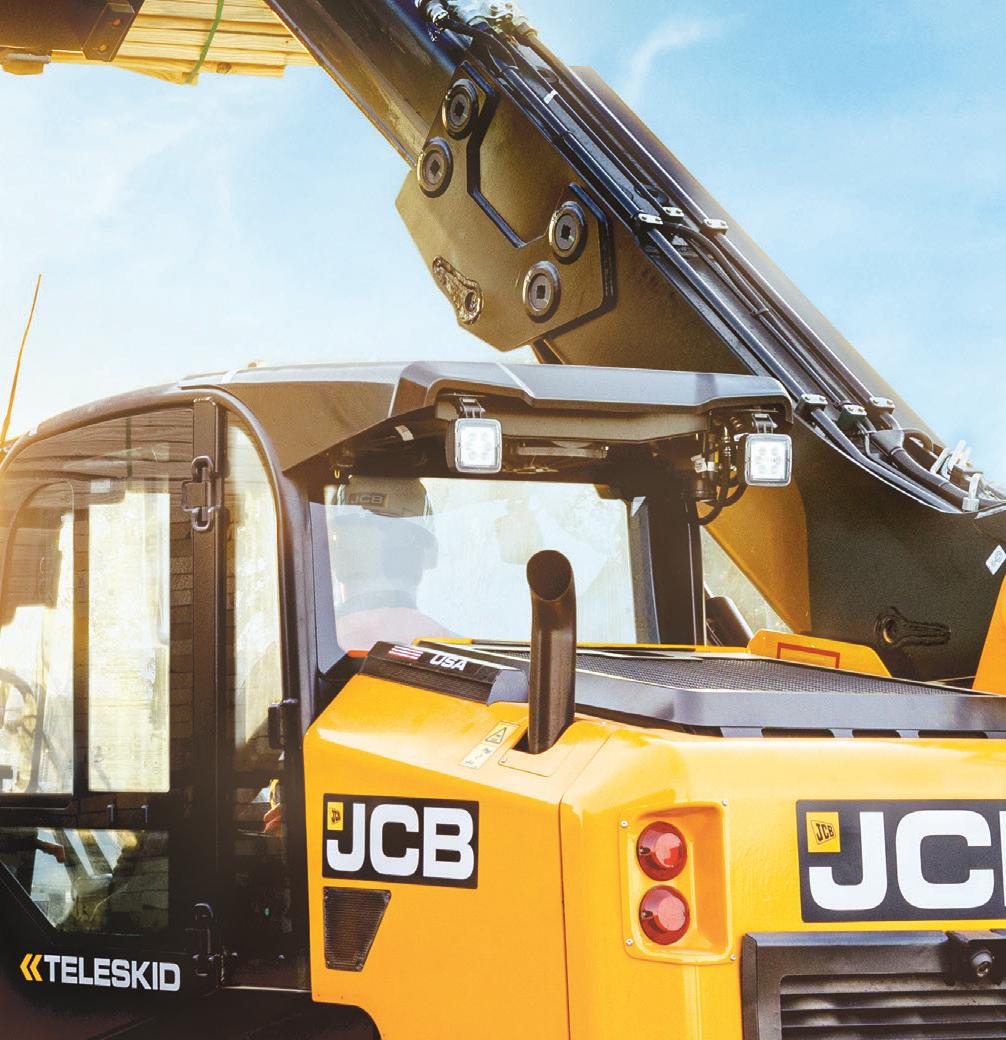



“Both of these machine’s systems offer high performance, longevity and operation ease,” Gribble stressed. “The machines will also help jobsites lower their carbon emissions, as they’ll burn less fuel, use their tires for a longer time period and decrease the volume of fuels and oil they need, when compared to traditional wheel loaders.”
Furthermore, the 944 X-Tier features an electric drivetrain that has a John Deere 13.5L engine, a gearbox, two 3-phase Alternating Current (AC) permanent magnet generators and
power electronics or inverters. Its electric drivetrain also has four 3-phase AC Switched Reluctance (SR) motors, along with four 2-stage reduction final drives and two brake resistors.
“The John Deere 13.5L engine — which operates at either a limited engine speed range or at constant

speed, like a generator set — connects to a gearbox, which houses the hydraulic pumps,” Gribble said. “From there, the gearbox will then transfer engine power to the electric generators and hydraulic pumps.”
Afterwards, the electric generators will convert rotational energy from the
engine into 3-phase alternating current (AC) electrical energy. The power electronics or inverter will deliver the electrical energy from the generators to the electric motors, based on operators’ demands. And then the electrical motors will convert the 3-phase AC

back to rotational energy and torque into the final drives.
“Excess energy is passively consumed through two brake resistors that assist in maintaining reversal performance and engine over speed while coasting downhill,” Gribble added.
On the other hand, the 644 X-Tier is powered by a John Deere 6.8L engine, yet it’s also composed of a brushless electric generator and motor, as well as power electronics (via an inverter), an electric brake resistor and PowerShift transmission that Gribble stresses is “simplified”.
“Its brushless generator will convert rotational energy from the engine into 3-phase AC electrical energy, too,” he said. “The AC energy is supplied to the inverter, which delivers energy to the motor, based on operators’ demands.”
Its single brushless electric motor will convert AC energy back to rotational energy and torque as well, thereby replacing a torque converter’s typical job. Due to its simplified PowerShift transmission, shifting will remain smooth as operators have four operating speed ranges to choose from.
As operators decelerate, the 644 X-Tier’s electric motor can also be utilized as a generator, as it will recapture energy from its loader’s inertia and
The CASE 821G offers standard four-speed operation and limited slip differentials for performance in changing conditions.
then recycle it back into the system. Whenever the wheel loader’s engine’s inverter actively controls its circuit, its brake resistor will passively consume any excess recycled energy.
While reflecting on the differences and similarities between hybrid-powered wheel loaders like the 944 X-Tier and the 644 X-Tier, Gribble believes a variety of aspects stand out. First, with regards to differences, traditional loaders always have major components like axles, an engine and a transmission. However, hybrid-powered wheel loaders can vary, as some of these components may be removed, simplified or substituted with electric components, according to Gribble.
“Some similarities definitely exist though, as each one of John Deere’s hybrid- and traditionally powered wheel loaders is still powered by diesel engines, and the 644 X-Tier still contains traditional axles,” he said. “Regardless of whether a wheel loader is hybrid- or traditionally powered, our dealer network will be able to help customers resolve any issues that may arise, as they prepare to utilize whichever machine is the most suitable for them and their needs.”
With regard to Volvo Construction Equipment’s traditionally powered wheel loaders, Eric Yeomans, product manager, stresses that they’re very fuel-efficient and also have high traction control and gear shifting.

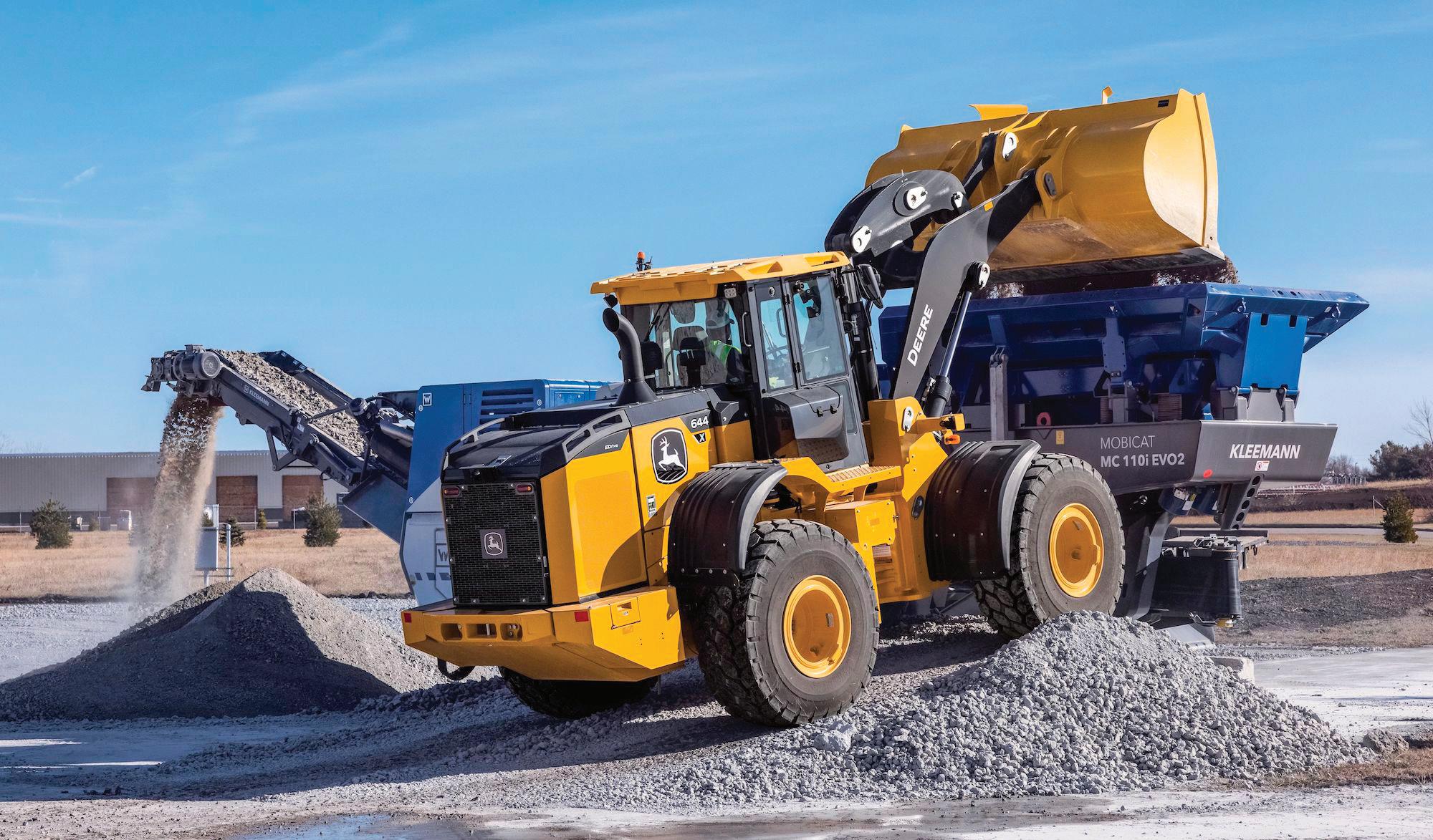
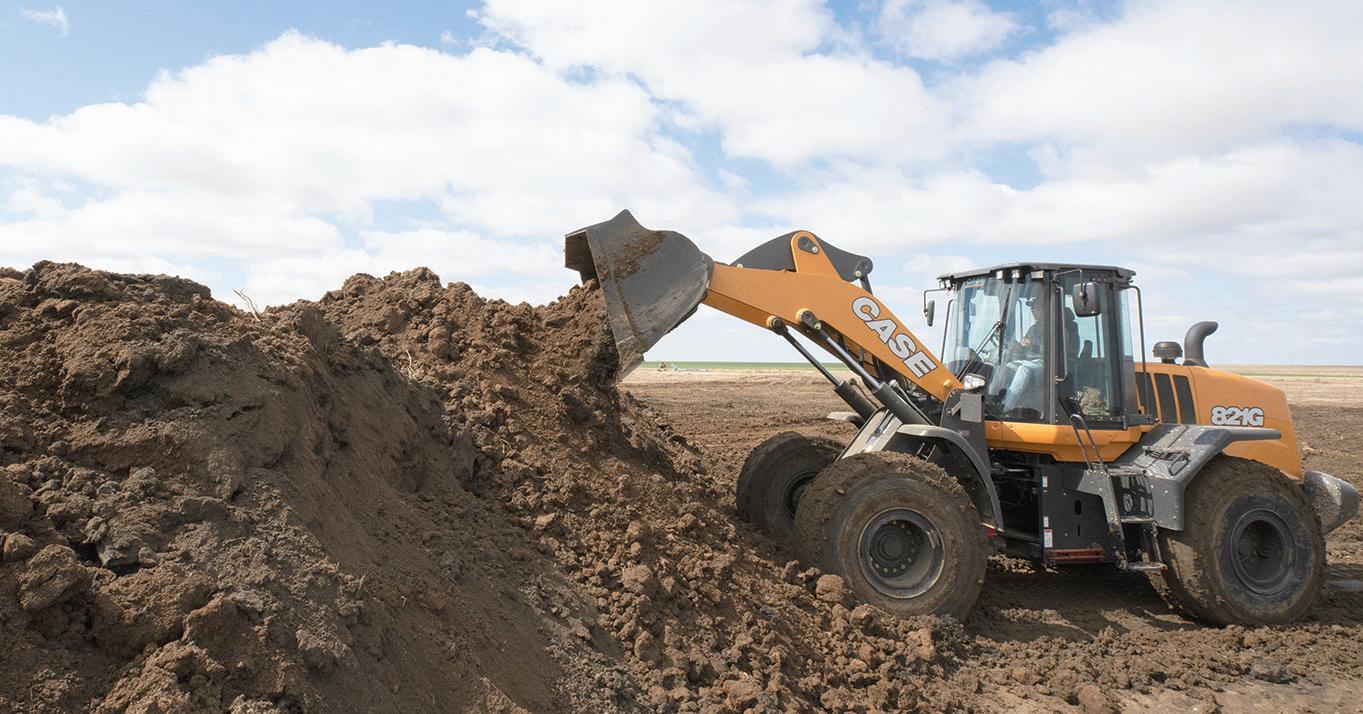
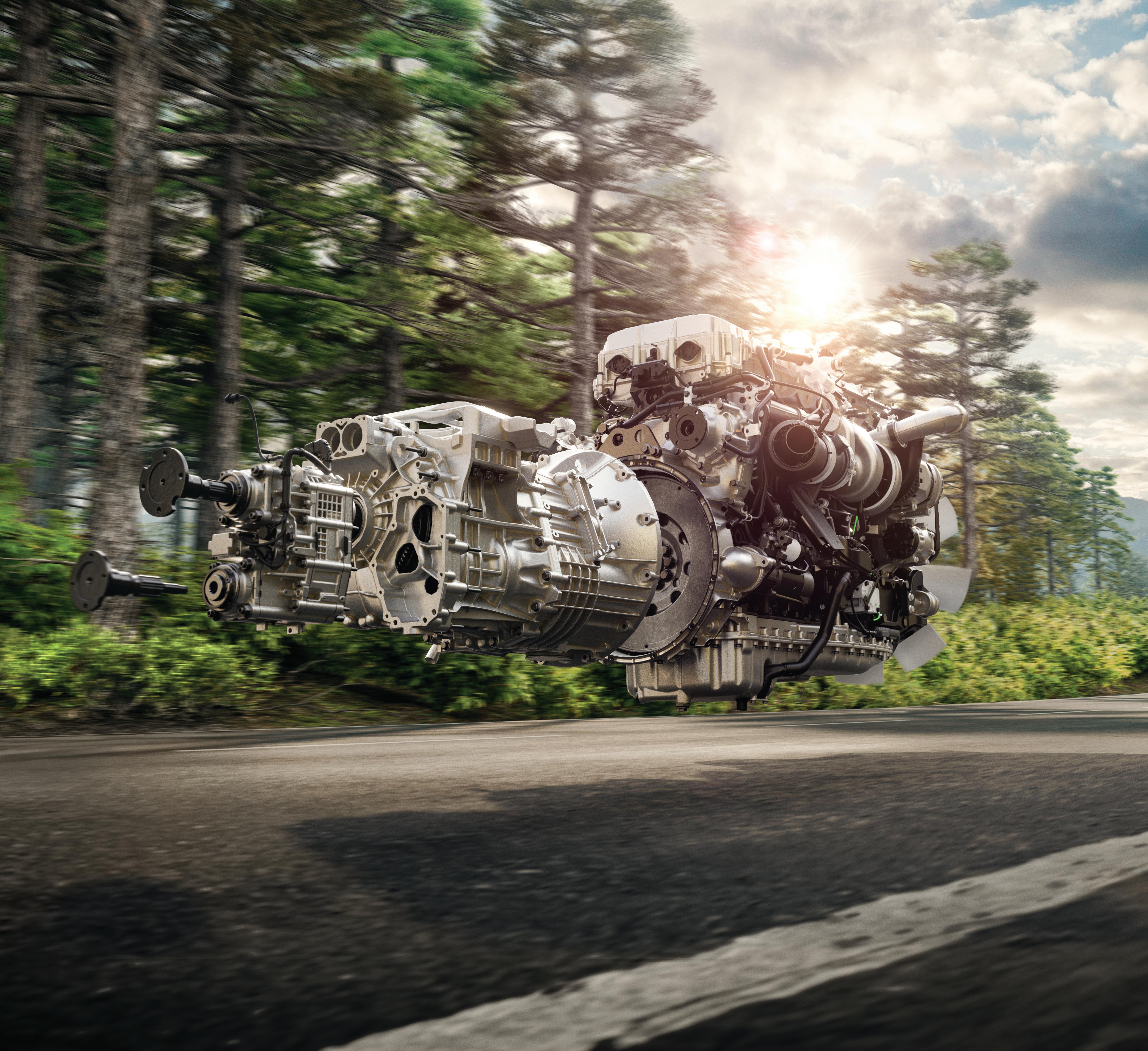


Meet the International ® S13 ® Integrated powertrain. Now available in the HX™ Series.










After revolutionizing highway driving in the LT® and RH™ Series, the S13 Integrated is now ready for severe duty work in the HX Series. A huge step forward in performance, design, and operating economy, the S13 Integrated is the lightest 13L in North America. But it still brings 515 horsepower, 1,850 lb-ft of torque, and optional factory-installed PTOs. Not to mention simpler serviceability for more uptime. Now all that’s left to do is get to work.

In addition, they’re compatible with various technologies that support operators’ productivity, including Connected Maps, Load Assist and onboard weighing.
However, its electric-powered, hybrid prototype 20-ton wheel loader achieved a roughly 50% improvement in fuel efficiency during testing, leading to a 35% decline in emissions. Consequently, operators would be able to decrease their operating costs, while also increasing their productivity, as they’d spend less time on refueling.

“The operators who tested the wheel loader also noted its significantly quieter operation, ease of use and powerful hydraulics,” Yeomans said. “By using more environmentally friendly wheel loaders like our prototype, operators’ employers may also acquire clients that have sustainability requirements.”
As Yeomans compares Volvo Construction Equipment’s traditionally powered wheel loaders with its electric-powered, hybrid prototype 20-ton wheel loader, he believes they provide practically the same amount of power and the same level of performance. They also both have an attachment or a bucket, front and rear frames, loader arms, rims, tires and cabs that will offer operators safe environments. Yet, some key differences exist too, aside from fuel efficiency.
“Our prototype hybrid wheel loader’s driveline consists of a battery energy storage system, electrically
driven hydraulics and electric drive motors, which are mounted at the wheels,” he said. “The prototype, which has 98% new parts and a fundamentally new machine design, can do the work of a wheel loader that’s one size larger.”
Less Noise, Less Vibrations, More Comfort Meanwhile, Joe Schinasi, vice president, sales, First Green Industries, has noticed a variety of benefits, concerning the usage of traditionally powered wheel loaders. First, their performance capabilities and limitations are well known. And they can be refueled quickly on operators’ jobsites.
“There is an expansive universe of service documentation and experienced service technicians, as many professionals know how to diagnose problems and fix diesel equipment,” he said. “Furthermore, if owners purchase a new, traditionally powered wheel loader, their out-of-pocket expenses will be lower than if they had purchased new electric-powered wheel loaders instead.”
Electric-powered wheel loaders are designed to be less expensive throughout their lifespans than traditionally powered wheel loaders are, as they require less maintenance, particularly since they have fewer moving parts and fluids than diesel-powered wheel loaders. Additionally, they have lower noises and vibrations, leading to higher operator comfort.
“And since they utilize electric power, any risk of contamination to the environment, in which fuel is typically stored, is alleviated,” Schinasi stated. “They can also be used in confined interior spaces, as they promote cleaner air, too.”
Another key difference? Electricpowered wheel loaders may not always have enough power to be used for operators’ entire work shifts. And, since they aren’t typically recharged quickly, they may be “offline” until they’re recharged.
“These concerns can be eased by having multiple batteries for hot swapping, which First Green Industries offers,” he added. “And operators can utilize fast charging systems — offerings that our company will have in its pipeline.”
Brady Lewis, product manager, CASE Construction Equipment, agrees with Schinasi, adding that “wheel loaders with traditional combustion engines are practical, well-established and familiar to fleet managers and operators alike.” They’re also highly powerful and they’ve been proven “to get the job done” over and over again. In addition, they can operate practically anywhere in which operators can acquire fuel.
But electric-powered wheel loaders have a variety of benefits too, from the elimination of all costs associated with diesel engines, to their ability to be utilized indoors, to the aforementioned impact on jobsites’ emissions. And, as Schinasi mentioned, their quiet performances shouldn’t be overlooked, as the sounds of an electric motor and
its hydraulic systems are considerably less than a diesel engine’s, enabling operators to talk to their co-workers more easily on their jobsites.
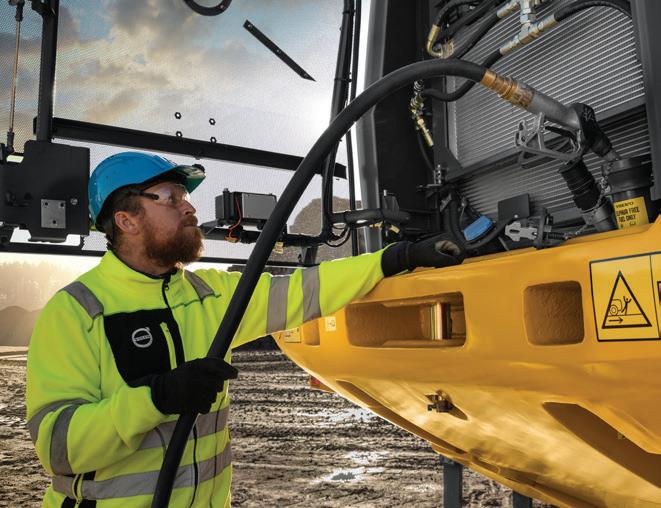
“Not every job will be right for electrified wheel loaders, as there are sites in which access to electricity, production levels and size obviously make machines with combustion engines more practical,” Lewis said. “But there are also jobs in which electrified wheel loaders excel, from big box stores that require wheel loaders to be used inside, to large, existing factories that are being renovated, to supply yards that have access to regular power and need to utilize wheel loaders at various times throughout the day.”
Whether operators choose to use a traditionally powered wheel loader or an electric-powered wheel loader, CASE Construction Equipment is focused on ensuring each product offers them high performance, along with a variety of capacities.
“Everything is relative to scale, but operators should experience the same capabilities and feel, regardless of the wheel loader they utilize,” Lewis emphasized. “In some cases, operators will need some time to become accustomed to not hearing a diesel engine running, but they’re generally satisfied with the equivalent performances of electric-powered wheel loaders, in comparison to dieselpowered wheel loaders of similar sizes.”
As operators choose between a traditionally powered wheel loader and an alternative fuels- or electric-powered wheel loader, their decisions are based on the requirements they have for their specific job tasks, according to Schinasi. However, with that being said, he does believe the future of wheel loaders will be tied to alternative fuels and electricity.
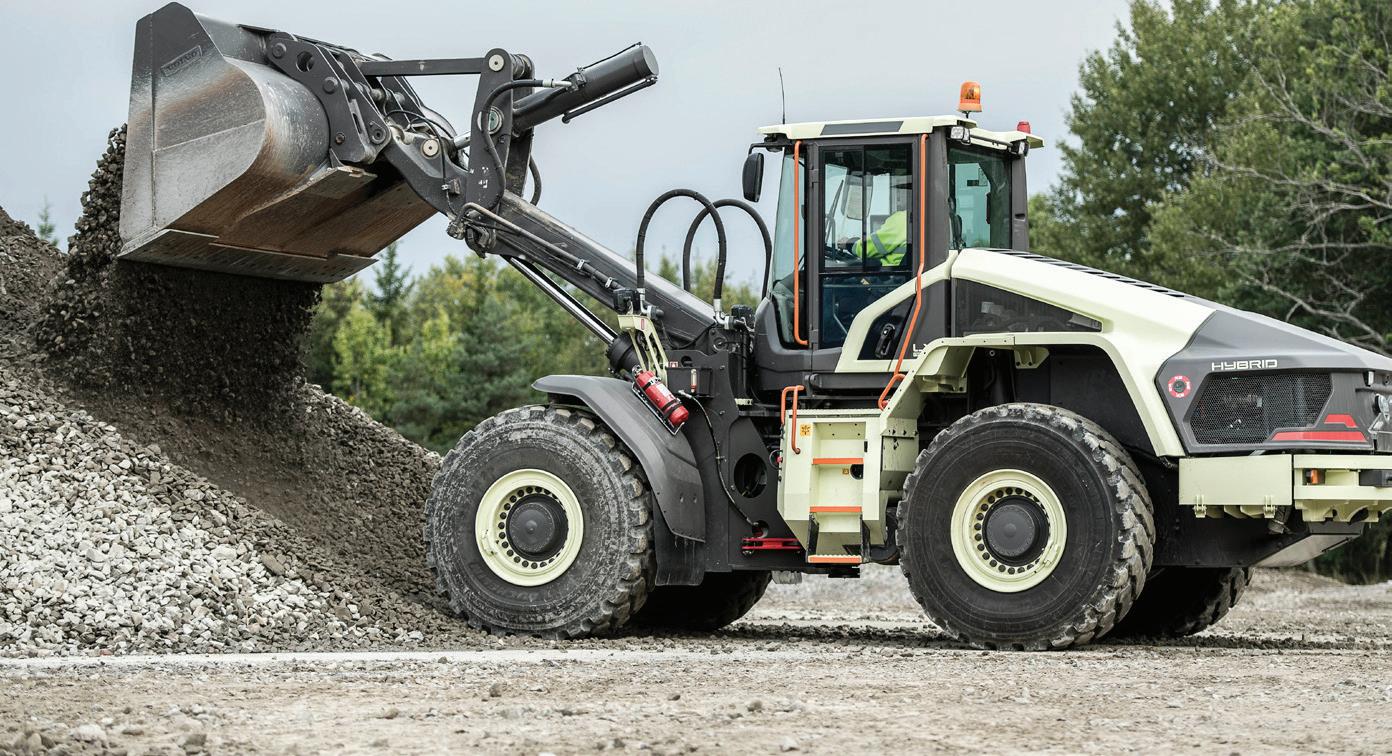
“The benefits of electric-powered wheel loaders are substantial,” he stressed. “And, without a doubt, a higher percentage of wheel loaders will progressively be powered by clean energy power.”
Lewis believes that, as with practically every buying choice in the construction industry, the decision
WithVolvo’s electric-powered, hybrid prototype, 20-ton wheel loader, operators would be able to decrease their operating costs while also increasing their productivity. Volvo Construction Equipment recently upgraded its L350H wheel loader, resulting in 10% faster working cycles and a rise in fuel efficiency, by up to 15%.
between purchasing a traditionally powered wheel loader or an electric-powered wheel loader comes down to operators knowing their specific applications.

“If operators are running wheel loaders in a supply yard where they aren’t running at production levels all day, electrified wheel loaders may be the best option,” he said. “Likewise, if operators are conducting indoor renovation and reclamation work, electrified wheel loaders will be the most suitable.”
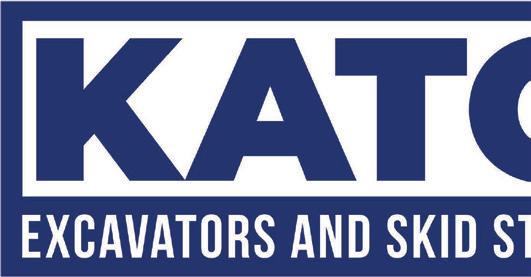
He continued, “But, if operators are working in outdoor production environments for multiple shifts, they should utilize a wheel loader with a traditional combustion engine. And if a jobsite has primary power that hasn’t been run to it yet and a wheel loader has to stay on site indefinitely, traditional power will be the best bet.”
In the meantime, if operators need wheel loaders for heavy V-pattern loading style applications, they will prefer the fuel efficiency enhancements offered by hybrid-powered wheel loaders, according to Gribble.
“When operators lay off their wheel loader’s accelerator pedal, change its direction or drive it downhill, inertia and gravity will continue to drive it,” he said. “When this happens, the wheel loader’s electric motors are mechanically driven by its wheels through its driveline, as they temporarily become generators, adding supplemental energy to its electric drive system.”
This energy is then distributed to the wheel loader’s power electronics, which can, in turn, use the energy to drive its generators to offer assistance, with regards to its hydraulic pumps’ drivability. Consequently, the load on its engine will decline, thereby enabling its engine controller to transmit less fuel to its engine, resulting in highly evident fuel gains.
“As more and more operators realize the benefits that hybrid-powered wheel loaders provide, including increased production, less fuel burn, and lower owning and operating costs, they will likely continue to become more and more popular in the years to come,” he added.
In preparation for the future, Yeomans believes hybrid-powered and traditionally powered wheel loaders will continue to have roles on their respective jobsites — as will other alternatively powered wheel loaders like fully electric models.
“At Volvo Construction Equipment, we believe there is no single solution when it comes to sustainable power,” he said. “That’s why we’re working with technologies such as battery-electric, hybrid and hydrogen fuel cells, along with alternative fuels like hydrogen combustion, on various products.”

Regarding its internal combustion wheel loaders, the company is striving to ensure they’re more efficient and environmentally friendly.
“For example, we recently
upgraded our L350H wheel loader, leading to 10% faster working cycles and up to 15% greater fuel efficiency,” Yeomans stated. “And we’ve introduced two compact wheel loaders that are fully electric, the L20 Electric and L25 Electric. They have zero emissions, a significant reduction in noise levels and similar performances, when compared to their diesel counterparts.”
The bottom line? According to Lewis, “electrification is here to stay.”
“As electric technology improves every day, operators are going to see it expand more into larger machines and more diverse applications,” he added. “There will always be a demand for traditionally powered wheel loaders, due to the applications they’re most ideal for. But, without a shadow of a
doubt, electrification is the future — and electrified models and capabilities will only continue to expand.”
Chris Lewis is a freelance writer for Equipment Today.
Read more at: https://eqtoday.co/altpowerloaders
The KATO 823MR is a minimal radius powerhouse, driven by the 172hp ISUZU 4HK1X. The four-pump hydraulic system and nearly 22 feet of digging depth with a digging force of 54,050 lbs. will move heaven and earth on your job site. This minimal radius large excavator is Japanese made and U.S.A. customized/distributed. KATO’s exceptional full-size line of excavators rise to the demands of the biggest earthmoving jobs. All R7 excavator models come standard with cab heat, a/c, pattern change valve, dual auxiliary hydraulics, side and rear view cameras. Learn more at www.KATOCES.com or call today 1-800-538-1447.
Not only is proper grading on construction jobsites crucial to a job’s long-term success, but improper grading can have significant ramifications on a project’s timelines and costs.

Not only is proper grading on construction jobsites crucial to a project's long-term success, but improper grading can have significant ramifications on a job’s timelines and costs. Such is the observation of Matt Goedert, John Deere solutions marketing manager, as well as other industry experts in addressing the importance of proper grading.
“There are many reasons for this, as it can have a great effect on the jobsite’s timeline, efficiency, machine operating costs, jobsite conditions and ultimately the satisfaction of the end customer,” Goedert said.
As a construction site task that disturbs the ground, the value that proper grading brings to a project
cannot be underestimated. It is the function of a construction site project that establishes the permitted height and depth of swales, cuts and fills, as well as enabling proper drainage.
Proper grading is a driving factor in mitigating environmental issues as they relate to erosion control and stormwater runoff, and helps contractors fulfill the requirements of a National Pollutant Discharge Elimination System (NPDES) plan and a Stormwater Pollution Prevention Plan (SWPPP). In addition to adhering to nationally-established standards, grading also must be completed in compliance with local zoning and other regulatory restrictions and requirements. During the construction phase, sediment control is a consideration when engaged in grading, with care given to pollutant runoff of trash, debris and solids. The impact of various weather conditions is one of the factors in achieving proper grading, Goedert pointed out.
“Proper grading to ensure water sheds off the jobsite and away from working areas will help the jobsite keep moving after inclement weather is experienced,” he added. “Without keeping drainage in mind throughout the jobsite’s construction, days and even weeks can be lost in the schedule.”
Scott Hagemann, Caterpillar senior market professional, agreed that controlling water without losing material is a significant driving factor in proper grading.
“For example, on a gravel road, you need to have the water flow off the road, but if the slope is too much, the gravel will also flow into the ditch,” he said. “On a concrete or asphalt surface, you need to grade so that the water flows to the designed areas.”
Operating costs of equipment can also be affected by weather and other factors, said Goedert.
“When grading with a dozer for example, a significant portion of the operating cost is tied to the undercarriage,” said Goedert.
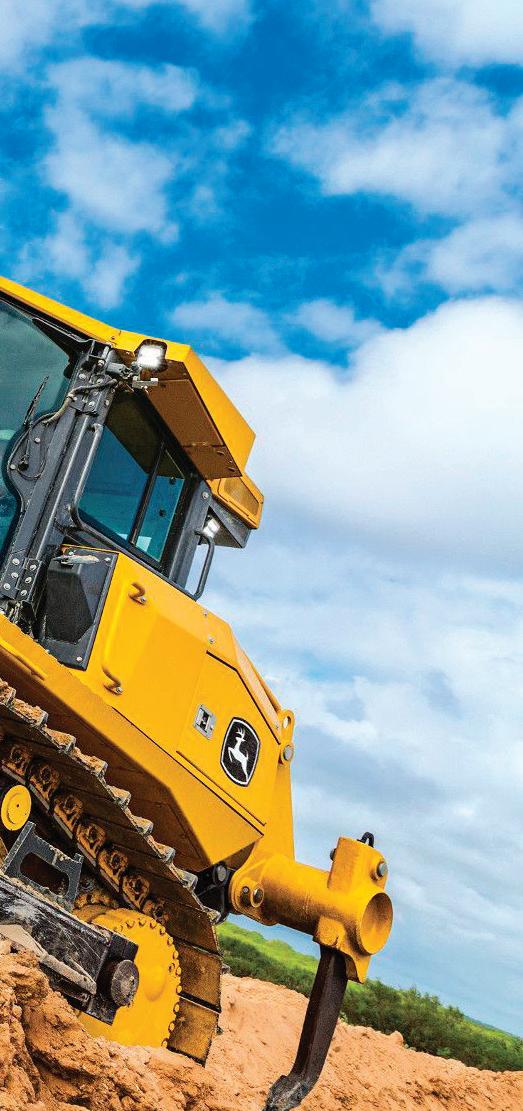
He added that when grading, a good equipment operator will have as a primary consideration a purpose for every move made with the dozer as to keep the number of passes needed to a minimum. Being conscious of
how operating characteristics, such as travel speeds, working on slopes and load management affect undercarriage wear also is important, Goedert said.
“At the end of the day, the grade of the finished product has to be correct, both in elevation and slopes,” he added. “For most jobsites, the tolerance of these specs is defined by the engineering firm who created the design. The grade is often inspected as the jobsite progresses to ensure it is within design specifications. Ensuring the grade meets target specifications can save large amounts of time in costly rework.”
Using the Correct Equipment for the Task Safety is paramount during the grading procedure, said Hagemann.
He pointed out that interstate speed limits are based on the road slopes in curves and for on- and off-ramps, so if the job is not done properly, it compromises safety.
“Also, if you have a haul road to maintain, you don’t want excess cross slope due to material that would fall off the haul truck,” he added.
In grading, there are standard do's and don’ts that contractors should consider in ensuring its success.
A major consideration when grading is to use the correct equipment for the job and how it was designed, pointed out Hagemann.
Goedert concurred.
“A critical part of ensuring proper grading is selecting the right tool for the job,” noted Goedert. “When looking to purchase or rent a piece of equipment, it’s important to consider the machine’s versatility to ensure high utilization and return on investment.”
He cited the John Deere 950K PAT dozer with SmartGrade as a piece of equipment designed for versatility.
Given that it is equipped with a sixway power/angle/tilt (PAT) blade, the dozer is designed to enable the operator to execute significant levels of dozing and finish grading, doing so without the use of several other machines.
“This machine fits into so many different segments, providing the production capability of a large dozer with the versatility of a small finish dozer,” Goedert points out. “The large PAT blade provides the ability to control and windrow material allowing the operator to balance out cuts and fills efficiently.”
The versatility enables its use in jobs from fine grading and site development to large road-building tasks.
The equipment operator and the technology used also plays a large part in meeting the grade tolerances outlined for the job, Goedert pointed out. Technology used on the equipment offers the equipment operator the ability to leverage the benefits of precision, safety, and efficiencies in time and costs.
SmartGrade aims to improve grade accuracies and reduce the number of passes it takes to achieve target grade, said Goedert. SmartGrade provides 3D grade control without external masts or cables. Auto SmartGrade automatically adjusts the blade when encountering heavy loads.
“There are many other tools in the operator’s toolbox to help them achieve proper grade,” Goedert said. “Features such as slope control allow operators to grade consistent slopes to meet specification and ensure proper drainage on the jobsite.”
Many John Deere products also offer 2D laser solutions which allows the system to also control the blade/ bucket tooth to a desired elevation. Often working in the background is technology that may be less complex but adds a lot of benefit, such as John Deere EZ Grade technology, said Goedert.
“EZ Grade is designed to sense changes in the machine’s pitch and automatically adjusts the blade’s position to maintain smooth grades, helping operators achieve phenomenal grades with lower effort and reduced fatigue,” Goedert points out.
Operating characteristics can have a significant impact on undercarriage
Ensuring the grade meets target specifications can save large amounts of time in costly rework.
— Matt Goedert, John DeereProper grading on construction jobsites is crucial to a project’s long-term success.
life, which in turn affects operating costs, he added.
Some operating habits to be conscious of that may cause premature undercarriage wear include always turning one direction, continually working slopes in the same direction, spinning the tracks, and continuous abrupt turns or counterrotating, which increases stresses in undercarriage components, Goedert noted.
“In general, high speed shortens undercarriage life, especially in reverse,” he said. “Since the amount of wear correlates with distance traveled, reducing the number of passes needed to complete a job has multiple benefits. All these characteristics are items to look at when training operators.”
In addressing the do's and don’ts associated with proper grading, Rafal -wski, product specialist for HST dozers for Komatsu, noted that “a big thing is to think ahead of the jobsite that you're about to get onto.
“Understand the terrain, understand where you have to move dirt, and where you have to take dirt from to constantly have material in front of your blade,” he added. “This will essentially save you time, money and increase your productivity and efficiency.”
Komatsu has developed and is reinforcing the iMC 2.0 proactive dozing ‘smart’ technology.
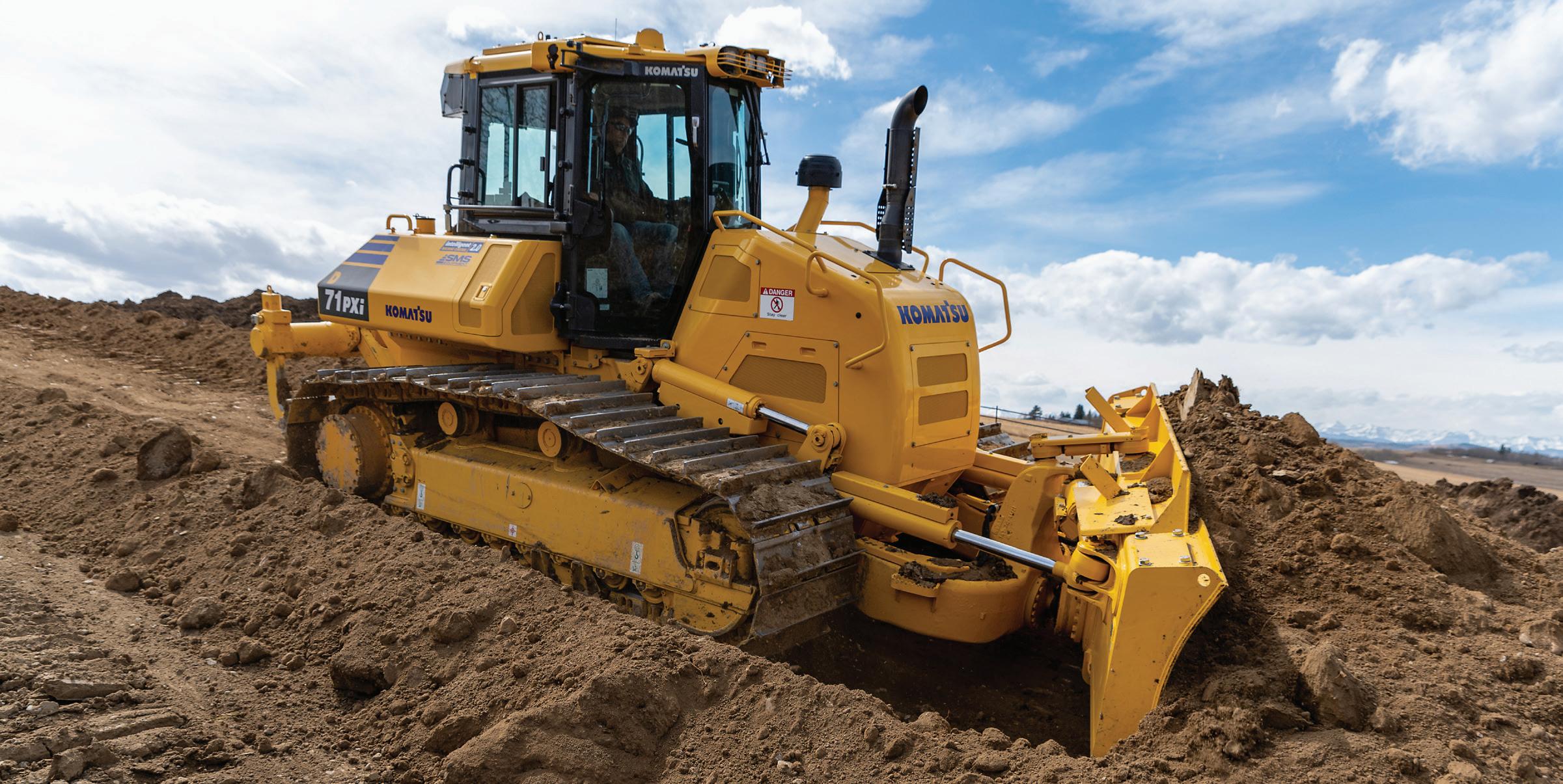

“This essentially allows the machine to think ahead as it tracks across the terrain,” Bukowski said. “It maps it and creates a temporary surface. This allows the machine to plan for its next pass, allowing it to grab as much dirt and position it into most spots, essentially taking dirt from high spots and putting in the low spots.”
A significant factor in grading is for the equipment operator to always
obtain a surface that is not only smooth, but also drains properly, said Bukowski.
“Understanding the terrain and how you essentially want the terrain to look when you're finished will allow you to make fewer passes, create less wear on the machine and save time and money,” he added.
Another key factor is to always maintain awareness on a swivel, Bukowski noted.
Safety is the No. 1 priority for a jobsite. Bukowski pointed out that there are multiple people working on jobsites and a many potential risks involved.
“If we can minimize the amount of people that are on the ground, essentially you're practicing safe workspace conditions,” he said of the use of ‘intelligent’ equipment.
As such, automatics allows the operator to “keep their head on the swivel to understand who's around the machine and create eye contact whenever there's somebody at the jobsite,” Bukowski noted, adding that by doing so, “we are essentially eliminating workers being on the ground checking grade to place some stakes, since the machine does that for you with high accuracy.”
In terms of what should be avoided on a grading project, Bukowski advised against overloading the blade.
“Many inexperienced operators will start the machine up and load up the blade with as much material as they possibly can,” he said. “But that tends to bog the machine down, creating divots and ruffles.
“Essentially you want to have a smooth transition when starting out and creating a consistency, loading up
as needed. That minimizes the amount of time that you need to go over the material multiple times – smooth transitions from high spots to low spots.”
Few factors can hold a project up like down time as a byproduct of improper maintenance.
“Ensuring that machine inspection and daily maintenance occurs greatly effects the machine’s performance, longevity, operating cost and even operator efficiency,” noted Goedert.
Proper inspection and maintenance includes performing daily walkarounds, which are essential to ensure the machine meets its productivity potential and to minimize potential down time.
“When examining your machine, it’s crucial to get into not only a regular routine but complete the checks in the same order,” said Goedert. “Every time you do an inspection, start in the same spot, and complete your inspections around the machine ending where you started. This routine makes it easier to spot what is normal vs. abnormal and makes sure no checks get missed.
“When performing your walkaround, visually inspect the machine’s appearance and look for damage, check fluid levels, look for leaks and take a close look at wear items that could prevent the machine from efficiently doing its job. Spotting potential problems early is beneficial on multiple fronts.”
On every piece of equipment, routine greasing offers a lot of benefits, noted Goedert.
“Not only does proper grease improve component life, but it will have a large impact to the performance and accuracy of the machine,” he said. “The tighter we can keep the machine’s joints, the more precise the operator will be able to control the machine.”
team will be working at, one expert said.
This improves accuracy both with and without a grade control system installed, he added.
“Checking for leaks at the end of the day can be a good way to prevent a mess from occurring overnight and reduces the environmental impact and can be beneficial while all the joints are free to ensure proper lubrication,” said Goedert.
Undercarriage is an area where owners can accrue significant costs. It is important to perform proper maintenance such as checking track tension to optimize the life of the system, Goedert said.
“A dealer can help with maintenance or – when purchasing a new machine – with selecting the right undercarriage solution for the intended application,” he said, adding John Deere’s Maximum Life undercarriage is designed to offer twice the life of conventional systems. Increasing undercarriage life lowers operating costs.
Goedert noted that the three ways in which owners and operators can ensure they get the most out of their undercarriage include:
˜ Track tension: Maintaining proper track tension is an important controllable factor in undercarriage
It’s important to think ahead and pre-plan for the type of jobsite your
life. A tight track greatly increases component stresses and increases wear rates. Tracks should be adjusted to the proper amount of sag as working conditions change, possibly daily. Increased soil moisture, for example, can cause packing in the sprockets and a tighter track. A track tension decal is located inside the service door of all John Deere dozers displaying the track sag specifications and the process to check it. Keeping the undercarriage clean. If working in a material that hardens as it dries out or freezes, cleaning the undercarriage daily will prevent the increased wear that occurs with the additional contact points.
Daily visual inspections of the entire undercarriage are helpful to identify any unusual component issues or unusual wear indicators. Undercarriage wear inspections on a regular interval allow planning for repair or replacement and are proactive actions that lead to better control of the overall costs of maintenance.
To increase the likelihood of proper maintenance, John Deere has designed its equipment to make maintenance as easy as possible, noted Goedert.
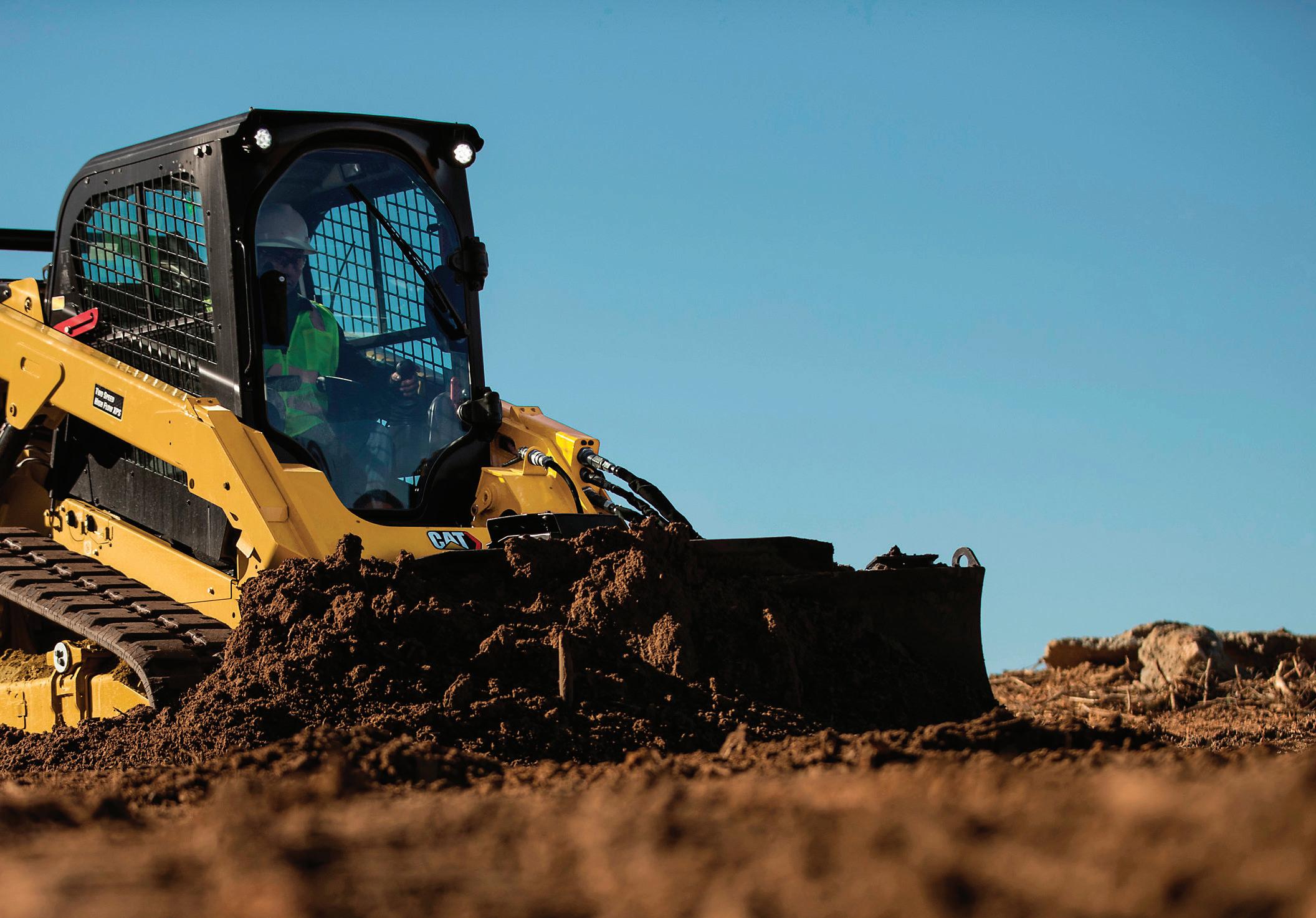
“On every piece of John Deere equipment, a periodic maintenance decal is located inside the service

compartment which includes key maintenance information such as recommended oil types, refill capacities, and color-coded maintenance intervals,” he said.

“When designing equipment, time is spent grouping filters and fill locations together and making them accessible from ground level as much as possible. The easier it is to perform maintenance the more likely it is to get completed properly.”
“A key factor in maintaining equipment is essentially the less you use it, the better condition it will be in,” said Bukowski. “It seems like common sense. But with automatics, you are you're essentially being 60 percent more productive than previous generations of automatics – using machines 60 percent less of the time and doing the same amount of work. With that, you get higher productivity, higher efficiency, and with less fuel less wear and tear on the machine.”
Bukowski also advises the operator to minimize third gear reverse travel as much as possible to keep the undercarriage lasting longer. Make sure the machine is calibrated as correctly as possible, he added.
“With that calibration, you want to make sure that your blade tips are measured and inputted correctly into the machine,” Bukowski said.
Proper tuning also enables the operator to adjust the blade response
from normal pass to fine, depending on the type of material with which the operator is working, he added.
“You want to create a smooth surface with the contour of the final grade in mind,” Bukowski points out. “But also, at the end of the day, machine operators will seal the job site, meaning they'll back drag materials to prevent water pools from building up. This creates less time for when it rains for material to dry up and they can get back onto the job site.”
“Machine wear is a natural outcome of machines and needs to be adjusted as it happens,” he added. “Some adjustments need to take place to tighten the slop in the machine. Some parts are not designed to be adjusted; they need to be replaced. Regular maintenance of changing oil, filters and greasing is required to get the most out of your equipment.”

With the electric medium-duty vehicle market booming and sustainability deadlines looming, companies must keep a pulse on these four key industry trends throughout 2023.








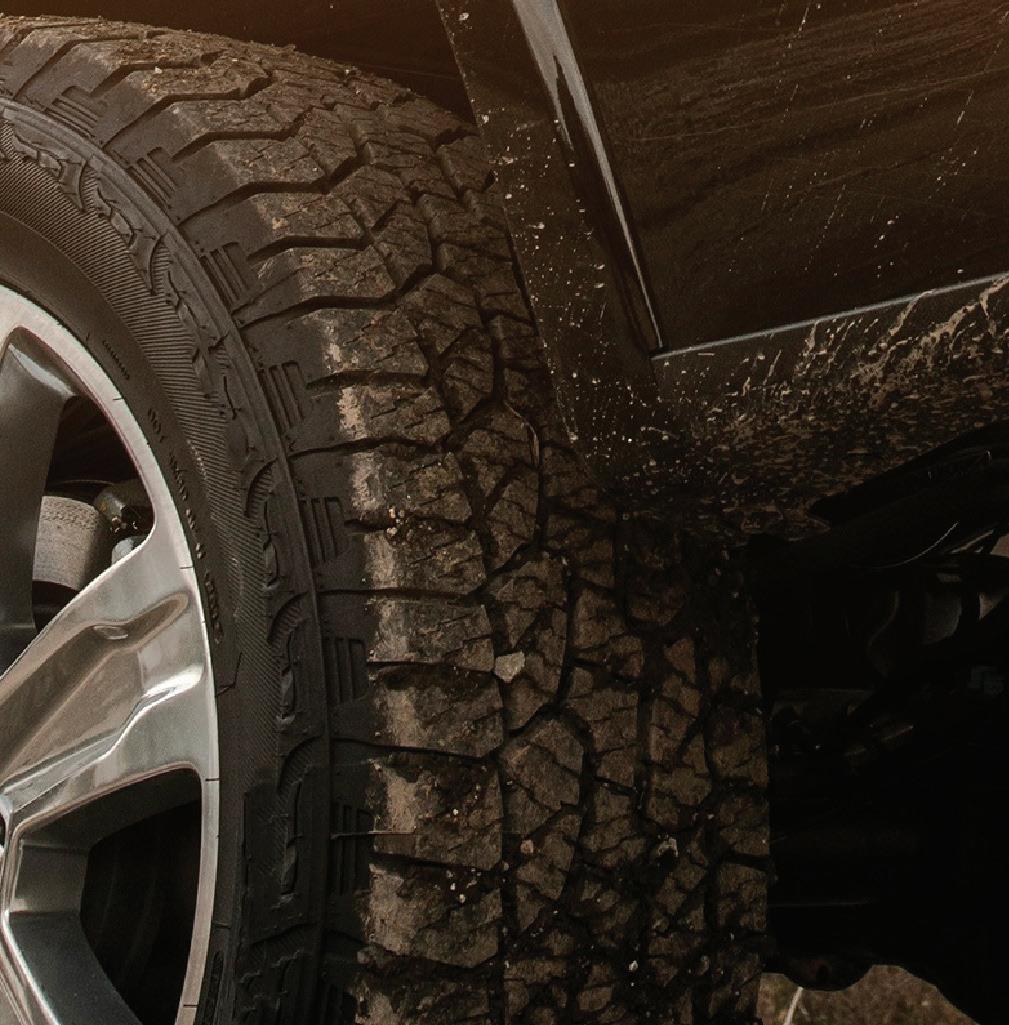





Electrification is coming for mid-size fleets, but are businesses prepared? Looking ahead to 2023, the pressure is on, but so are incentives to help mitigate costs. Electric vehicle (EV) tax credits bolstered by the Inflation Reduction Act will be up for grabs; the United States will make strides toward its global commitment of 100% zeroemission medium duty truck sales by 2040; and Californians will gear up for the Advanced Clean Truck regulations to kick off, requiring manufacturers to sell an increasing percentage of zero-emission trucks starting in 2024. Immediately following will be Advanced Clean Fleet regulations, which will likely mandate all operating medium-duty trucks to be electric by 2035 and 50% of them by 2031.
All of these milestones underpin the electric commercial vehicle market’s growth, expected to reach $848 billion by 2030. In the years to come, businesses must prepare for the inevitable, freeing their fleets from fossil fuels. But without a clear path to electrification, many companies don’t know where to start in the crowded and ever-changing industry, how to get up to speed on the unique planning needed for electric trucks or which technology solutions to hone in on.
As fleet managers and vendors start preparing in 2023 to navigate the pressures of quickly-approaching deadlines, they must focus on the following key industry changes to make their move to electric a seamless and successful transition.

Fleet managers already know how to shop for trucks, but electrifying them and their operating hubs is where the learning curve lies. Managers need help, and EV vendors have an opportunity to grow into true partners.




The 2031 deadline for Californiabased companies to replace half of their medium-duty commercial truck fossil-fueled engines makes EV fleet deployments mission-critical and highly sought after. To help businesses meet these requirements, California’s Hybrid and Zero-Emission Truck and

Bus Voucher



With the electric medium-duty vehicle market booming and sustainability deadlines looming, companies must keep a pulse on these four key industry trends throughout 2023.




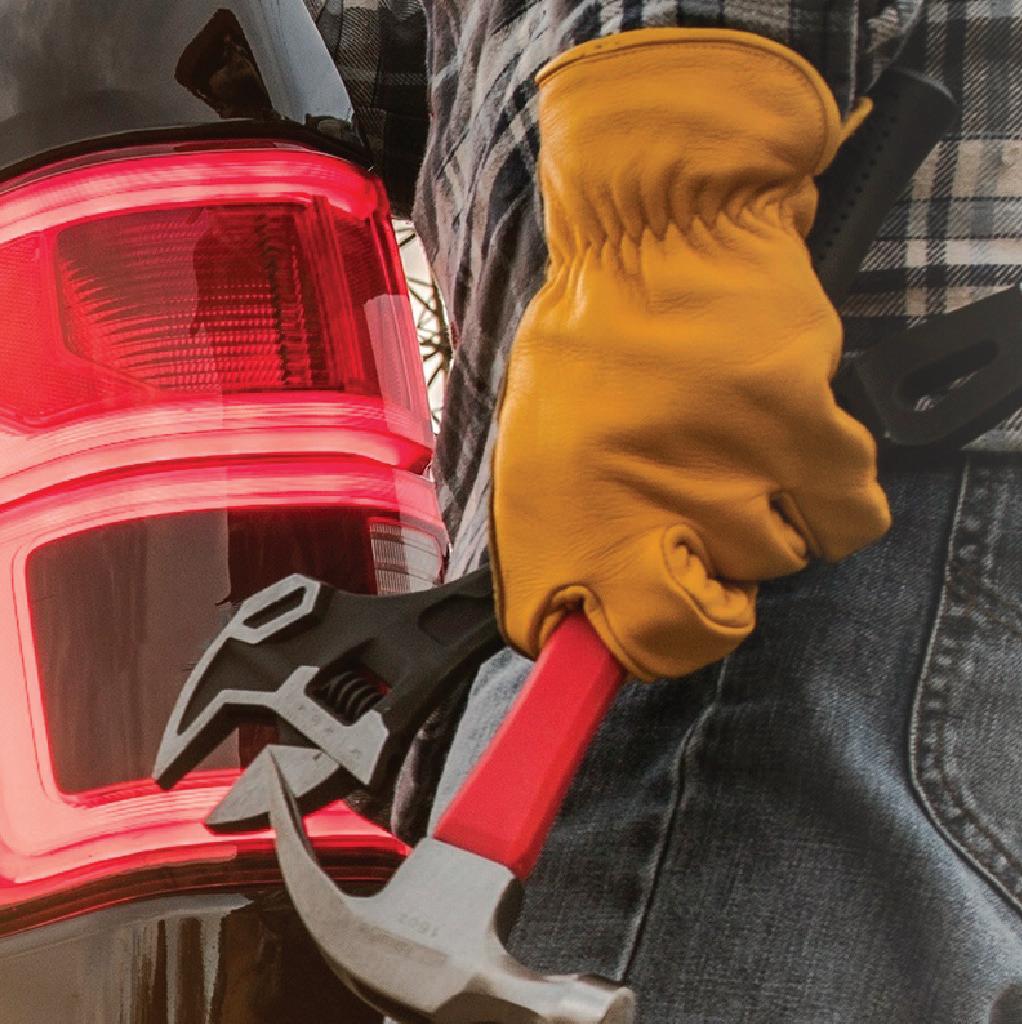

provides point-of-sale vouchers to make EVs more affordable.


However, application programs for incentives like HVIP and tax credits as part of the Inflation Reduction Act can be challenging to navigate on your own. That’s where vendors can lend a helping hand, guiding customers to source funding programs, complete applications and receive incentives. In order to support customers and be a good partner throughout the voucher process, vendors should continually seek out new and revised funding opportunities to inform potential and current customers of new possibilities and guide them through each step of the application process.
Businesses need EVs to meet zeroemission fleet requirements and share in the ROI, but vendors have to expand their roles to pave the way. They have more experience with incentives, generally having already produced and sold vehicles under those programs, and must use that knowledge to take the onus off of customers. By helping customers with everything from incentives for purchase, to reliable charging infrastructure, to scaling customized EV fleets, vendors can walk hand-in-hand with the businesses at the helm of electrification to make the EV revolution a reality for all.
According to the Economic Policy Institute, the shift to all-electric vehicles could create over 150,000 jobs by 2030. But it’s not just about creating jobs – it’s also about improving the quality of them. For drivers, these vehicles are their office, their sales storefront and their break room. Eight or more hours a day – every day. Imagine how much better their day can be when the truck isn’t noisy, vibrating, baking with heat from its engine, and spewing unsafe fumes.
Electric trucks have proven to be key recruiting and retention tools for drivers. It’s simply a more comfortable driving experience thanks to regenerative braking, which requires far less physical effort than the truck’s foundation brakes. Also, the experience of being told to shut off one’s vehicle during a delivery stop is a thing of the past. With help from trained fleet managers on route planning, charging, one-pedal driving, avoiding range anxiety, and safety awareness — drivers find electric trucks and vans are safer and more efficient.
managers on route planning, charging, one-pedal driving, avoiding range anxiety, and safety awareness — drivers find electric trucks and vans are safer and more efficient.

Moving from diesel-powered
ICE trucks to electric also provides
ICE trucks to electric also provides
a healthier experience. The Natural Resources Defense Council (NRDC) found that large amounts of diesel exhaust can accumulate inside truck cabs from the driver’s own engine, surrounding trucks and crowded port environments. Inhaling these pollutants for hours at a time has serious health consequences. Once most drivers get in the electric truck, they don’t want to return to fossil fuels.
Driver feedback for electric trucks has been through the roof, and managers must consider the business value they can bring. For companies looking to hire drivers in the new year, EV fleets will serve as a core recruiting tool.
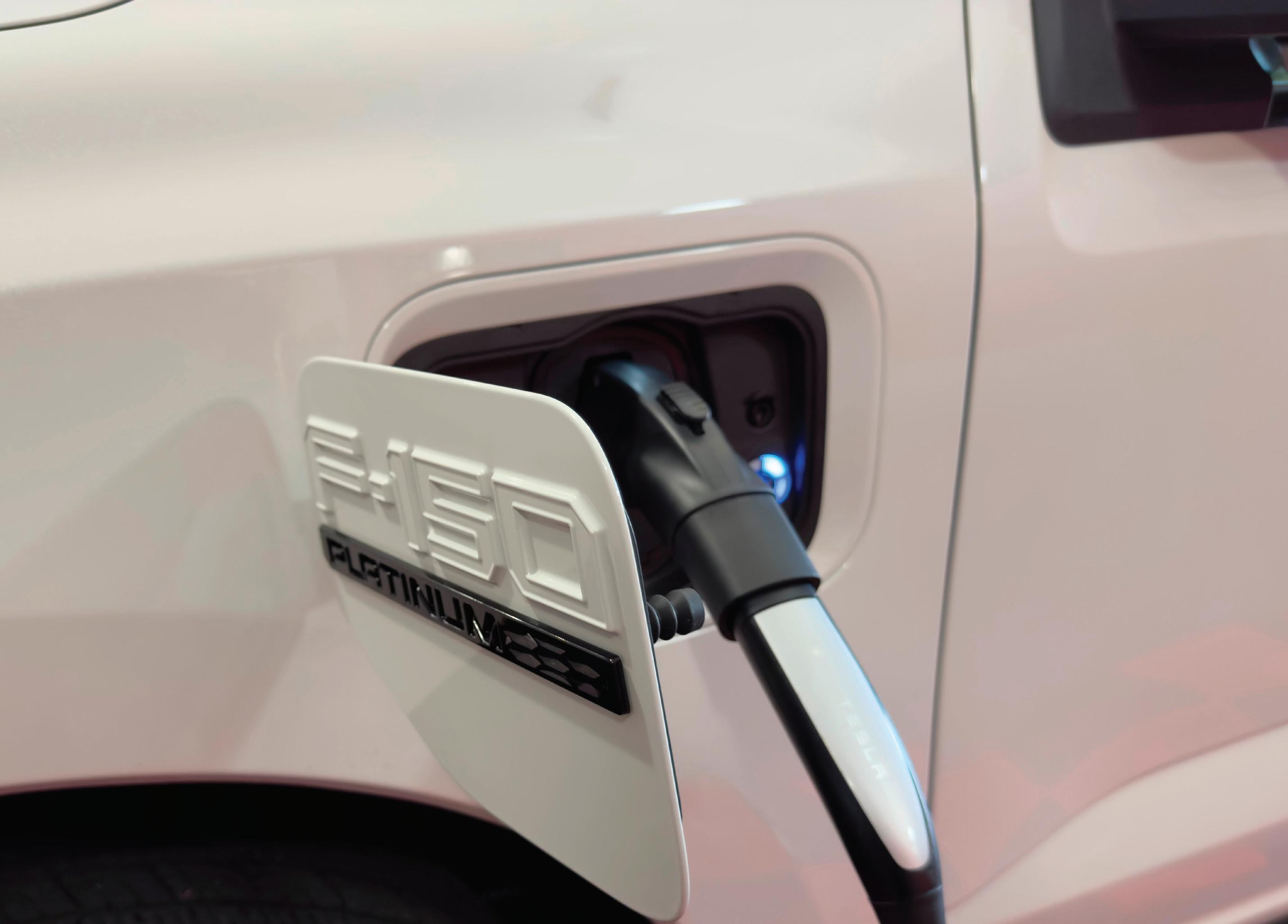
Medium-duty trucks have been long overlooked, even though they’re critical to powering the backbone of our economy. However, the restricted payloads and limited configurations of Class 3 lightweight vans can’t meet the last-mile delivery needs for many companies.
Given last-mile delivery makes up 53% of total shipping costs, it’s important to explore how all classes of EV trucks can work together to build a better supply chain. It is no surprise that the early last-mile EV innovation comes in Class 2 and Class 3 vehicles — they are easier to build and the technology is simpler when the total weight is only marginally higher than a passenger car or pickup truck.
As we move more into 2023, expect battery and technology innovation that increases payloads and driving ranges for Class 4-6 designs carrying 2-6 tons, even up to 200 miles per charge, which is enough for 95% of urban and suburban daily routes. The performance and utility of new medium-duty trucks is now greater than their gasoline and diesel counterparts, opening doors for a swarm of new fleets to go electric. According to the North American Council on Freight Efficiency (NACFE), electric trucks make sense for Class 3 through 6 now, especially in stable daily fleet routes, while the heavier Class 7 and 8 EVs are usable for a smaller percentage of their roles.
Everyone wants quicker Level 3 chargers, but fail to consider the infrastructure and labor costs that come with 30-minute recharging compared to overnight charging. That’s why commercial trucking fleets with routes that return to base every night, which includes most lastmile applications, will opt for Level 2 charging in most cases. Level 3 will be for supplemental charging only, unless the vehicle operation is over 14 hours per day.
Level 2 melds the driver lifestyle and most efficient charging techniques, providing cheaper infrastructure, no labor costs during charging and better battery life. In fact, McKinsey found that Level 2 chargers are considerably more affordable, ranging in cost from $2,500-5,000, while Level 3 chargers cost anywhere from $15,000 to more than $40,000. In addition, spreading out the charging over time with Level 2 can lower infrastructure costs by up to 10 times for things like transformers.
Businesses need EVs to meet zero-emission fleet requirements and share in the ROI, but vendors have to expand their roles to pave the way.
Faster isn’t always better (or costeffective), which is why 2023 will see Level 2 charging remain the norm for commercial fleet depots.
With the electric medium-duty vehicle market booming and sustainability deadlines looming, companies must keep a pulse on these four key industry trends throughout 2023. By unlocking end-to-end partnerships in light of increased EV funding, creating a healthier and safer driver experience, taking advantage of new battery innovation to carry more weight, and saving time and money with overnight charging – companies can ensure the future of their fleets is a bright one.
Tim Krauskopf is CEO of Motiv Power Systems.Read more at: https://eqtoday.co/midsizeelectrification

Responsiveness is critical, especially when it comes to refueling a fleet. With a surge in infrastructure and construction spending along with skyrocketing fuel prices, contractors may feel their fuel costs are out of control. Transportable fuel tanks can help control these costs and allow contractors to respond to the quickly changing market conditions.
Transportable fuel tanks offer not only the cost savings that comes with buying fuel in bulk, but also the ability to reduce fuel consumption. With fullfuel transport capability, these tanks allow the fuel supply to be moved to the equipment that needs to be refueled, reducing the travel distance, and time to fill tanks.
From increasing efficiency with a fuel tank that’s ready to move immediately, to improving convenience for the crew, here are some benefits and features to understand when considering whether a transportable fuel tank is the right choice for the job.
Transportable fuel tanks, approved for transportation when filled with fuel by organizations like the U.S. Department of Transportation and Transport Canada, eliminate the need to drain and clean the tank before moving. This reduces the time to relocate a tank from hours to just minutes. When jobsite demands change throughout a project or even over the course of a day, a transportable fuel tank is ready to be moved to where it is needed.
By enabling the fuel supply to travel with the equipment as work progresses, contractors significantly reduce the distance jobsite equipment must travel to refuel. This not only saves time but also reduces fuel consumption, which translates to more cost savings overall. Transportable fuel tanks are easily moved with equipment that’s already on the jobsite, such as forklifts or cranes. Some tanks even offer the ability to be hauled in the back of a truck or
mounted on a trailer for quick and easy transportability around the jobsite or over the highway, providing on-the-go fuel delivery where it is needed, even in locations with limited access.
Transportable fuel tanks can improve fuel efficiency on longer-term jobsites and can help contractors save money when it comes time to move the tank. After all, transportable fuel tanks eliminate the need to drain and restock fuel with each move. Plus, the double-walled containment eliminates the need to pay for cleanup of a secondary containment pan.
A contractor working on a bridge project in Maryland noticed the benefits of transportable fuel tanks on the jobsite right away. Instead of having to depend on their fuel distributor to move the fuel tank, the crew had the freedom to move their transportable fuel tank whenever they needed. This ease of access to move the tank at any given time improved convenience and efficiency for all involved.
Not all transportable fuel tanks are created the same. One of the more important items to look for is a sturdy design engineered to withstand the dynamic forces of the moving liquid while navigating rough, unpaved roads. Tanks designed to comply with required approvals, including UL, ULC, DOT and Transport Canada, are usually the most rugged and well-designed, as they are required to pass the rigorous testing and certification dictated by the various approval bodies.
Keep in mind that just because a tank is approved for full-fuel transport does not necessarily mean it’s the safest option. Some transportable tanks offer a lower center of gravity, for example, that will make the tank less susceptible to tipping during transport. Additionally, tanks with internal baffle plates prevent fuel surging to keep the vehicle stable.
Additional features can help to maximize the ease of transport of these
tanks. Designs that integrate multiple attachment points like corner brackets for cranes and four-way forklift pockets allow the transportable fuel tanks to be moved with standard jobsite equipment to minimize hassle. A stackable cube shape also improves flexibility for full-fuel transport. This design allows the tanks to take up less space on a truck, the jobsite or in a yard, without sacrificing any of the capacity. Some manufacturers produce tanks that allow for stacking up to two tanks high when full, reducing the footprint when multiple tanks are required on a job.
One concern some contractors have with transportable fuel tanks is fuel security. With on-site fuel that is convenient to access, and a tank that is easy to transport, how do you reduce the risk of theft? Next-generation transportable fuel tanks keep ports and pumps inside a secure cabinet. These cabinets contain card-lock dispense controls that only allow authorized individuals to access the fuel. This provides an additional level of security while giving contractors complete control over their fuel. As an added benefit, the technology helps
Transportable fuel tanks allow contractors to respond to the quickly changing market conditions that impact their bottom line.
contractors keep track of which operators and equipment are using the fuel. This valuable information aids in determining overall efficiency.
Some manufacturers also offer GPS-based remote tank monitoring systems. One of the key features of these systems is the ability to track the tank’s location and inventory levels at any time. These systems also allow equipment operators to keep track of the nearest fuel supply, even when that location changes.
When looking for a transportable fuel tank, the jobsite and project application are the main factors to consider. If the project is short-term or involves a moving jobsite, this might be the perfect opportunity to try a transportable fuel tank for cost savings as well as improved flexibility and efficiency. When narrowing down the search for the ideal tank, also check local regulations to see which driver certifications or other approvals are required to transport tanks with fuel on board.
Ken Steury is director of sales, Americas region, Western Global.
Read more at: https://eqtoday.co/transportable
The updated MTU bulk diesel hauling platform provides better control of fueling and DEF management without requiring a CDL or HAZMAT endorsement.

• Re-launched on the Ram chassis and is equipped to carry 920 gal. of bulk diesel contained in separate 115-gal. fuel tanks
• Rear utility box houses the diesel pump and manifold system
• Optional heated diesel exhaust fluid handling system for use in colder climates
• Options include a variety of meters for measuring, security and tracking, numerous reel options and lengths, a 4-micron filter and available color schemes




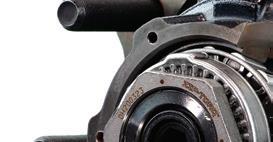
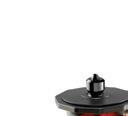
The Trifecta Pre-Adjusted Hub Assembly combines the company's wheel end technologies with the Webb hub in a single, pre-adjusted assembly.

• Available for truck and trailer (P-type and N-type spindle) applications
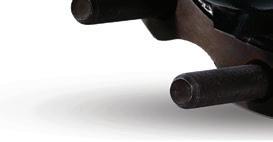

• Quick, easy installation with a simple torque-down procedure and no additional bearing adjustment

• Zip-Torq axle fastener featuring a unitized design with no additional clips, keepers, snap rings or screws
• Discover XR high-performance seal with GlideLock technology that reduces installation force by 50% with no prelube required
• Defender ESP hub cap
Ford Pro has announced a suite of fleet management solutions designed to minimize paperwork and the use of spreadsheets for small business owners. Ford Pro Fleet Management Software is the latest tool added to the Ford Pro Intelligence suite of fleet management solutions. The always-on software program, available on a subscription basis for as low as $5 per month per vehicle, gives office admins and fleet managers a new tool that tracks important metrics on every vehicle in their fleets. Powered by fleet management software provider Fleetio, the cloudbased system digitizes cost-related data and puts total cost of ownership at the customer's fingertips. The program integrates with Ford Pro vehicle software such as Ford Pro Telematics* to give business owners a view of fleet vehicle information.
Hewlett-Packard (HP) has announced the launch of HP SitePrint, a robotic solution that prints complex construction site layouts for businesses. HP SitePrint will be available to customers in North America through an Early Access Program, starting September 2022. HP SitePrint is an endto-end suite of technologies designed to automate the site layout process, consisting of:
• A rugged and autonomous robotic device designed to operate in the conditions of the construction site

• Cloud tools to submit and prepare jobs to be printed, manage the fleet and track usage
JCB has unveiled a mobile hydrogen refueler. The mobile hydrogen refueler provides a way for customers to refuel their machines on site. Around 97% of construction machines have fuel delivered to them while working on site. This means customers are already accustomed to a transportable fuel, allowing refueling to take place in a matter of minutes. The first hydrogen-powered machine to be unveiled was a JCB backhoe loader, followed a year ago by a Loadall telescopic handler.
Cenex has launched its enhanced premium diesel fuels, Cenex Roadmaster XL and Cenex Ruby Fieldmaster. Cenex premium diesel fuels are engineered with an additive package that gives those in heavy-duty industries the performance, protection and power they need to keep their equipment and operations running.
New features of the next generation of precision blended Cenex premium diesel fuels:
• Keep engines running cleaner and longer with an advanced detergency, while preventing further buildup in dirty equipment
• Protect filters and injectors to safeguard the combustion system with a two-phase total water management system that separates gross water from fuel for settling to the bottom of the tank for drainage
Rotary has unveiled a new mobile Advanced Driver Assistance System (ADAS) solution. The new calibration system is powered by TEXA, a company specializing in the design, development and production of multi-brand diagnostic tools, exhaust gas analyzers, air conditioning recharge stations and telediagnostic devices. The mobile ADAS solution offers repair service professionals a way to recalibrate cameras, radars, LiDARs and sensors when replacement is required, and additional measures are necessary that affect them. This solution is applicable to replacing the windshield and bumper, repairing suspensions, aligning wheels, changing tires and replacing the engine control unit.
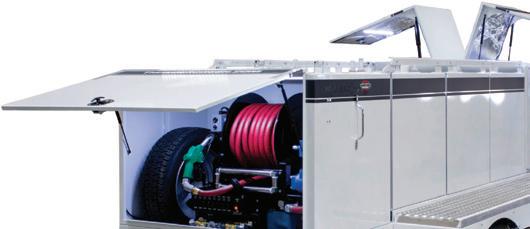
Stellar has introduced its next generation of Single-reel Utility and Telecom Trailers. The new trailers feature a refined look, heavy-duty rear tail light boxes and chock blocks standard with every trailer. All new trailers have been certified by the National Association of Trailer Manufacturers (NATM). Stellar’s lineup of single-reel utility and telecom trailers, formerly known as Roose utility construction trailers, includes models RR-135, RR-160, RR-185 and RR-200. Stellar Single-reel Utility and Telecom Trailers are designed to help boost the effectiveness of cable removal and cable laying processes. With just one reel and a lower setup, these trailers have a low center of gravity and are designed for basic operations and safety. In addition, they provide a way to keep cables contained and organized on the jobsite to prevent them from getting tangled or damaged. Stellar Single-reel Utility and Telecom Trailers offer load capacities ranging from 3,500-lbs. to 14,000-lbs., along a wide range of reel capacities.

Titan International has introduced the new Titan HK 458, a crossover wheel loader tire designed for extreme loader applications that require aggressive traction and excellent self-cleaning. The E-4/L-4 dual-rated bias tire combines the tread design of a forestry tire, a wheel loader tire and an ATV tire all in one, making it suited for both muddy, challenging construction sites and agriculture applications, where the sludge and muck are endless.
• A touch screen tablet for remote control and configuration
• A portfolio of inks for different surfaces, environmental conditions and durability requirements





The CWL 532 bias tire offers dependable off-road performance and optimal traction for compact wheel loaders operating on mixed and soft surfaces.

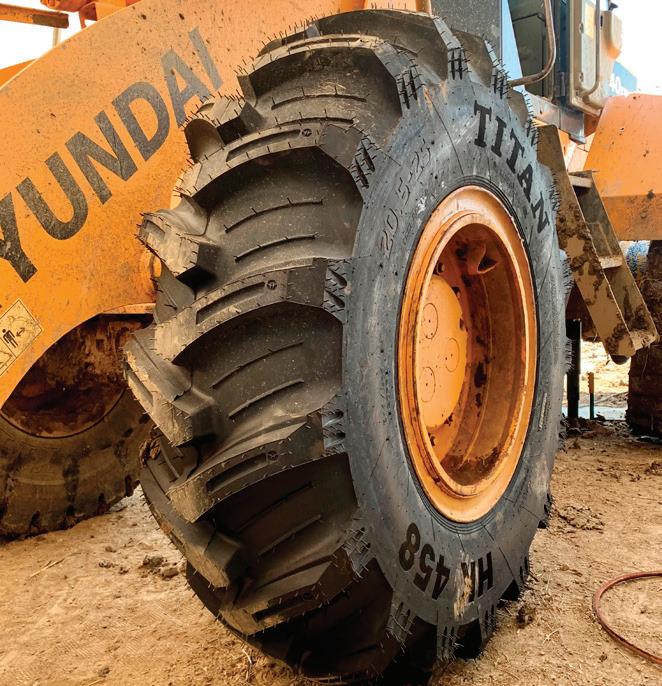
• Void guard tread protection provides more rubber to reduce the risk of impact-related punctur






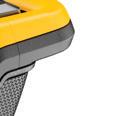
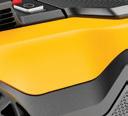
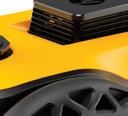


• Impact guard and rim guard enhance sidewall and rim flange protection
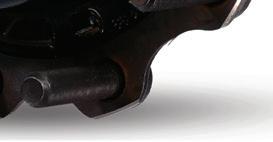

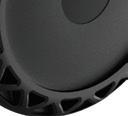

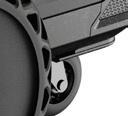
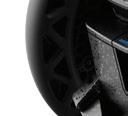
• Enhanced tread depth with curved lugs ensure traction and great durability
• Offered in 12.5/70-16 (ply rating 6 or 8) and 15.5/60-18 (ply rating 8)
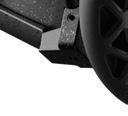





Trelleborg's newest tire for earthmoving applications, the EMR1031, designed to perform on sand, rock and other extra hard surfaces. Manufactured using a cutresistant compound, the tire has sidewall protector for damage protection and longer tire life, with a multi-surface tread design for improved traction. Its cut-resistant compound is 20% more resistant to cuts and wear, reducing machine downtime and resulting in lower operating costs. The deep tread pattern offers longer tire life, enhanced grip and self-cleaning action during use, even on sandy or muddy terrain. To reduce environmental impact, the EMR1031 tire comes with a retreadable casing.
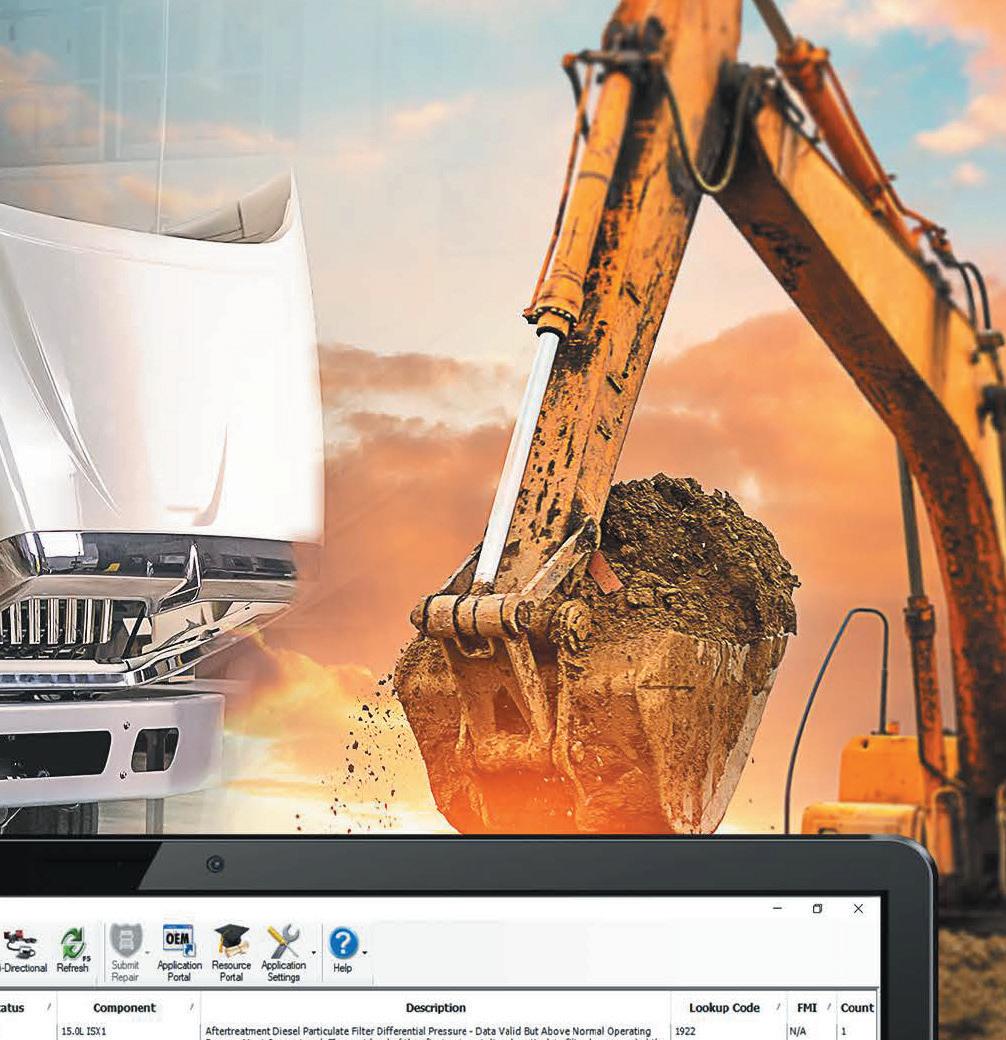
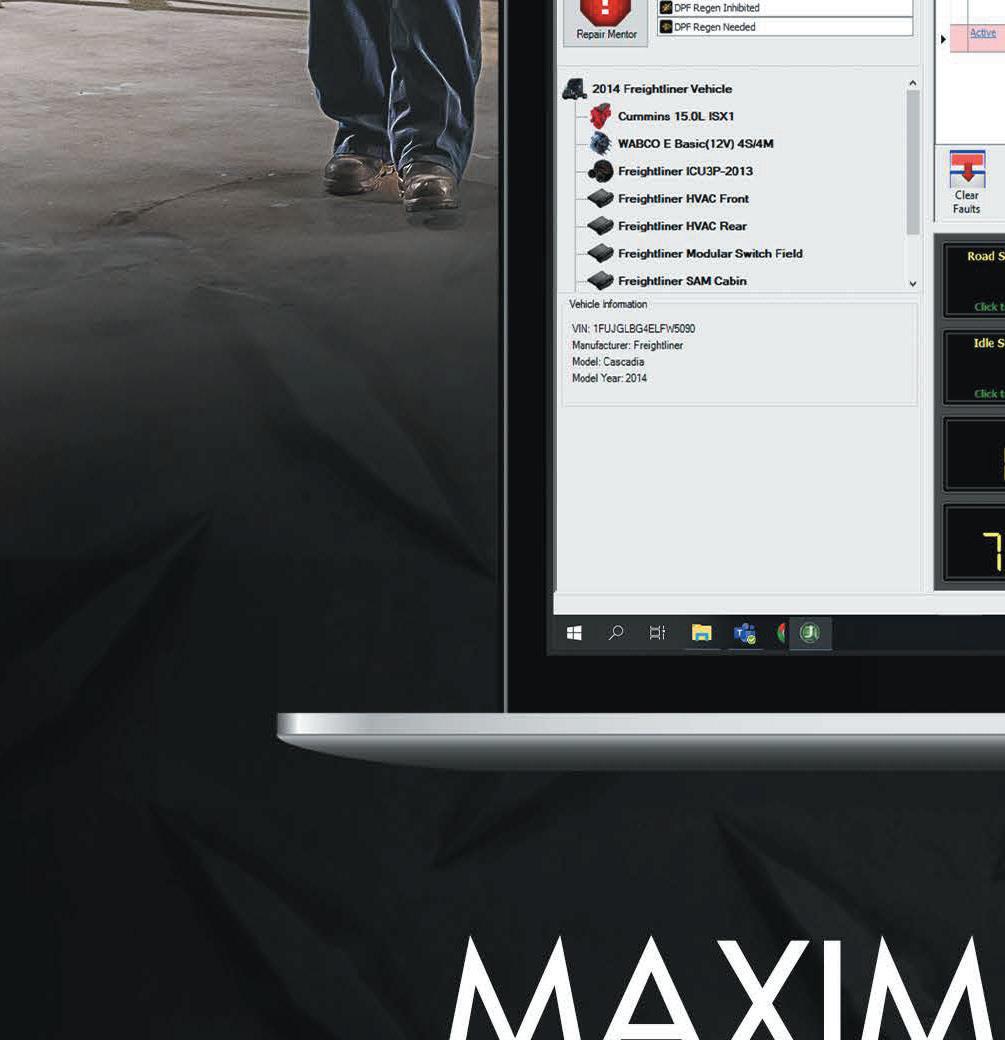
MICHELIN MEMS Lite is an entry-level tire MEMS solution that combines Michelin’s liquid-proof sensors to deliver periodic tire pressure and temperature readings. Tire sensors are mounted inside the tires, where data is captured as vehicles drive by fixed reading stations strategically located at the mine site. The data is then sent remotely to connected devices through a local server or secure cloud server. MICHELIN MEMS Lite requires no hardware installation on trucks. It is a tire monitoring solution that adds both safety and savings to operations, giving operators control of their equipment and making it a reliable solution for mine owners. MEMS Lite helps mine operators strengthen safety by monitoring tire pressure and temperature remotely, keeping personnel at a safe distance from equipment.

Rotary has unveiled new fuel stabilizers and treatment additives for small engines. A complete line of products is featured in Rotary’s 2023 master parts catalog including STA-BIL, Ethanol Shield, PRIG, Sea Foam, B3C, Helix and pre-mixed VP Fuels. Among several new items is Techron, a fuel treatment for powersports and small engine fuel systems that stabilizes fuel for up to two years with corrosion protection. The alcohol-free formulation cleans carbon deposits, dissolves gum and varnish buildup while preventing new deposits from forming. Fuel stabilizers from Rotary are designed for lawn mowers, chain saws, trimmers, snow blowers, generators and other types of 2- or 4-cycle engines. Gasoline can decay in as little as 90 days. Additives help preserve gasoline and prevent corrosion and gum or varnish buildup from ethanol blended fuels.


Use for prolonged storage or at every fill up to remove moisture and clean carburetors, fuel injectors and intake valves for reliable engine performance and fuel economy. Rotary’s stabilizers and additives are available in a variety of sizes, from 4 oz. bottles to one-gallon bulk containers.
Rotary’s parts catalog is free for servicing dealers and distributors, and available to download at rotarycorp.com. Backed by a warranty, Rotary offers a wide range of outdoor power equipment parts and accessories for lawn mowers, trimmers, chain saws, brushcutters, pressure washers, snow blowers, garden tillers and more.

Eberspaecher has developed solutions for thermal management designed for battery-powered construction vehicles and machines. The products include Xellstor energy management systems, a vehiclespecific heat pump for both heating and cooling, electric thermal management solutions and Airtronic and Hydronic fuel operated heaters.

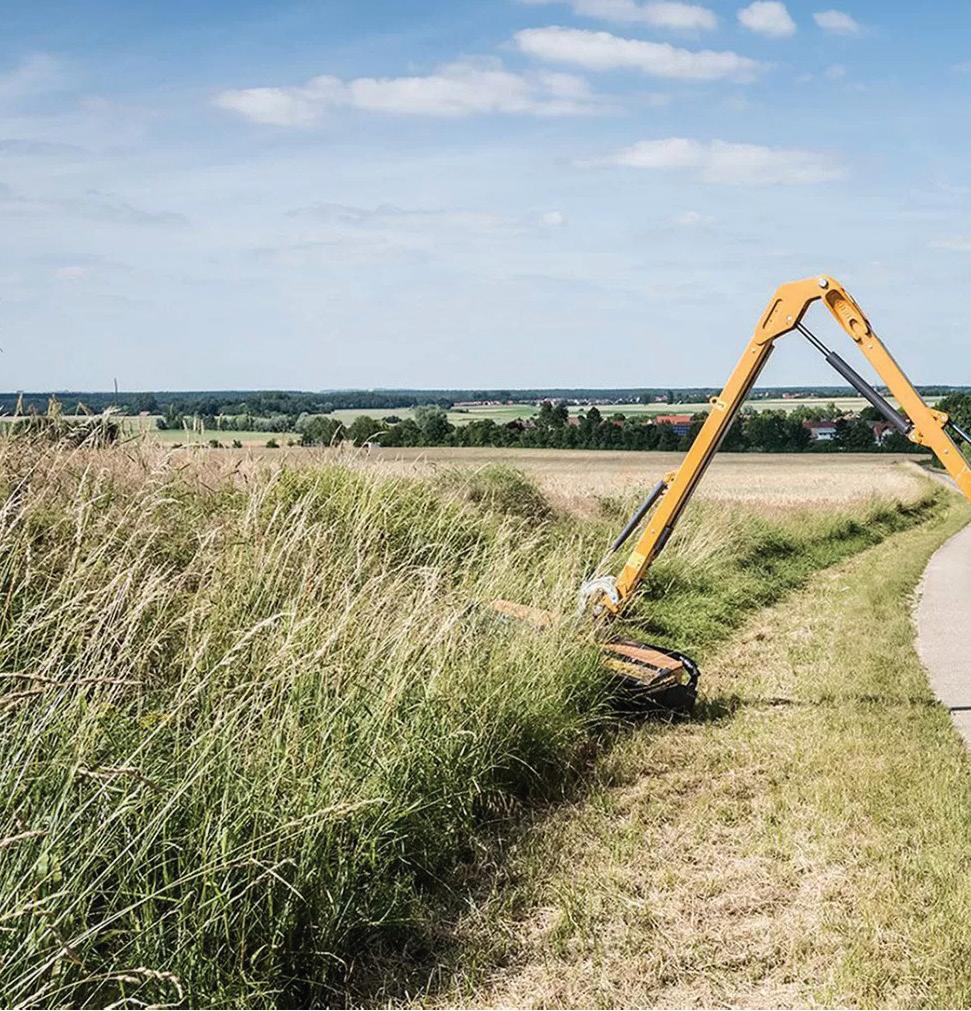

Tire Tread Scanner works by pointing the camera on any standard mobile device at the tire tread to be measured. Using computer vision and AI, a 3D model of each tread is created, resulting in a digital measurement that can be stored and shared. The solution can be integrated into workforce or consumerfacing apps, meaning that tire technicians and customers alike can start scanning tire treads without training. Anyline entered the automotive market in 2020 with the launch of a DOT/TIN scanner. Created in partnership with Discount Tire, an independent tire and wheel retailer, this solution enabled its technicians to digitally capture vital tire data.


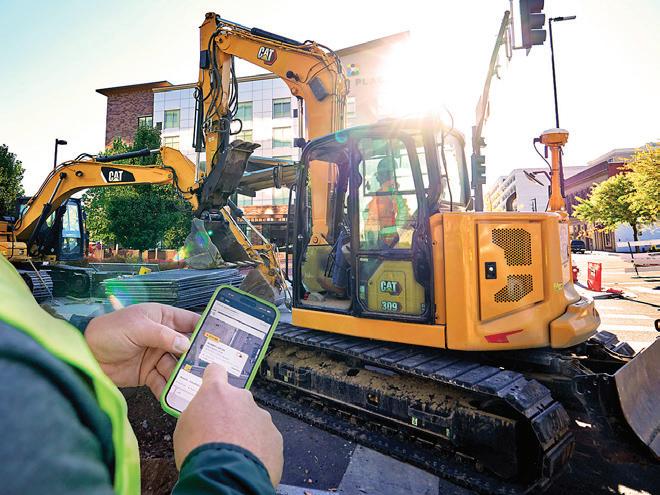
The new HTH-1400 Hanging Tire Handler from LiftWise is a high-capacity machine for handling, controlling and maneuvering tires for reliable installation, removal or maintenance. With a capacity to lift tires weighing up to 1,400-lbs., the HTH-1400 is adjustable to handle tires between 30-in. and 53-in. and diameter, and up to 19-in. in width. The design of the HTH-1400 allows a tire to be positioned by a single operator for various applications. The unit

BKT has developed the RIDEMAX FL 615 radial flotation tire is designed for free rolling wheels of trailers, tankers and spreaders.
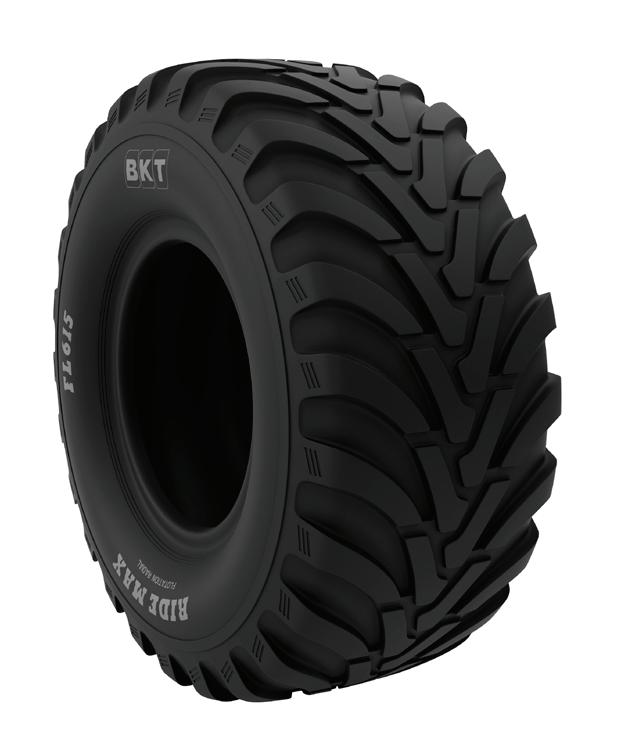
As a U.S. product introduction, HELLA presented a brand-new C240 LED combination headlamp to the broader public for the first time at CONEXPO. The combination headlamp features several functions, such as low beam, high beam, position light, daytime running light, hazard warning and front turn signal. The housing and lens are made of impact-resistant plastic. The combination headlamp is also vibration-resistant, dustproof and waterproof. A DEUTSCH DT connector and an ISO pulse indicator failure check supports functional safety requirements. In addition, the C240 is available in both ECE and SAE versions.
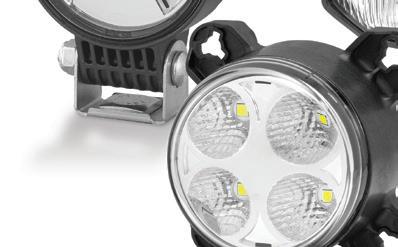
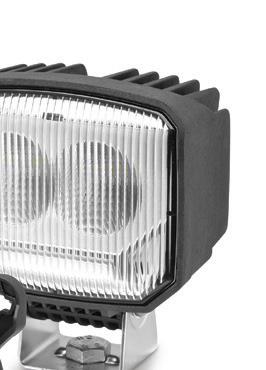

The new VisionLink provides an integrated full-fleet management solution for asset tracking to maximize machine uptime and optimize utilization. The interface helps customers manage their entire fleet, regardless of manufacturer. Improved asset insights retrieve a broader range of data from owned, leased or rented equipment and attachments, allowing companies to make better informed asset management decisions. Cloud-based and accessed through desktops, tablets, and mobile devices, new VisionLink consolidates My.Cat.Com, the Cat App, and the previous version of VisionLink applications into one centralized solution for fleet management.
securely clamps to the tire and can rotate it 90 degrees from a horizontal position to a vertical position, and back again, allowing tire assemblies to be delivered to the machine flat on a pallet. Also, a 25-degree bi-directional tire rotation ability makes for easier alignment of studs with the tire bolt pattern. Adjustable pins further allow correct tire orientation.

VERSATILE PROFESSIONAL CONTRACTING TIRE FOR YEAR-ROUND USE
Nokian Tyres TRI 2 excels in a wide variety of tasks from job sites to highways, from snowy winters to hot tarmac. Its durability, economy and comfortable driving response make it a reliable choice for versatile contracting work.


nokiantyres.com/heavy

Developed for telehandler applications lifting up to 12,000-lbs., Dana’s new driveline comes equipped with a compact Spicer 312 dropbox for high-power hydrostatic motors. This new hydrostatic dropbox functions as a continuously variable transmission without torque interruption and delivers performance for movements at low speeds, reduced fuel consumption and an integrated spring applied hydraulic release parking brake. The transmission is designed to be coupled with the Spicer 222 front and rear heavy-duty axles, which each feature a limited-slip differential and provide the customer with maintenance-free brakes. Dana optimized the axles and driveline system for supporting a variety of architectures, allowing customers to retain the same driveline solution while choosing between implementing a hydrostatic dropbox or electrically driven design. From single-and two-speed dropboxes to shift-on-fly and powersplit transmissions, Dana offers a range of hydrostatic transmissions that enable customers to leverage solutions for their specific vehicle’s duty-cycle requirements.



Goodyear has introduced the RangeMax RSDEV, Goodyear's first electric vehicle-ready tire compatible with EV and gas- or diesel-powered regional work vehicles. Equipped to handle the high load capacities of EVs, RangeMax RSDEV was engineered to deliver low rolling resistance for fleets regardless of drivetrain. Engineered with Treadlock Technology to promote even wear and long miles to removal, RangeMax RSDEV is the first regional drive tire embossed with Goodyear's "Electric Drive Ready" designation. Available now in size 295/75R22.5.
Armorgard offers the SiteStation, which serves as a mobile office for temporary jobsites and projects. This solution can be used for storing and viewing plans and maps on construction sites. It can even be a central hub and meeting point. Individuals can utilize lighting, UL approved power supply and additional storage on the SiteStation. It features fitted shelves and compartments that allow for organization, providing access to equipment, drawings and documents. Electrical tools and portable devices can also be locked up and charged on the site.


Bridgestone Americas showcased its latest products and solutions from its Off-the-Road (OTR) construction and quarry portfolio at CONEXPO-CON/ AGG (CONEXPO) in Las Vegas.


At CONEXPO 2023, Bridgestone will spotlight the three pillars of its OTR business:

• Intelligent Products:

Bridgestone will preview the new VZT construction tire as well as spotlight its full lineup of products, including the VMTD three-star quarry tire
• Integrated Technologies: As part of its full suite of mobility solutions, Bridgestone will feature IntelliTire, a remote-health monitoring system, and Toolbox, an asset-tracking platform, as data-driven solutions that can help construction fleets with their operations


Cummins debuted its new fuel-agnostic 15-liter engine platform with hydrogen, natural gas and advanced diesel engines offering lowto-zero carbon fuel capability. The next generation engine is designed to accelerate the decarbonization of heavy-duty off-highway applications. The fuelagnostic architecture of the 15-litre platform utilizes a common base engine with cylinder heads and fuel systems specifically tailored for it to use carbon-free hydrogen or biogas with up to a 90 percent carbon reduction. Cummins’ 15-liter hydrogen has ratings up to 530 hp (395 kW) and natural gas up to 510 hs.

The 8X8 was designed to transport heavier payload or additional crew in harsh terrains. The 8X8 will be used by the utility industry to facilitate working in hard-to-reach jobsites. The 8X8 will be available in two variations: HAULER and WAGON and supports market demand for an amphibious vehicle that can carry a high payload of 5,000-lbs. (2,262 kgs) or a crew of 16 workers. The vehicle is capable of traveling at 25 mph (40 kph) on land, 3 mph (5 kph) on water and climbing steep muddy hills (75% grade). The footprint of the 8X8 is 1.9 psi at its maximum payload. The articulation allows the vehicle to climb vertical walls of 4 ft. (1.22m).

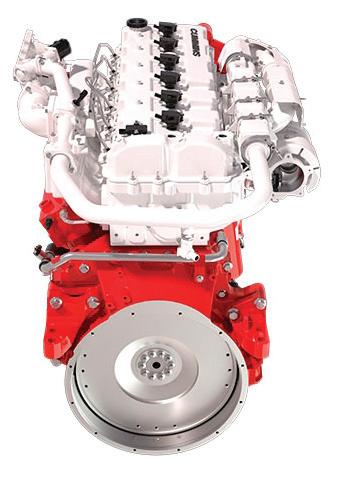
The Powerpack is a palletized drop-in power unit that simplifies installation and design engineering for OEMs. Available in outputs up to 207 hp (155 kW), the Powerpack offers OEMs a path to design and package their diesel power solution. At the heart of the Powerpack is the 4TN107FTT inline 4-cyl. diesel engine. The powerful 4.6 L diesel was first unveiled at bauma in 2019 and meets EPA Tier 4 final and EU Stage 5 exhaust emissions regulations. The 4TN107FTT features twostage turbocharging, with a low-pressure turbocharger raising power at higher speeds and a high-pressure turbo boosting output at low engine speeds.

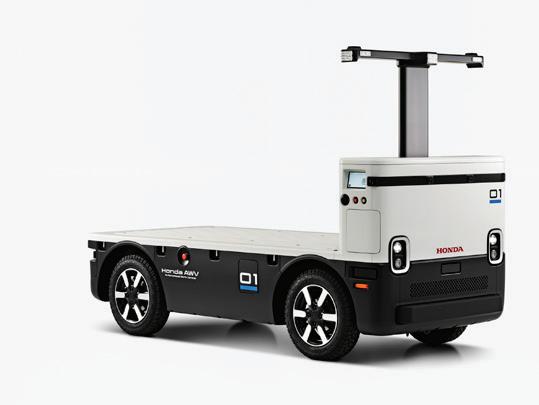
The fully programmable all-electric Honda AWV leverages the company’s emerging advanced autonomous technology to create a rugged off-road work vehicle that is designed to support construction-related activities. With the ability to operate autonomously – or manually via remote control – the Honda AWV could provide a wide range of services to industries that need autonomous operation or delivery solutions, especially where workforce constraints make other solutions impractical.
The AWV size is capable of accommodating two pallets with a loading capacity of 2,000 lbs.
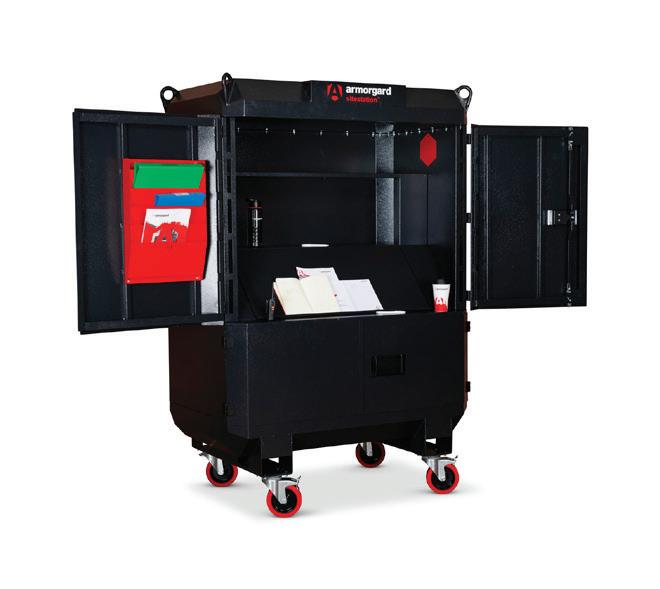

ActiveCare Direct Advanced Telematics from Volvo Construction Equipment
End users can simplify their work with ActiveCare Direct advanced telematics from Volvo Construction Equipment. Rather than sending a stream of confusing fault codes, ActiveCare Direct collects and analyzes telematics data and prioritizes issues that require immediate attention. Then, it sends clear and concise alerts about top priorities. Rental companies can get both real-time insights and monthly reports to easily understand what is happening with their machines, saving you time and protecting their bottom line.




Nestled in the rolling hills of small town Wisconsin lies Road America, a racetrack unlike any other in the world. The 4.048 mile track features 14 turns and sits on 640 acres of land with natural slopes and superelevation changes that thrill racecar drivers and enthusiasts alike. The track hosts dozens of races each year and countless other community events, making it a truly unique — and busy — piece of the racing world.
Last paved in 1995, the Road America course was due for a makeover. The track has deep roots dating back to 1955 however, and the team at Road America, along with fans of the track, didn’t want to see any major changes made to this historic course.

“The initial design was the vision of Clif Tufte. He wanted to evoke the essence of the surrounding roads and how road racing courses were laid out when the sport began. Complete with high speed straights, sweeping turns and several types of elevation,” John Ewert, communications director at Road America said.
“Clif walked the land and staked out the configuration himself. Making sure to not change the existing landscape or topography,” Ewert added. “What fans see today is the same configuration as in 1955 and we wanted to make sure we didn’t tarnish that history when we made upgrades to the course.”
To ensure racing history was preserved at Road America, discussions and preparations began years before any repaving would begin. Road America wanted to take the opportunity to give the entire facility the upgrades it needed and worked with Northeast Asphalt, a Walbec Group company, to get the
For the surface course design, the Walbec team worked with NASCAR engineers to help determine the best mix and process for installation.
Road America
Last paved in 1995, the Road America course was due for a makeover. The track has deep roots dating back to 1955 however, and the team at Road America, along with fans of the track, didn’t want to see any major changes made to this historic course.
extensive project moving.
“Walbec has a long history of success with Road America. Some of the team members who worked on repaving the main track in 1994/1995 are still with the company and worked on the repave in October,” Heather Sayler, project manager at Walbec said. “Walbec has partnered with Road America on their go-carting track, repaving the corners on the Road America track as well as numerous track maintenance projects and other paving contracts on the property. The course repave was one we were all excited about.”

Officials also wanted to take the opportunity with the repave to update the drainage system in eight areas by switching out worn metal culverts with DOT plastic culverts. They also upgraded pitlane infrastructure and updated spectator areas. All work Walbec was able to help facilitate.
“On this extensive project, the Walbec Group was able to provide all the services needed, from managing the quality of the aggregates, asphalt mix, testing, and paving, as well as the engineering for drainage and pipe work installation,” Sayler said. “The team also has experience paving other tracks like the Milwaukee Mile.”
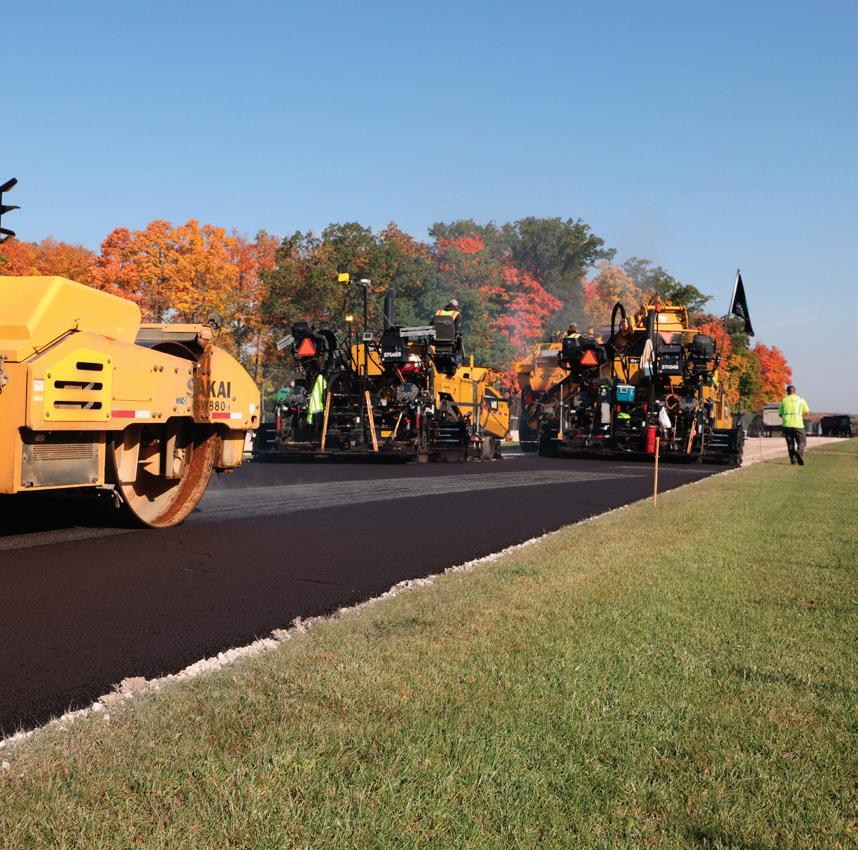

During preparations for this repave, the Walbec team worked to identify and document the uniqueness of the track in 2021. They completed a topographic survey to record and study existing track geometry and placed 18-inch long rebar, 6-inches below the track, to create 25 survey control points.
The entire survey consisted of 7,261 total data points to study the surface of the track and some drainage areas, allowing Walbec to complete
Approximately 7,890 tons of asphalt was put down on the surface course and multiple tests were performed throughout the project to ensure the surface would handle the weather and racing stresses.
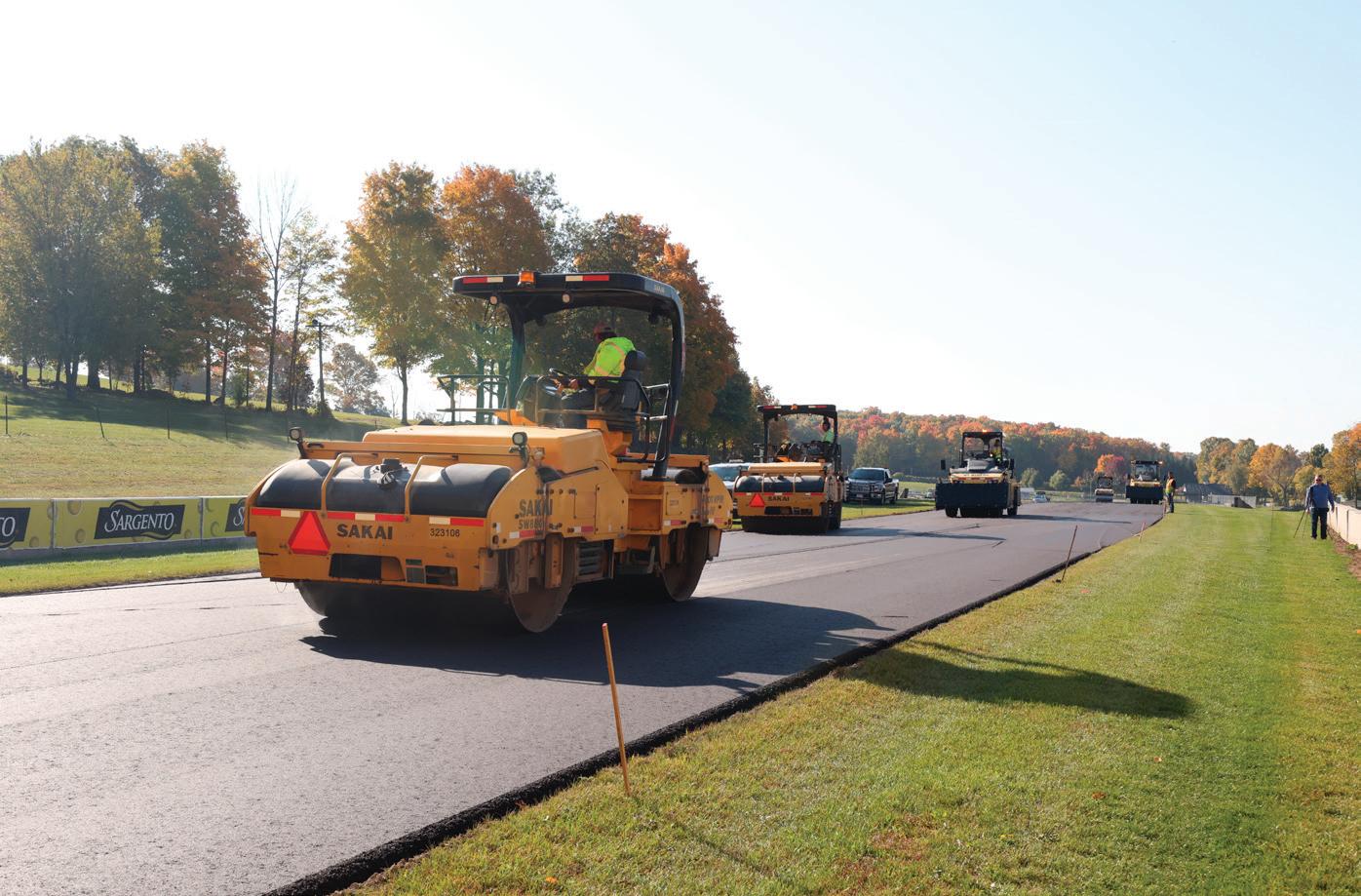
massive amounts of prep work before any paving would begin.
Finally, a drone survey was completed to provide high-quality aerial images for further planning purposes. The survey backed up the field work Walbec did while also verifying timing loops and markings along the track.
To prepare the track before paving, Walbec removed 4-inches of old asphalt from the track. Approximately 20,360 tons of asphalt was milled and hauled away from the site.
The entire track was then fine graded to maintain the existing character of the raceway. The motorgraders used robotic technology, along with traditional staking, when completing the grade work. This helped to ensure the edges of the pavement, cross slopes, superelevation transitions and crown lines were all maintained and would stay true to the original track.
“The elevation of the Road America track is unique, and our team worked extremely hard to ensure the existing grades and layout were going to retain those distinctive features of the track,” Sayler said. “We wanted to put everything right back where it was.”

They also wanted to ensure that the work they did would provide years of life for the track, and to do that they needed the right mix and the right processes throughout every step of re-pave.
Like any race track paving project, a lot of research and planning goes into the mix design of the asphalt put down and that started with the rocks. At Road America, the aggregate and asphalt components were sourced from all over the state of Wisconsin.

The work at Road America was amazingly completed in a month’s time from removal of the old surface on Oct. 3, 2022 to the ribbon-cutting ceremony Nov. 3, 2022, commemorating the project’s conclusion. In all, the full project cost to complete the upgrades at Road America will total more than $4 million.
Road America
“This is really fancy asphalt,” Sayler said. “Aggregates were sourced from different locations in the state in order to meet strength requirements for longevity. The mix needs to hold up to the heat and friction of the race cars when they are on it and it needs to survive our winters.”
For a year and a half before paving began, Walbec tested materials. At their Wisconsin locations, they processed and stockpiled the right aggregates for this mix so they were ready when mix production needed to begin at the end of October 2022.
The 2-1/2-inch base course installation began on Oct. 10, 2022. Crews put down 12,500 tons of this 19mm mix.
“This was a standard 3 MT 58-28 mix for the lower layer,” Sayler said. “This is a mix you’d see out on the highway, but we are using a beefed up V oil which is a heavy traffic, very firm oil.”

Track Length: 21,373 ft.

Asphalt Width: 30 ft.

Front Straight: 4,400 ft.
Number of Turns: 14
Elevation Change: 205 ft.
Curve Radius: Varies from 62 ft. to 455 ft.
Maximum Grade: 12%
Total Track Acreage: 640
For the surface course design, the Walbec team worked with NASCAR engineers to help determine the best mix and process for installation.
“We came up with a mix that was similar to other road courses, but still designed for this specific location,” Sayler said. “The mix is a 9.5mm virgin mix with 82-28 polymer modified asphalt. We put that down at an inch and a half.”
The crews paved in echelon to avoid any cold center joints and minimize center seam visibility. Approximately 7,890 tons of asphalt was put down on the surface course and multiple tests were performed throughout
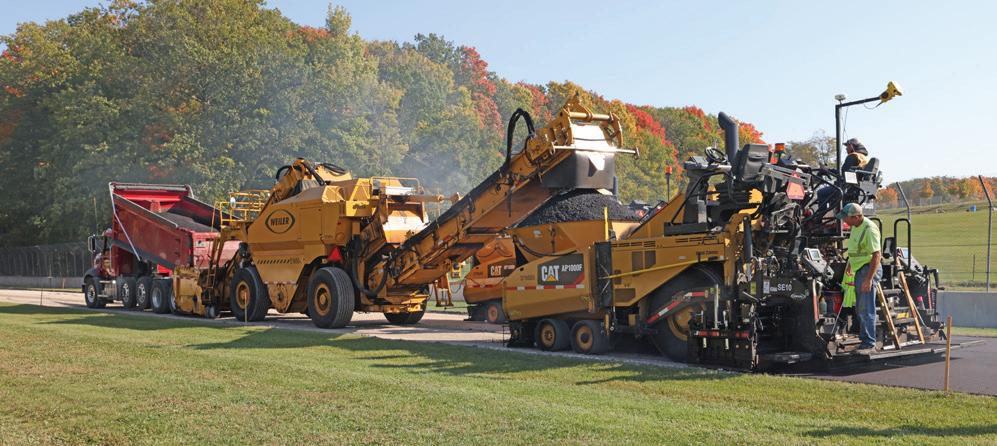

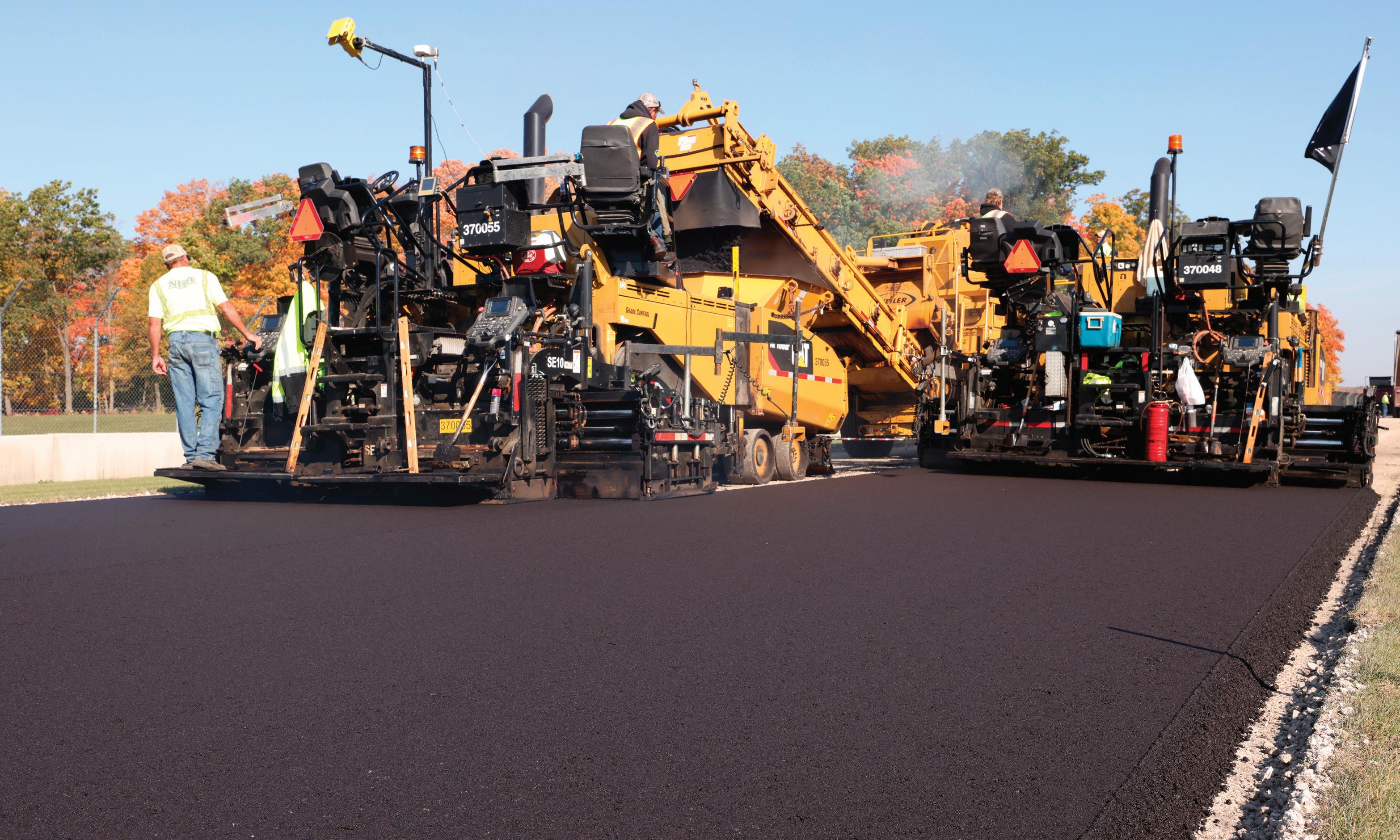
the project to ensure the surface would handle the weather and racing stresses. The special polymer mix required an agitation tank at the plant which Walbec produced at their Larsen location, 67 miles from Road America.
The work at Road America was amazingly completed in a month’s time from removal of the old surface on Oct. 3, 2022 to the ribbon-cutting ceremony Nov. 3, 2022, commemorating the project’s conclusion. In all, the full project cost to complete the upgrades at Road America will total more than $4 million.
“This is a massive endeavor, and we are extremely excited to have a new racetrack for competitors and fans
Like any race track paving project, a lot of research and planning goes into the mix design of the asphalt put down and that started with the rocks. At Road America, the aggregate and asphalt components were sourced from all over the state of Wisconsin.
Road America
to enjoy,” Ewert with Road America concluded. “The goal was to keep it the same as our founder Clif Tufte envisioned, and we’re certain we met that goal.”
Read more at: https://eqtoday.co/dzqx6q
As reality capture technology
When most construction project managers think about using reality capture on the jobsite, productivity and costs are top of mind. From a productivity perspective, a recent survey conducted by the National Association for Women in Technology (NAWIC) asked construction professionals about the impact of new technologies designed specifically for the jobsite. Of the more than 300 survey respondents, 95% reported being more productive. Yet justifying the cost is often another matter.
As fear of a recession looms and the construction staffing shortage shows no signs of improving, with the Associated Builders and Contractors reporting the industry will need more than half a million workers above its current pace of hiring in order to meet demand, justifying the cost of reality capture technology is more challenging. It really comes down to determining how quickly the product will pay for itself.
First, let’s understand what reality capture is and what it can do for a construction company. In the simplest terms, reality capture uses laser scanners to quickly and accurately capture a physical space and replicate it in a 3D virtual environment.
On construction jobsites, reality capture is used to build 3D models of a space or structure. This reduces unnecessary return trips to remeasure a space, and supports greater collaboration and efficiencies among teams on a jobsite and those in the office. At a time where remote work is on the rise, reality capture is especially useful for monitoring the progress of a project, comparing as-built models with design-intent models, and addressing any potential issues before additional resources are spent on the actual build.
More recently, advances in autonomous reality capture made it possible to scan hard to reach areas using robotics and unmanned aerial vehicles (UAVs). For example, capturing the top of a skyscraper, conducting an underground excavation and exploring areas impacted by natural disasters are

ideal for autonomous reality capture because they don’t require workers to physically enter the spaces. But who is actually using this technology?
Historically, reality capture was primarily used by larger construction firms. This changed as more devices came on the market, offering a wider array of options in terms of size, functionality, price, autonomy, and how easy they are to master. Also, when the reliance on third party scanning specialists was not as necessary, reality capture devices became more common on jobsites managed by small to medium sized construction firms.
While there are many uses for reality capture technology on a jobsite, some general contractors may not see an immediate and/or high return on their investment. This often happens when the wrong tool is used for the job. The biggest variables in pricing for reality capture products are based on accuracy, scanning distance, speed, and quality of output. Yet not every job requires the highest accuracy and highest quality output. Depending on the needs of the client, a lower cost reality capture product will suffice.
On the other hand, sacrificing long term gains for short-term cost savings is not a wise investment either. This is why general contractors and project managers look across their project
management dashboard and consider the five factors below before buying a reality capture product.
To determine if and when an investment in autonomous reality capture will deliver the anticipated ROI, contractors should evaluate the product and cost based on the following five factors:
➊ Staffing: Consider the efficacy of using autonomous devices to fill worker shortages on jobsites, reduce the reliance on third party consultants, and eliminate the expense of having to return to sites to retake measurements.

➋ Greater efficiencies: Gained through greater collaboration between workers on jobsites and colleagues in the office saves time and costs, resulting in more satisfied clients and higher employee retention.
➌ New market opportunities: Easy to use allows contractors to expand into new areas such as manufacturing, utilities, or the conversion of commercial buildings into mixed use or residential spaces.
➍ Detailed documentation: Can be used for future projects at the site, adjacent projects in the
















































As reality capture technology is more commonly used on construction jobsites, by firms of all sizes and workers at all skill levels, decision makers are constantly evaluating the upside of the investment. ©metamorworks – stock.adobe.com
neighborhood, city planning, and courtroom evidence, dependent on the needs of the project.
➎ Safety risks: Determine the potential safety risks, liabilities, OSHA fines, and insurance premiums associated with workers or subcontractors having to enter difficult to reach places or areas with the potential for safety hazards.
As reality capture technology is more commonly used on construction jobsites, by firms of all sizes and workers at all skill levels, decision makers are constantly evaluating the upside of the investment. Like any construction project, it requires the right tools for the right job. Since the industry offers lots of options, it’s important to weigh the features and benefits of each reality capture device against the needs of clients and your business before making an investment.
Read more at: https://eqtoday.co/realitycapture
is more commonly used on construction jobsites, decision makers are constantly evaluating the upside of the investment.Andy Fontana is a technical specialist for Leica Geosystems.

The Wheel Loader Simulation Training Pack includes advanced earthmoving techniques as well as guided learning features for faster skills acquisition.
• Real-time feedback during exercises
• Real-time Grade Quality Sensor (GQS) tracks metrics like height, slope and standard deviation


• Highly realistic bucket/ground interactions with advanced earthmoving techniques
• Tracks all operating metrics during training exercises and rolls them up into a single customizable scoring system updated in real time
Cat Command for Loading remote control system now allows for semi-autonomous remote operation of the 926M, 930M and 938M small wheel loader models.

• Allows user to comfortably control the machine from a safe location, providing the same control response as operating inside the cab
• Dealer-installed field kit makes the loaders Command-ready
• Rear and side cameras, electricover-hydraulic steering system and Command activation lever mounted on machine for ground-level access
• Cameras, indicator lights, microphone, wireless receiver and antenna installed on the cabin roof
Augmenta has announced the Electrical Design Module, which enables contractors to accelerate the time it takes to estimate and create fully constructible, code-compliant electrical raceway designs by automating the entire process. While today’s shop drawings typically only model the main runs of an electrical distribution system, the Augmenta Construction Platform can create fully detailed designs for entire projects in hours instead of weeks or months. Using Generative Design, the Electrical Design Module for the ACP delivers accurate, National Electrical Code (NEC) compliant, detailed 3D raceway designs, complete with a bill of materials.
Virtual Technology Simplified (VTS) announces the launch of 360Capture, a data service that enables reality capture of buildings and structures with an iPad or iPhone, to populate a digital representation (digital twin) of assets. The app captures spaces to transform data, from a property or asset, into actionable information for customers managing large scale infrastructure in telecommunications and utilities. 360Capture produces reality information with results comparable to traditional laser scanning devices. 360Capture allows companies to capture condition and spatial information of assets. Companies can choose to have their field workers capture this information or use VTS’ expert capture crews to populate their digital twins. Costs are managed by eliminating the need for specialized equipment.
Leica Geosystems, part of Hexagon, has launched a new safety awareness module in the cloud-based collaboration platform Leica ConX. The integration of Leica Geosystems’ safety awareness solutions with ConX caters to safety on construction sites by collecting and visualizing data for awareness, hazard response and insights. The module integrates field-generated safety data into the cloud-based collaboration platform Leica ConX, allowing decision makers to review incidents and assess the entire operation over time and space. These insights support safety initiatives by providing visualization, analysis, monitoring, reporting and data management functions, as well as address communication and integration needs.
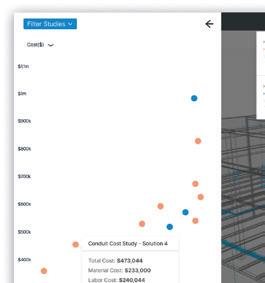

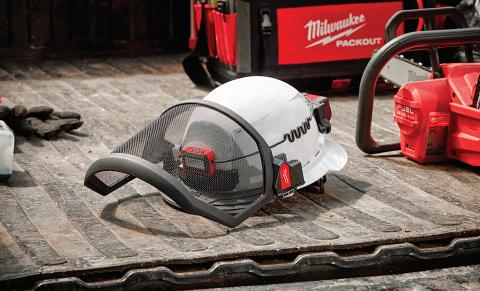
Milwaukee BOLT is a system that allows users to secure safety accessories simultaneously for a thorough head protection solution. Eye visors, polycarbonate face shields, metal mesh face shields and the BOLT REDLITHIUM USB headlamp are joining the BOLT safety lineup. The new BOLT eye visors are designed for proper fit and headlamp
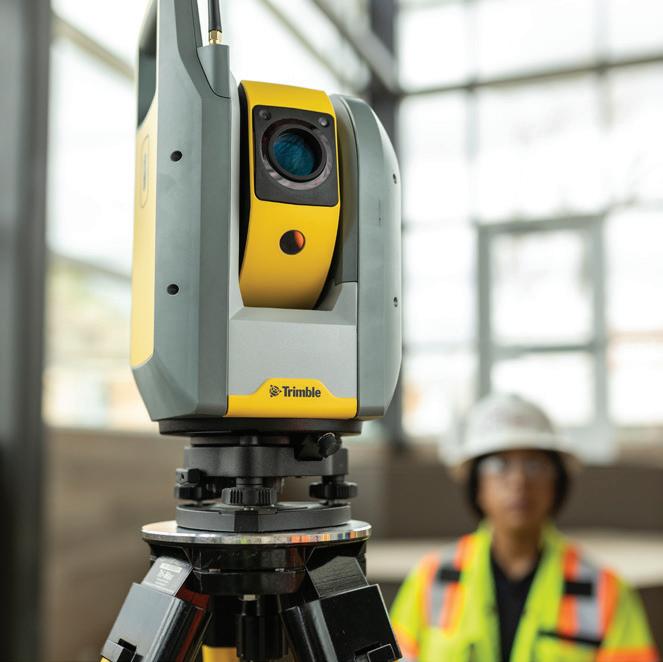
A1A Software LLC has released the first two lift planning tools in its new applicationbased A1A Product Suite. Rigging Designer enables users to create custom rigging plans and Sketch Pad provides a way to sketch preliminary job site data for bids and estimates. Each of the apps can be used individually or as part of the entire Product Suite. Rigging Designer is designed for any application where loads must be rigged, whether that’s for lifting by a mobile crane, overhead crane, a gantry or industrial forklift. Point/Click and Drag/ Drop functionality can be used to create custom rigging designs. Rigging Designer and Sketch Pad are available through Microsoft, Google Play or the Apple App Store.


HOVER is offering its entire 3D measurement and takeoff solution for new construction jobs with the ability to upload blueprints. Now, contractors can secure the same 3D models with exterior measurements that HOVER provides from smartphone photos through blueprint designs. HOVER supports both the improvement of existing structures as well as ground-up new construction projects. HOVER’s new construction solution transforms blueprint plans into scaled 3D models with measurements for property exterior, takeoff, proposal and ordering features in the HOVER platform.

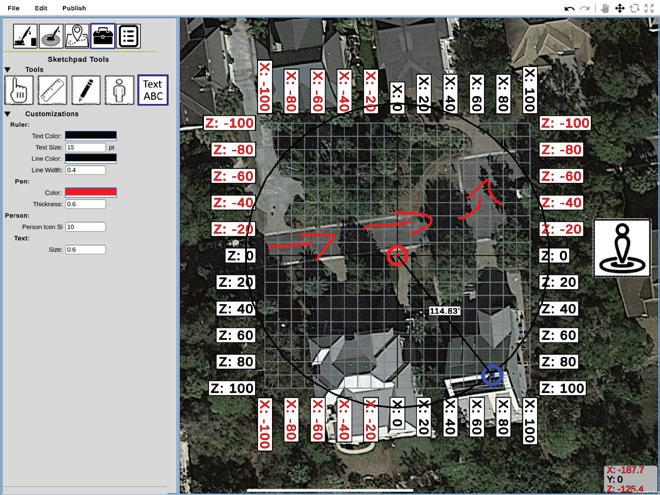
use, are classified as spectacles and can be used in place of safety glasses with a Z87.1+ rating. Milwaukee’s BOLT full face shields are designed for visibility, featuring an ANSI Z87.1+ rating, a fogfree interior coating and an anti-scratch exterior hard coating. Constructed with highly durable stainless steel, the BOLT mesh full face shield protects users from debris in chipping and cutting applications. These ANSI Z87.1 rated face shields feature an optimal shield width.
The Trimble Ri will be offered in multiple configurations to meet a diverse set of workflows for MEP, concrete, steel and general contractors. The base units can be scaled remotely via annual subscription licensing packages and software customization. . With Trimble VISION technology integrated digital cameras, the instrument can be controlled from anywhere on the jobsite and allows for target detection and lock. In addition, the self-calibration feature performs automatic calibrations as required and reduces the need to send the total station in for service.
Matterport has introduced the all-new Matterport Pro3 camera along with major updates to its digital twin cloud platform. The Pro3 is equipped with 3D capture technology and can be used indoors or outdoors. The new Pro3 camera and cloud platform were built for the demands of enterprises in the construction industry. These solutions enable customers to create immersive digital twins. The Matterport Pro3 Camera is equipped with a combination of sensors and creates images, both indoors and outdoors. With a custom 20-megapixel sensor and 12-element lens covering an ultra-wide angle, the Pro3 camera produces detailed digital twins.

Hemisphere GNSS, has announced the release of the GradeMetrix Loader solution. Recognizing the demand and versatility of the loader, Hemisphere has responded with this addition to GradeMetrix solutions to continue the growth of its global machine control customer base. GradeMetrix Loader kits will be available for purchase for new customers. Existing customers will have the option to add loader support to their current GradeMetrix system via a software upgrade and machine activation.


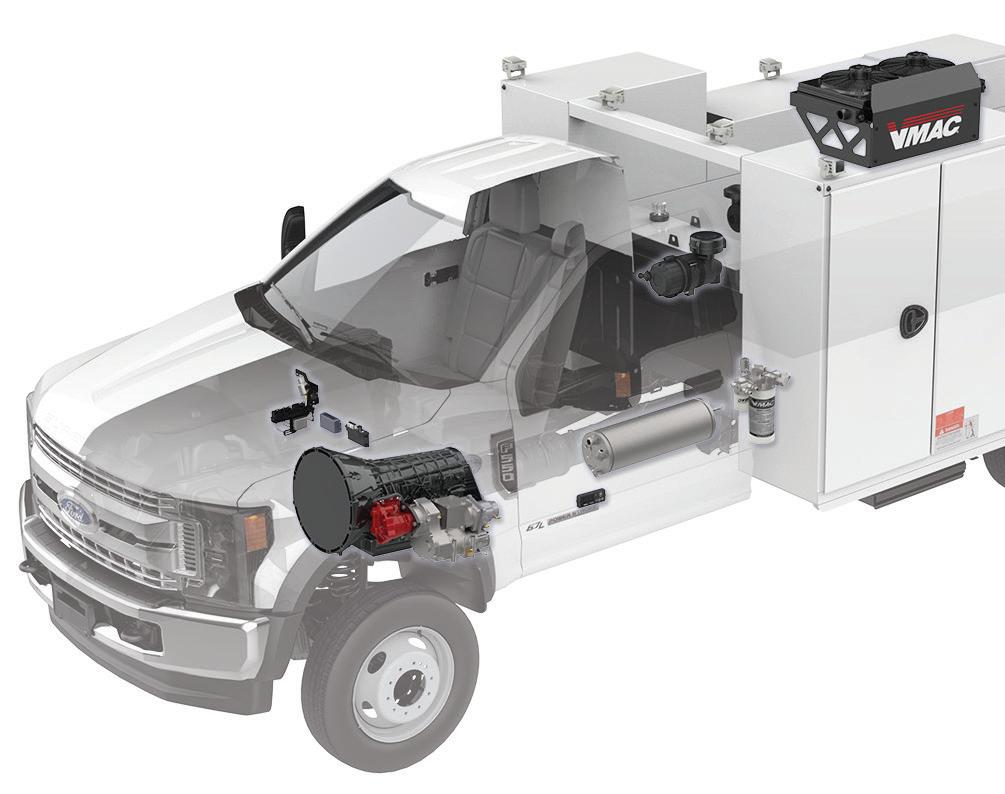
ConstructConnect, a provider of software solutions for the preconstruction industry, has announced a new partnership with Togal.AI. The collaboration will expand the use of machine learning and artificial intelligence in nonresidential preconstruction. Togal.AI uses machine learning to automatically identify, classify and extract object data from 2D blueprints. This can compress the time initially spent scoping a project by 50 percent or more based on recent user feedback.


Futtura offers a site management system solution for supervising tasks at construction sites. The universal construction site supervisor system, including the SiteMetrix Grade and the all- new multi-frequency, multi-GNSS F631 RTK base and rover, helps contractors manage activities at the job site. Contractors can use the Futtura system to localize sites, check grade, configure base stations, set stakes and calculate volumes of material removed. The F631 GNSS receiver is powered by Athena RTK technology. With Athena, F631 provides RTK performance when receiving corrections from a static base station or network RTK correction system. With multiple connectivity options, the F631 allows for RTK corrections to be received over radio, cell modem, Wi-Fi, Bluetooth or serial connection. F631 delivers centimeter-level accuracy and can be used in construction environments.






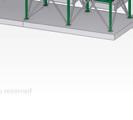



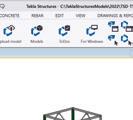

Trimble’s lates version of Tekla Structures (Tekla Structures 2023), include significant performance enhancements, enabling smoother information delivery on projects that are typically growing in both size and intricacy. Apart from several improvements in software performance, the upgraded drawing editing user experience makes the software easier to learn. In rebar detailing, complex bar shape designs are easier to share. Customers in steel fabrication benefit from greater flexibility by being able to cover more detailing options related to bolts and holes for specialized industries.


HCSS has announced integration with OnStation. This digital stationing platform provides location-based documentation for roadway builders. With OnStation integrated with HCSS HeavyJob, clients receive location-based field documentation (notes, pictures and videos) from along a roadway for design and construction purposes. Project-specific documentation supports the accuracy of bills, ensuring HCSS customers get paid the right amount and on time.

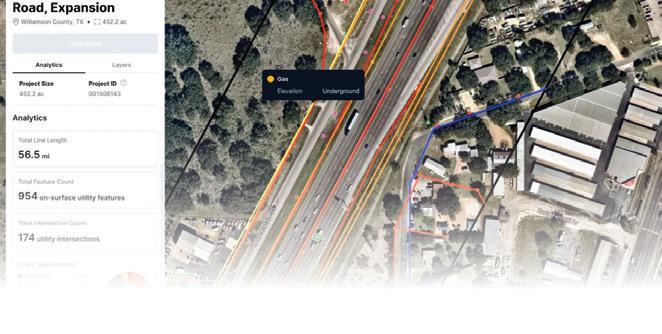

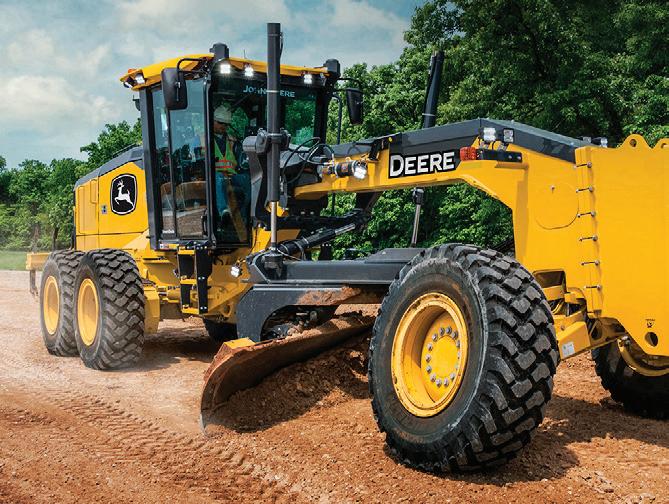
John Deere has introduced a suite of automation technologies at bauma 2022. Customers in various European markets can utilize several solutions, such as Premium Circle technology and the full John Deere portfolio of Grade Management capabilities. These fully programmable and versatile features are designed for construction projects.
4M Analytics, a company developing mapping products for infrastructure projects and construction sites, offers the 4Map solution for locating underground utilities including oil and gas lines, water pipes, electricity and telecommunications lines and renewable energy infrastructure. This software does not require hiring labor onsite. The company is in the process of making the data of underground utilities available through a single dashboard that will eventually cover the entire U.S. Using this, engineers will be able to see exactly where utilities are, no matter where in the U.S. they’re working, reducing the time it takes to locate them. The solution is designed for civil engineering firms, engineering procurement construction firms, contractors and subsurface utility engineering firms in industries including transportation, oil and gas, water and electricity, renewable energy, telecommunications and more.
“Our customers face many complex challenges on the jobsite every day and by introducing features that help ease the learning curve and reduce rework, operators can get to the next job faster, increasing their bottom line,” said Matt Goedert, solutions marketing manager, John Deere. “Our ultimate goal is to provide customers with technology tools that support their desire to be more efficient on the job, and our portfolio of automation features does exactly that.”
Now available in various European markets is Premium Circle. The fully sealed bearing and pinion helps minimize maintenance costs and downtime by eliminating wear inserts, so that the circle remains tight during operation, while boosting circle torque and speed.
AgEagle, a company specializing in drone technology, offers the eBee TAC for government projects and reliable surveying applications. This product offers 90 minutes of flight time and can be operated by one person. Deployment time is approximately three minutes. Each eBee TAC system features NDAA compliant drone, sensors and active components, Blue sUAS registration, secure extension, Endurance activation, two Endurance batteries, one Pitot Pro-kit, two micro SD cards with adapters, AES256-bit encryption, pixel camouflage and an IP67 hard transport case with STANAG military standard certification that is lightweight, rugged and dust and water resistant.
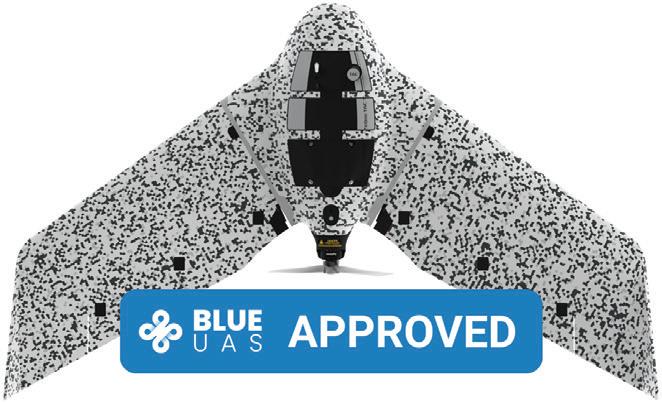
Concept-X is a smart control solution for construction vehicles on jobsites. It can survey worksite topography via 3D drone scanning, establish operational plans based on that data and operate heavy construction equipment, such as excavators, wheel loaders and articulated dump trucks, without human intervention. DEVELON has demonstrated Concept-X with an autonomous wheel loader and excavator. Concept-X technology paves the way for the worksite of the future with equipment-driven construction sites, freeing human personnel to tackle complex data analytics and management tasks. The company's technology products also include the Smart X-Care fleet management service and a topography scanning drone.

Trimble introduced the Trimble Siteworks Machine Guidance Module, extending the capabilities of Trimble Siteworks Software from surveying and layout to support on-machine excavator guidance and operator assistance. With the addition of the new software module, contractors can use the same Site Positioning Systems hardware and software to perform a variety of tasks on the job site, including surveying, machine
Now available in North America, 2D-MC is a 2D machine control system that is designed to be installed directly onto select grading attachments. Connecting directly to the machine’s controls and with a wireless display, the solution works along with common rotary laser technology to provide simplified operational visibility, with the information needed to hit target grade. Designed for slope work, sidewalk grading, road base and drain rock replacement, parking lots, sports fields, landscaping, flat pads, indoor work, concrete site prep and more, 2D-MC is an automatic grade control solution capable of adapting to different grading attachments for compact equipment, leveraging the performance of machine control technology with laser positioning.


Exodigo offers a non-invasive subsurface imaging solution for the construction sector, through a partnership with Esri, a company developing Geographic Information System (GIS) software, web GIS and geodatabase management applications. The partnership aims to help governments and businesses deliver capital projects and de-risk underground operations at scale. Exodigo employs multi-sensor fusion and processes varied signals with artificial intelligence (AI) into a single source. The density and speed of data collection and processing enables Exodigo to identify more buried assets. Esri ArcGIS users can now integrate Exodigo’s imaging and underlying data into existing underground utility maps to ensure that undocumented utilities are identified and even slight curves in utility.

guidance, in-field design and reporting.
Designed specifically for small site and utility contractors, the Siteworks Machine Guidance module gives users the ability to move the system between multiple excavators and jobsites as an accessible and entry-level combination machine guidance and construction surveying solution.

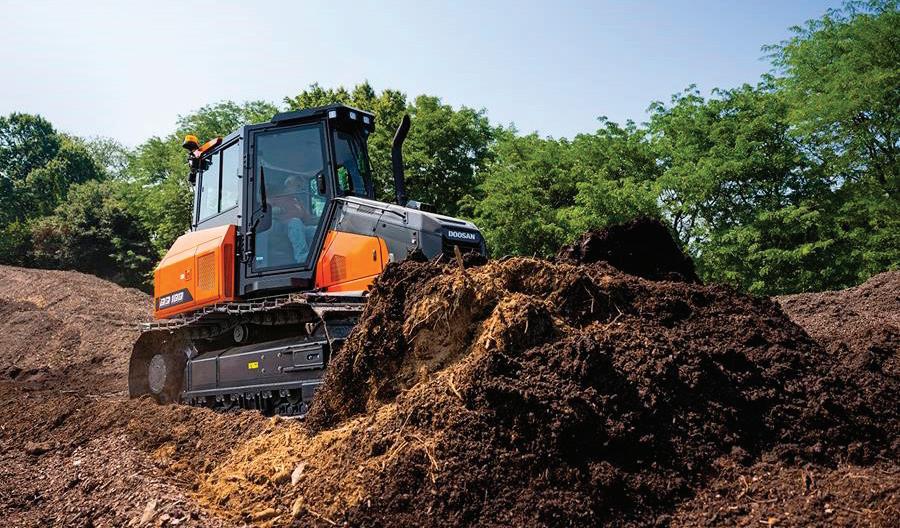
Safe Site Check In has announced new features for jobsite monitoring and tracking. Using the new Jobsite Observations feature, supervisors, workers, subcontractors and visitors can include notes, photos, videos and attachments to document jobsite conditions and progress. This provides contractors and project owners with realtime updates for project management, forecasting and planning. Additionally, Safe Site Check In’s observations and automated daily log information can be added to construction project management platforms including Procore Daily Log Notes. This way, general contractors can view the progress of each job, resulting in cost savings of approximately $2.50 per check in.


SmartPM Technologies has added an automated narrative report feature to its platform. The program automatically generates a narrative based on the schedule data set. The report is a text-based summary of multiple aspects of a construction job. It is designed for stakeholders involved in a project, as well as construction executives who want information about a project’s status but don’t have the time or expertise to decipher charts and graphs.
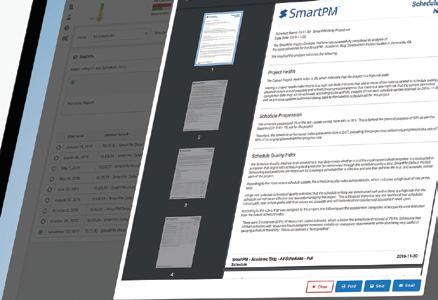

The PLT 400 is a digital layout tool designed to help jobsite layout crews that generates layouts using prism tracking and auto calibration. The PLT 400 can take BIM (Building Information Modeling) designed digital plans and lay them out, without needing to create points on the plans first. It can also be used during the building process to help keep BIM models up to date, contributing to an end-to-end workflow. Hilti's digital construction software is compatible with Revit, AutoCAD and other professional layout platforms. The layout tool integrates with Hilti's ecosystem of solutions, including ON!Track and Fleet program. Beyond having accessible tools and technology, Fleet customers can leverage free verification of tool accuracy in accordance with manufacturer's specifications, as well as theft coverage to reduce financial risk and unexpected expenses.
Caterpillar is launching a new mobile app that combines the company’s eCommerce experience -- search, find and order parts -- with access to asset-specific maintenance and support information. Cat Central offers one central place for access to ordering parts and general support resources while providing a faster shopping and purchasing experience. This app enables customers to order on the go. Cat customers who already have an account on parts.cat.com can expect a more simplified experience. However, any user is eligible to make a purchase without an account - as a guest.




Kojo's Automated Invoice Matching supports the accounting process for commercial trade contractors, helping eliminate billing mistakes. Automated Invoice Matching builds on Kojo’s purchase order and delivery functionality, making Kojo a a platform that allows customers to manage the materials procurement process. Invoice Matching instantaneously flags errors such as incorrect quantities and prices entered by vendors by automating the three-way matching process, comparing the vendor invoice to the purchase order and then to proof of delivery. This ensures vendors are charging contractors for the correct prices and quantities, at the line-item level. Invoice Matching allows Kojo customers to save time and eliminate manual data entry, while reducing the number of systems needed to complete a job.

Caterpillar announces new options for the Cat Smart Grader Blade and Smart Dozer Blade. The new external control kit for GB120 and GB124 smart grader blades expands use of these blades to Cat D and D2 series SSL and CTL machines, enabling customers with previous model fleets to run smart blades. The new 3D grade control kit uses existing connections to easily add automatic blade control to the Cat Smart Dozer Blade.





Cat Smart Grader Blades set the standard for machine and attachment control integration. Previously, these smart blades were made available for customers with Cat D3 series SSL and CTL machines. The new external control kit provides customers with a means to run smart grader blades on all D-series and select older Cat machines. Simplifying operation, GB120 and GB124 blades automatically detect whether they are being operated on a D3 series or machine equipped with the external controller.
The new external control kit includes a third joystick for operating blade raise/ lower, tilt, angle and wing functions like smart control for D3 series machines. In addition, it includes the wiring harnesses, a RAM mount, brackets and all the necessary hardware required for smart grader blade control. Compatible with Cat Grade and Earthworks GO! systems, the new external control features selectable modes for left, right and tandem control. Standard cross-slope assist and full proportional control of all functions improve operating efficiency.
The Moasure ONE is a motion-measuring tool made by Moasure. Designed for indoor and outdoor locations, Moasure ONE captures points and draws 3D diagrams simultaneously in the Moasure PRO proprietary companion app via Bluetooth and without the need for cell phone signal or GPS. Users can measure spaces and have a fully dimensioned drawing complete in the time it takes to walk around any outdoor or indoor space. Through the app, individuals could share diagrams with colleagues and clients, as well as export to design software.

To help with jobsite optimization, Komatsu has developed integrated technologies that support decision making for businesses in the construction and quarry industries. At CONEXPO-CON/AGG 2023, Komatsu showcased its portfolio of Smart Construction and Smart Quarry solutions. The full suite of Smart Construction technology solutions at the show include:
• Smart Construction Dashboard and Drone: By combining 3D design data with aerial mapping and intelligent machine as-built data, users can confirm quantities and see progress. This solution allows users to visualize the status of the jobsite with terrain data to drive production and decision making.
• Smart Construction Design: Move from rolled-up paper plans to a digital design file with Komatsu’s 3D data services that provide application-specific data. Komatsu experts can help maximize machine control technology through Smart Construction modeling services.
• Smart Construction Field: Get real-time insights straight from the field with cost tracking of labor, machines and materials. Perform machine pre-op inspections digitally and leverage a connected system to analyze costs against plan.
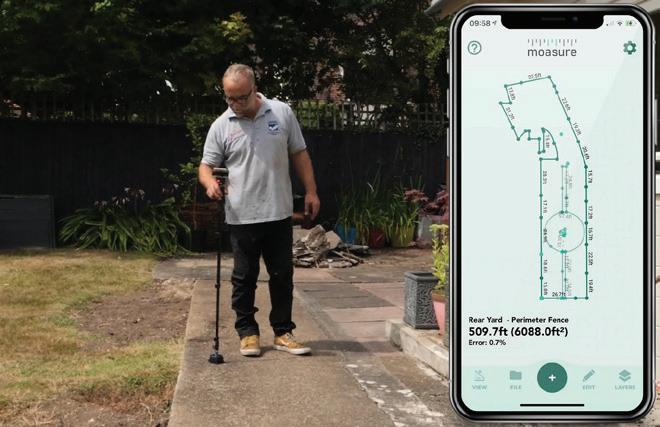
• Smart Construction Office: A central hub for all projects, this solution allows users to connect jobsites directly to management in real time with intelligent, autonomous project management tools that work behind the scenes to identify risks and provide forecasts.



• Smart Construction Remote: Remotely send files from the office to target machines and search all connected assets or log into a machine and see what the operator is seeing.
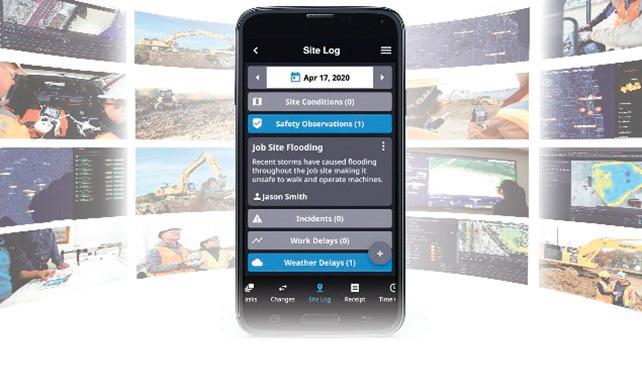





KASK, a designer and manufacturer of head protection has announced the introduction of the Zenith X2 – an ANSI Type II compliant safety helmet. Making slight modifications to the popular Zenith X helmet, introduced a little over a year ago, enabled KASK to achieve additional safety standards.
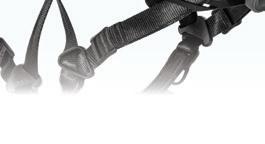

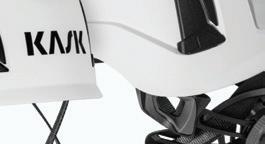
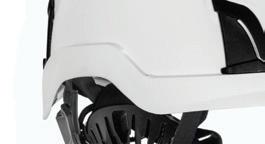



While the Zenith X2 still retains certifications for the ANSI Type I and EN 12492 clauses it has always met, KASK made an adjustment to the Zenith X to comply with the ANSI Type II requirements. The Zenith X helmet gained acceptance in the market recently. Because of this, KASK felt it was an acceptable platform when developing an ANSI Type II compliant safety helmet for the U.S. market. The result was a slight modification to the internal structure – and everything else about the helmet remains the same – from the outer-shell to accessory integration.
“This has been in the works for some time,” stated Fabio Cardarelli, CEO of KASK America. “Our first goal was to get our Chicago manufacturing facility operational, which we did earlier this year, and this is a great achievement to happen so quickly after that.”
KASK will manufacture the Zenith X2 for the U.S. market and has begun production in their Chicago facility. KASK will be taking pre-orders for the Zenith X2 in November with the plan for delivery before the end of the year.


A valuable tool for experienced as well as novice operators, the new 3D GPS/GNSS grade control for smart dozer blades on Cat CTL machines guides the operator to accurately grade planes, slopes, contours and complex curves. It provides blade vertical height and horizontal positioning guidance, or, alternatively, the system controls the blade relative to a design loaded into the grade control system. Automated blade control takes the guesswork out of what the grade should be, allowing operators to achieve design plans faster. Veteran operators can work more productively with the system, and those with less experienced can work more confidently and quickly build grading skills. Regardless of operator experience level, the 3D grade control system can reduce rework, labor and materials used on the job.
The base Cat Smart Dozer Blade comes standard with all the required hookups to install 3D grade control components. Software updates and the hardware are available for existing machines and smart dozer blades to operate grade control.

ORDER

As a global industrial company with more than 50,000 employees, Heidelberg Materials is in a position to make a real difference in the global construction materials sector, both in

terms of sheer cubic displacement, as well as through its central role in the concrete industry, as it evolves toward greater sustainability.
Heidelberg Materials produces aggregates, cement and concrete worldwide. Across this operational portfolio, the company has well-defined organizational goals for sustainability. It has committed to generating 50% of revenue from sustainable products by 2030 and reducing CO2 emissions to 400 kg per metric ton of cement produced.
The greening of concrete in particular has become an industry-wide effort, including environmental product declaration (EPD) requirements, led by NRMCA’s program and sustainability certifications for concrete plants and concrete professionals both. NRMCA is part of the Concrete Sustainability Council (CSC), of which Heidelberg Materials is a founding
member. CSC has certified Heidelberg plants for sustainable operation, including several in the United States.

In parts of the world where the circular economy is progressing more rapidly, Heidelberg Materials has acquired companies that recycle concrete post-use, and in the U.S. is building internal capacity for recycling concrete rubble from demolition rather than sending it to a landfill.





Another substantial area of accelerating progress being made in the U.S. is the adoption of internet of things (IoT) technology to reuse ready mix concrete leftover after a pour — concrete that otherwise would also wind up in the landfill.
Plants in Heidelberg Materials’ U.S. southeast region are rolling out the Command Alkon COMMANDassurance product, which harnesses the power of IoT to ensure ready mix meets quality and specification requirements.



Contractors and materials providers now have greater visibility than ever before into the mix.
COMMANDassurance leverages indrum sensors and other sensors on the truck, along with a cloud-based application, to provide visibility to the driver and the back office of what is going on with the mix. This extends beyond drum rotation speed and direction and other mechanical metrics to determine if the mix needs to be adjusted for an initial pour after its qualities change in transit, but also to ensure that leftover concrete from a pour still meets slump, temperature and volume requirements so it can be used on another project.
If a truck has a water meter installed, COMMANDassurance can also measure and track how much water as added in transit. Other
In-drum sensors and software from Command Alkon were already reducing waste and saving dollars by enabling concrete re-use and improving quality.
products in this smart concrete mixer category include the Verifi Solution from GCP Applied Technologies, which in turn leverages the AT&T IoT platform-as-a-service (PaaS) solution, Stratos Group’s eTrace.

While the industry is focused on environmental improvement, materials companies should also consider putting less waste in the landfill and atmosphere can mean cost savings and process improvements that are measurable in dollars and cents. While focused on reducing waste in current operations rather than the more systemic and structural changes the industry is going through, the COMMANDassurance technology has helped Heidelberg Materials southeast region save a quarter of a million dollars in 10 months of having the solution in place in a portion of the region.
This elimination of waste by enabling re-use is a simple and hard metric for Heidelberg Materials to point to. But a variety of other metrics can improve thanks to clear, real-time information on when the load is fully mixed, when it is ready for discharge, and when water was added to the mix and how much.
A slump indicator on the truckmounted system displays slump and temperature, enabling operators or even the customer to verify the concrete meets its specification. The unit also displays concrete volume, which will help operators and customers, as the volume drops during a pour, confirm they are getting the volume of materials ordered. Data
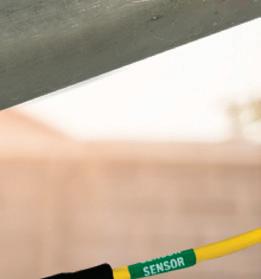
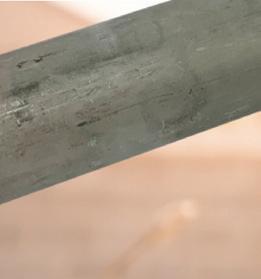
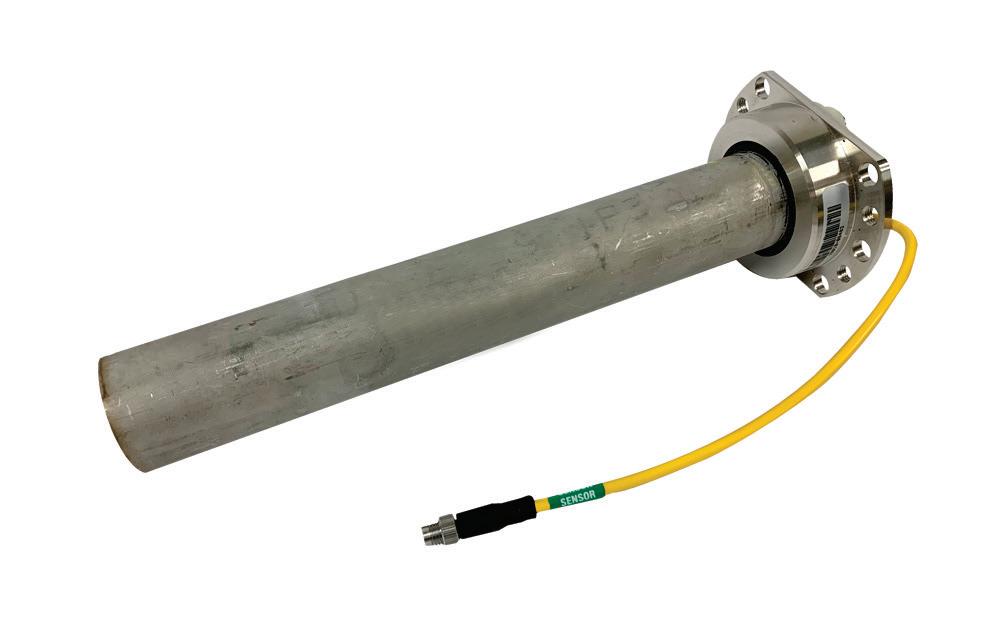
COMMANDassurance technology monitors and helps to manage properties ranging from slump, temperature, volume, water added and location/status of the truck.

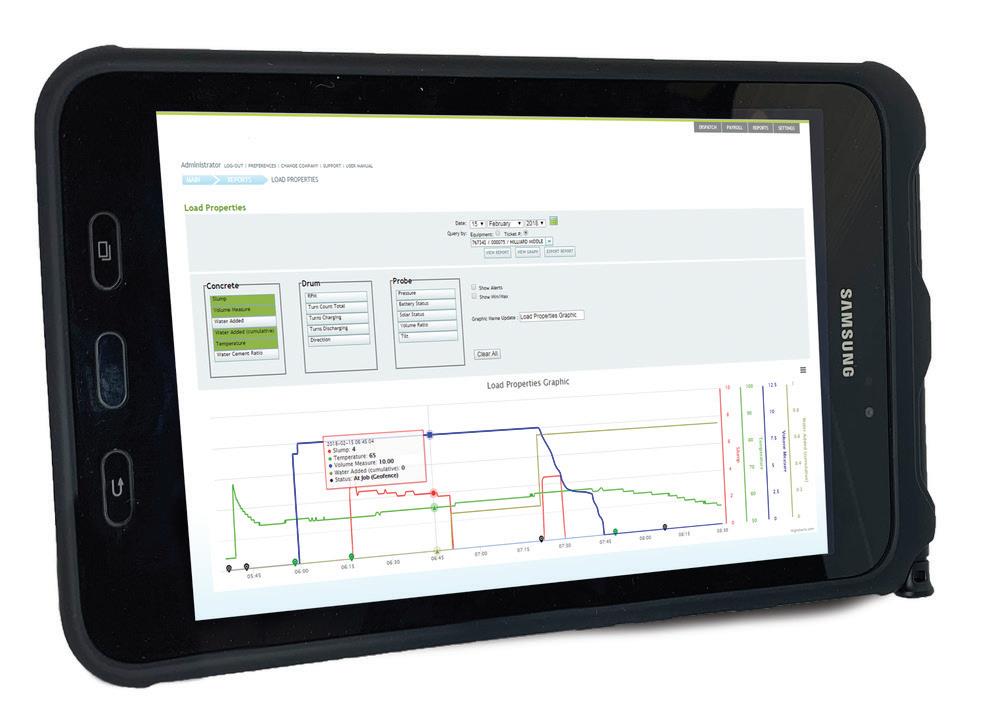
is also packaged into reports so quality management teams can analyze performance to drive operational improvement or document concrete quality for regulators and project stakeholders.
COMMANDassurance Implementation
Heidelberg Materials has had a beachhead in the U.S. since 1977 when it purchased the Lehigh Cement Co., which, with its single mill in Pennsylvania, and been producing Portland cement since 1897. Heidelberg Materials in 2007 absorbed Hanson PLC to create Lehigh-Hanson, a multi-national provider of cement, aggregates, ready mixed concrete and other construction materials. The U.S. company’s name changed to Heidelberg Materials in January of 2023.
Technical Services Manager for SE Region Ready Mix Scott Kelley said. “These plants are producing about 750,000 yards of concrete annually.”
The southeast region provides material to a broad mix of commercial and residential customers, with an almost even split in Georgia and a majority of material going to nonresidential in Alabama.
norm of course. We do a lot of bridges and some infrastructure, but southern states are not typically heavy concrete usage states for interstates and highways so most of our infrastructure is bridges.”
plants and running around 120 trucks,”
“We are running COMMANDassurance in Alabama and Georgia, across a ready-mix operation that includes 23 concrete batch plants and running around 120 trucks,” Heidelberg Materials Quality Control/

“We see everything from a 40-yard residential pour to a 30,000-yard commercial job. We’ve done pour sizes over 4,200 yards, but that is not the




over 4,200 yards, but that is not the specifications reliably and confirm onspec delivery to customers and project owners.
Between this mix of projects, Kelley and his team see high-specification jobs ranging from 2,500 to 8,000 psi. Having technology that helps them tightly control not just traditional quality measures, but specific qualities of concrete as it arrives on the construction site helps them nail these specifications reliably and confirm onspec delivery to customers and project owners.
For Kelley’s team, COMMANDassurance also closes the communication gap with project
tions when a load is when

much water was added, and
For Kelley’s team, COMMANDassurance also closes the communication gap with project stakeholders by sending notifications when a load is leaving the yard, when it is ready for discharge, how much water was added, and other data points.
This data eases real-time communication and underpins the work of a concrete producer’s quality team as they evaluate and optimize mix designs, mitigating against the need to overdesign the mix that previously may have been prudent lacking good data. This saves material costs because with more data it is possible to opt for a leaner mix design since the changes in transit can be planned around or even mitigated in transit. This enhanced visibility into the qualities and condition of concrete in the drum also prevents costly waste and rework from rip-and-replace.
Kelley remembers the first time he heard about rigging a drum with sensors to monitor it in transit.
“I had a friend working at Command Alkon at the time and he said he wanted to have lunch with me,”
Kelley said. “He had a big steel rod and said he wanted to put this in a drum and measure slump. I told him that if you can do this and do it accurately, it will change the face of the industry. You are starting to see these kinds of technologies coming out. We have totally changed the way we deliver concrete right now. We can test at the plant and at the job, but a lot happens in transit. Now, we can see from the time it enters that drum.”
Capturing IoT data from inside the drum and even managing those conditions actively in transit yields a huge data set, and Kelley relies on this data set to support multiple other functions. One of these functions is to avoid disputes through thorough documentation.
“Knowledge is power,” Kelley said. “When you are in the quality control role, you are put into some situations where you have to defend yourself by digging into the forensic side of concrete. He who has the most data usually wins. The temperatures in particular are key to the ability to reuse concrete. We have for a long time been able to track load times and batch times. But now being able to monitor slump, moisture, temperature, materials and volumes, these are the key components you were not able to track together and now you can.”
Precise data on what is happening in the drum helps decide whether or not to re-use a
In our Alabama business, our ability to use returned concrete was zero — we did not do it. You have to have a way to measure it to meet ASTM guidelines for reuse.”
Executives at a 2022 managing board meeting in Birmingham, Ala. examine the Command ALKON smart concrete mixer system now being rolled out in the Southeast.
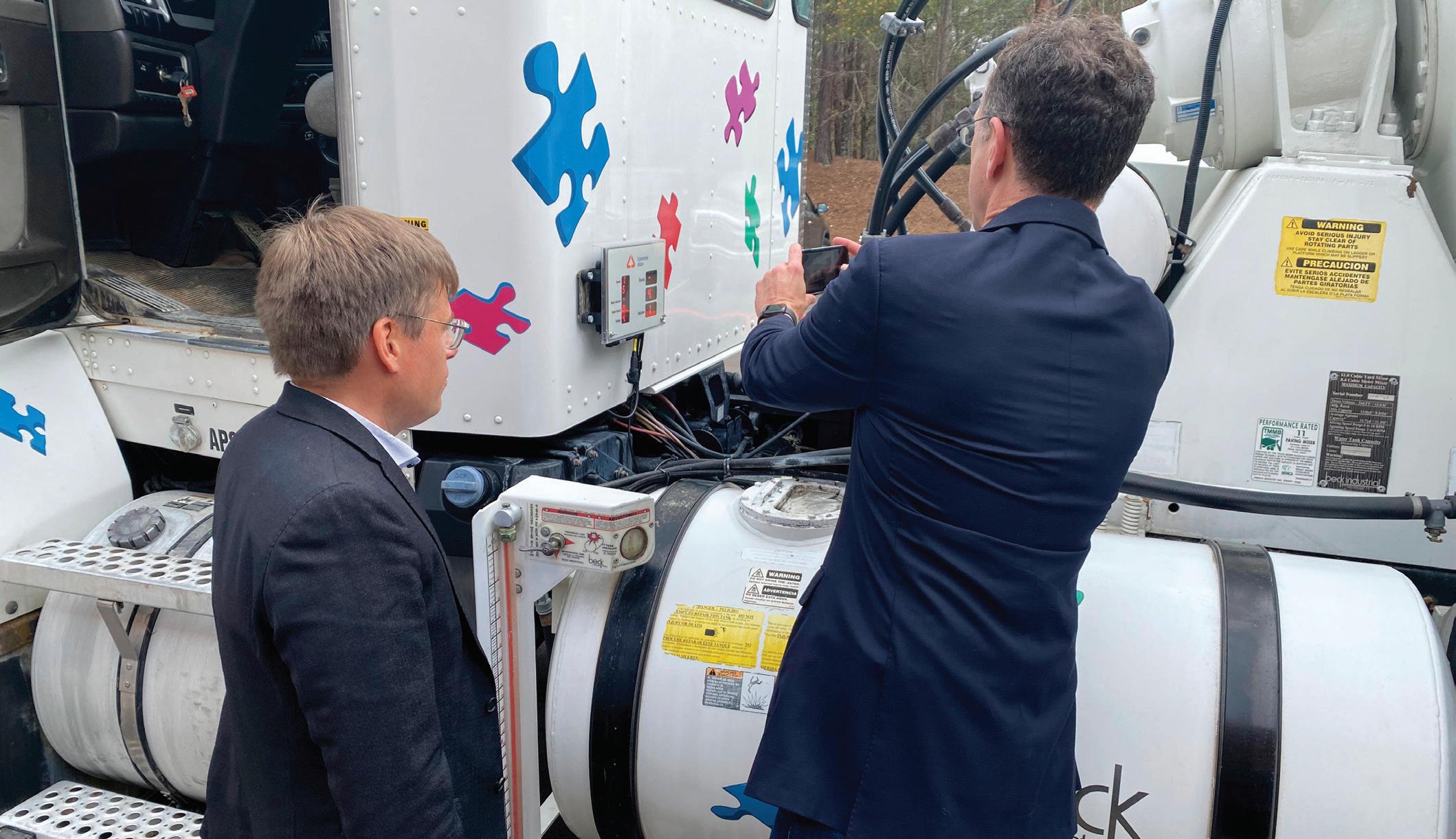
Technology for in-transit concrete management has won Kelley’s trust, but as its reliability becomes more widely understood, it may have farreaching implications for regulatory enforcement and other processes outside of the materials provider organization.
“I have enough confidence in this slump and temperature and other data to take that over what a third party does,” Kelley said. “The standard for slump, in my opinion, is less reliable because you can follow the standard and have 2 inches difference in reading. I have found is this technology is very consistent. Even if I was running a slump test, I would take the consistency reading based on pressure.
The COMMANDassurance system combined in-drum monitoring, optional moisture control and real-time visibility to take ready mix quality control to new levels.


Command Alkon

“We can then add that to or send it to a different order, or load on top of an order depending on paramteam and I set up,” Kelley said. “That has saved us a pretty good bit of money in terms of being able to reuse that concrete instead of haul to landfill and get rid of it. Our broader focus is on sustainability, but this is one of the bigger areas of hard
partial batch. to parameters the quality control tainability, of ROI for this technology.
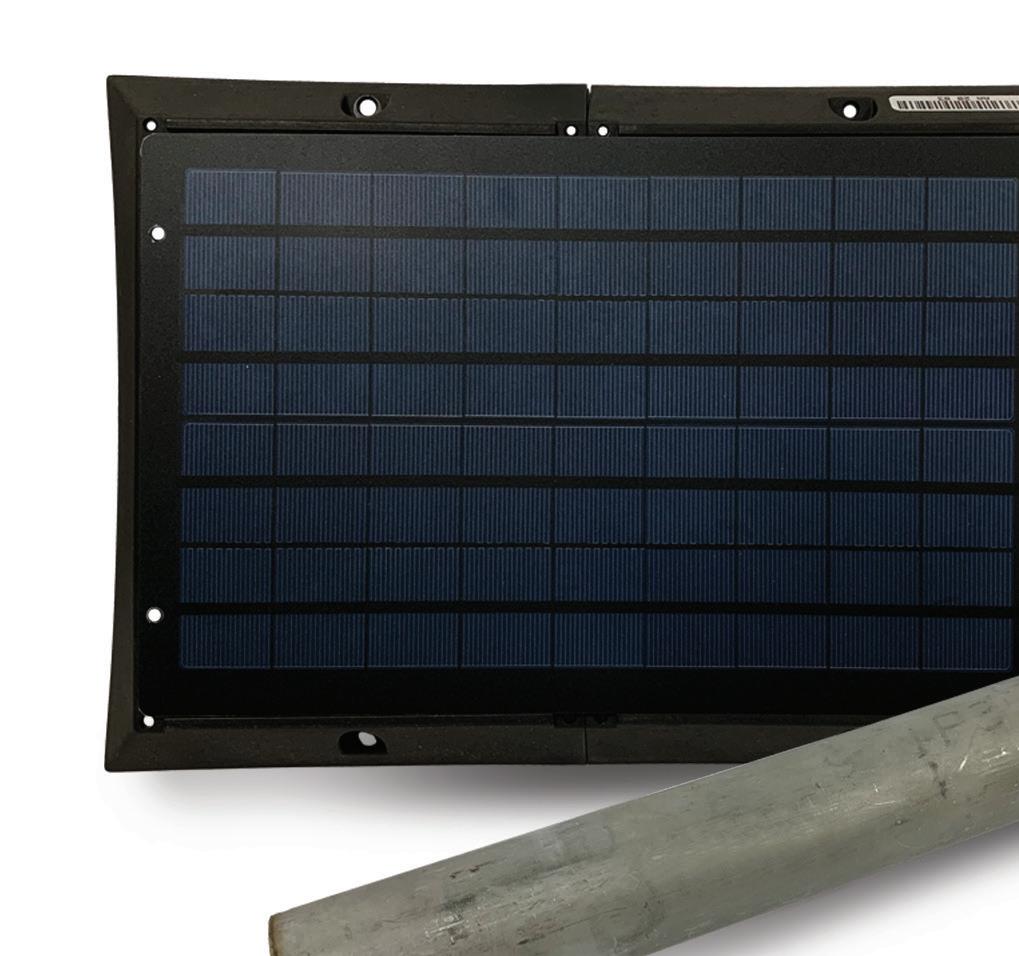
Under ASTM C1798 guidelines, a materials provider can re-use concrete up to eight hours after its original mixing time. Also, the temperature of the concrete to be re-used must not exceed 100° F.

The added confidence in the properties at the time of pour enable designing mixes around these new, tighter, tolerances.
“We have been able to optimize the mix design because of this technology,” Kelley said. “We can tighten standard deviations. Some of our mix designs change over time, but this technology has shown me that, for instance, we were a little water thirsty on some of our mix designs. We are now able to optimize designs that we already thought were okay.”
You can calibrate that number to a slump number and measurement, and I would take it over 100 tests. In that test, the concrete may pull faster or slower, but digital gives you a true reading.”
Even an integrated, engineered solution like COMMANDassurance is not the end-all, according to Kelley.
“Air content is a constant battle in the ready-mix world, and our next thing may be trying to chase air content,” Kelley said.
Read more at: https://eqtoday.co/indrumsensor

Trained experts inspect the equipment from its chassis down to its sprockets, create a detailed Verified Conditions report, and upload photos and video to every listing.




Our five-star rating system confirms the quality of the equipment you’re purchasing. A quality and condition rating is given to product specifics like chassis, undercarriage, engine, hydraulic system, and more.
Your purchase is protected through eBay’s Business Equipment Purchase Protection.

All inspections are completed by bidadoo experts, a trusted eBay partner with over 20 years of industry experience.
Get end-to-end support at every step through bidadoo experts for questions about the product, shipping, financing, or liens and warranty.
Chassis
Sheet Metal/Body
Paint/Decals
Frame
C-Frame/Push Arms
Blade Linkage Pins/Bushings
Belly Pans
Undercarriage
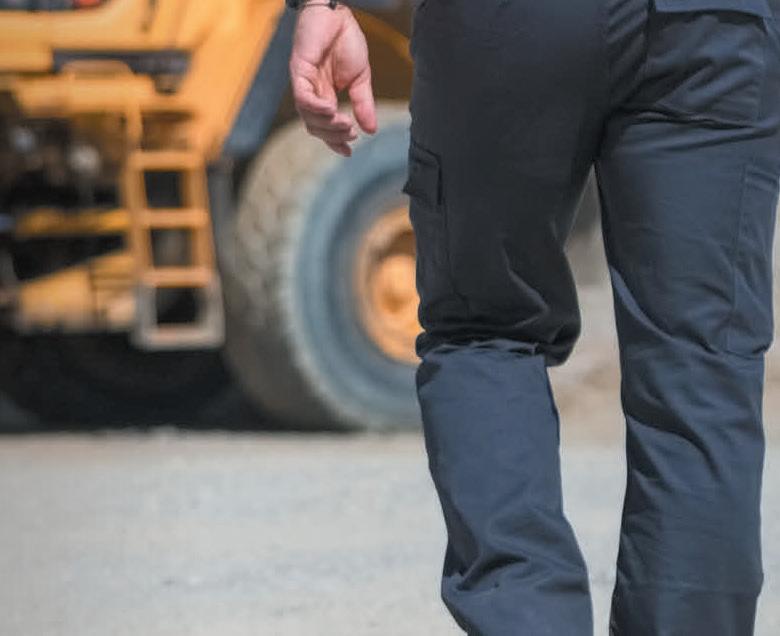
Track/Show&Link Condition









Track Tensioners
Front Idlers
Sprockets
Rating Key



Based on age and use
Poor Very Good
Did you know that firstyear employees account for more than 25% of all workplace injuries? That figure, courtesy of the U.S. Bureau of Labor Statistics (BLS), highlights a facet of one of the most pressing
issues facing the construction industry today — a lack of qualified and skilled workers. According to the Associated Builders and Contractors organization, the industry faces a workforce shortage of 650,000 people. Alongside that labor shortage, ABC
also noted the number of entry-level construction laborers has increased 72.8% since 2011.
Less experienced workers can face significant risks in the construction industry, especially in a tight job market. Here’s what you need to know to

keep your employees and your business thriving.
Assess and Improve Recruitment and Hiring Practices
Effective hiring practices are a key element of success for any
business. Cutting corners to fill positions, and place applicants into the field without sufficient vetting or thorough training can lead to more than financial risk for your construction business. It may also put people — including your experienced workers and even innocent bystanders — in danger.
Here are four key steps you can take to improve your hiring practices. Establish and follow written employment guidelines and job qualifications.
Consult a legal expert to review your company’s recruitment and hiring processes, and make sure those processes are compliant with state and federal laws.
Perform background checks as part of your hiring process, including checking references from past employers.
Review Motor Vehicle Reports (MVRs) prior to hiring and assigning employees to work in any company vehicles.
Though you may do your due diligence and follow these tips, employment-related lawsuits can still occur, and bring with them escalating settlement costs that can threaten the financial stability of any company. It’s imperative to consider employment practices liability insurance (EPLI) for your business. This type of coverage can help further protect you and your business if an employee claims employment-related issues like discrimination, wrongful termination, or harassment.
In a tight labor market, you may be tempted to quickly onboard hires and get to work. The BLS notes that most training in the construction industry is short term and on the job. Proper and effective training can help prevent injuries.
In the most recent update from 2020, the BLS notes that 64% of the nearly 70,000 nonfatal occupational injuries and illnesses in the construction industry involved workers with less than five years of experience. Those injuries resulted in an average of 12 days away from work.
The health and safety of your employees is your responsibility. To protect your employees and your business, it’s imperative you build a culture of safety, with procedures and policies that begin even before someone is hired. This can be done in several ways, including:
Work with your insurer to develop a comprehensive safety plan. Hold regular safety meetings and encourage employees to take ownership by allowing them to lead the meetings and celebrate success. If your team is following the procedures and policies you’ve set forth and you’re seeing the results, recognize it and harness that momentum toward a safer a workplace. Perform a worksite analysis to identify areas where injuries occur with greater frequency. Adjust your safety training for new hires according to your findings and retrain current employees. Implement effective hazard prevention controls to protect all workers from workplace hazards. These controls will help avoid injuries, illnesses, and incidents, and minimize or eliminate safety and health risks. Make sure you communicate the steps you’ve taken and reinforce the message over time. Consider equipping company vehicles with telematics. As noted, you should make it a priority to conduct thorough assessments of MVRs prior to hiring new employees. (Nearly a third — 30.9% — of construction workers are required to drive on the job. Driving includes operating passenger vehicles, light trucks, and motor operated equipment.) In addition to that, consider equipping company vehicles with telematics to help monitor safe driving habits. When your employees are on the road, there is so much at stake. Doing what you can to help protect your people and your investments is good leadership and good business sense.
Lead by example. As part of management, it should be clear you are equally committed to the safety plan you’ve put in place. It sends a clear message to new and longtime employees alike. This includes modeling safe behavior and following proper procedures. Ensure your actions match your policies, like wearing your PPE when necessary and calling out hazards you may see as you walk through construction sites — with positive notes of encouragement for how your team can improve situations. It’s also important to avoid distracting your drivers with phone calls or text messages if they’re out driving your company’s vehicles. Set a standard for everyone else on your team by leading by example.

Once the framework for your program is set, regular safety audits can help you measure its effectiveness over time. You can help control the potential for employee injury, and your costs, by identifying — and addressing — program gaps. Your insurer may have a loss prevention and safety services team that can help you with safety audits, bringing any risks to light before an accident happens.
After your audit, take time to analyze each element of your safety program for potential enhancements — and make a plan of action:
Address the areas you need to help improve to reduce your accident rates.

Provide the necessary training and resources for employees, and make changes to your onboarding materials where needed.
Clear communication and collaboration helps everyone on your team understand their role in creating a safer, more productive workplace.

In a job market where skilled labor is a scarcity, sound hiring practices paired with a robust safety program can help your business reduce its risks. It may even help you save money and keep your projects on schedule in the upcoming year.

Don’t wait until it’s too late to protect your business and your employees. Talk to your insurer or local experts to develop a comprehensive risk management plan that fits your business needs. Together, you can find ways to overcome the current workforce obstacles.
Randy Dombrowski is a safety services manager for Sentry Insurance.
Read more at: https://eqtoday.co/onboarding
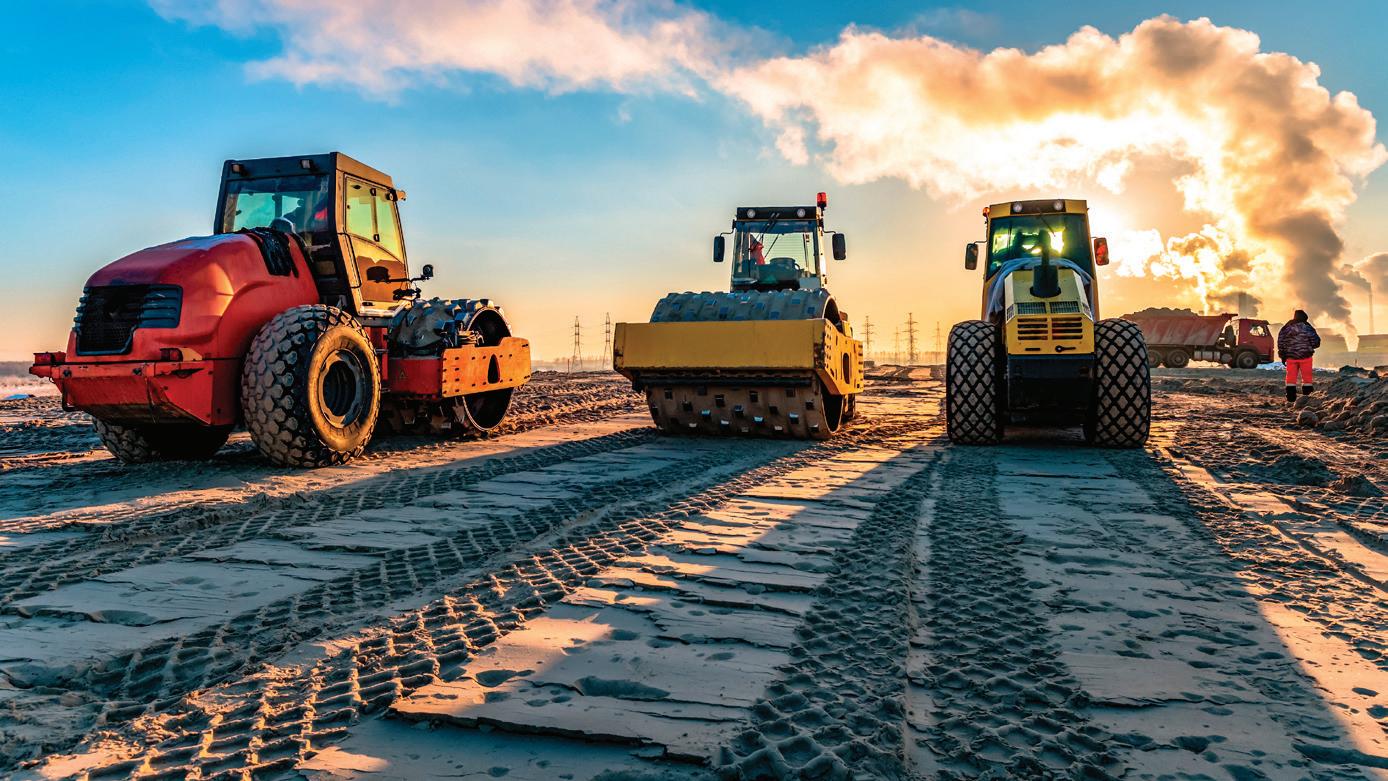
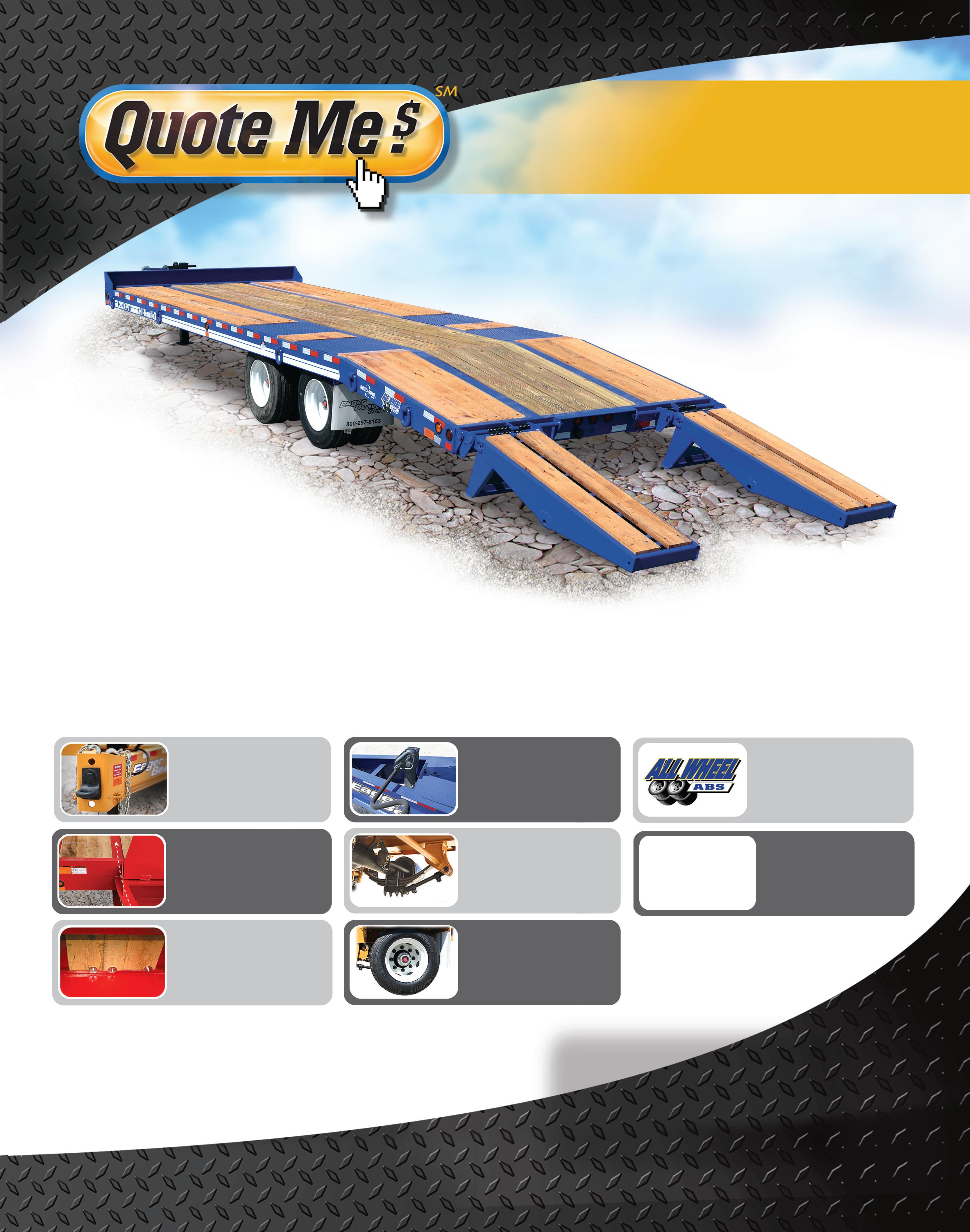
It is still a bit nuts out there. The economic and construction ball just keeps going up and down, up and down.
Inflation is still with us, and it looks like it will be tough to get rid of. Because of inflation, it looks like interest rates will keep rising and be around longer than anticipated. While some material costs have decreased, supply chain issues continue to drive the purchasing folks nuts.
Electric vehicles (EV) are still at the top of the list when it comes to looking at new equipment, but there are alternatives.
And if I see or hear one more ERC commercial, I am going to put a hole in the TV.
AI, I hope, will replace the ERC hype. And AI sooner rather than later will have you managing your work without getting out of bed.
What all this tells me, from a financial perspective for just about every business out there, is TO MANAGE THE BALANCE SHEET to avoid cash flow and bank covenant issues.
With a number of dealer groups I work with, there is an understanding that whatever happens in the auto industry will soon show up on their doorstep. And nine times out of 10, that premise holds true. When you think about it, what happens at the dealer and rental company level falls on your plate, too. In short, what happens in the auto industry probably impacts your business, as well.
So, I would like you to go on YouTube and search for Wealthion Lucky Lopez. It is a 51-minute presentation that will inform you about what to take into account in terms or your equipment needs going forward. I watched this program three times and concluded that it all makes sense, because the discussion ties it all together. After you take the plunge, it will be a lot easier to make your CapEx
decisions for 2023. Lucky is not only a car nut, but also an auto industry nut. He owns dealerships, auction operations, deals in auto purchase and lease paper, touching all aspects of the industry, which helps him form his thoughts on the cycle taking place.
In terms of alternative fuels and EV, to replace most diesel or gasoline machines, you have options, but it is not a one-size-fits-all solution. You have BATTERY ELECTRIC, DIESELELECTRIC HYBRIDS, HYDROGEN and HYDROGEN FUEL CELLS.
My concern with the new GREEN models is the cost versus what you would have to pay (if you can get a new unit) for the standard propulsion system you have been using. I understand the need to reduce emissions, but I also understand that higher priced new units will require a higher cost to be passed on in your bids to customers. And when I hear that some new units can cost two to three times the cost of the current models, that worries me.
From what I have seen and read, it appears the cost of operation of the new operating systems will have a lower cost, which will make up for the initial higher cost of ownership. But in the meantime YOU HAVE HIGHER
COSTS TO DEAL WITH that will impact cash flow, insurance cost, debt service and bank covenants. And believe me these HIGHER COSTS are major issues to be dealt with.
· A $50,000 unit at 8% over 60 months will require a $1,104 monthly payment with $10,829 of interest.
· A $150,000 unit at 8% over 60 months will require a $3,041 monthly payment with $32,000 of interest.
Sure, you will have an income tax benefit if you use bonus depreciation and/or Section 179, assuming you have taxable income to offset the deprecation against. But remember, when you sell the unit you will have a 100% recapture on the selling price, no matter what your book value is.
So, I have two concerns. Will you be able to pass these higher costs on to customers? Because if not, cash flow will suffer. The second concern being the increase in fixed cost, higher interest payments and an increase in bank debt or lease payments, all of which could negatively impact bank covenant ratios. And one last concern addresses collateral values.
Bank loans are based on collateral values. They like to be covered on the loan to value (LTV) ratios, because if they are not, it will cause them a
In this economic environment, the balance sheet needs to be as strong as you can make it. CapEx expenditures need to be considered carefully before signing on the dotted line.
load of trouble, which will be passed on to the borrower (that’s YOU). As with many new products that hit the market, the initial cost to purchase is high, which then decreases as more units are produced. You can expect to have the value of your used piece of equipment decrease in value, maybe forcing the LOV ratio to go negative.
Believe me, I have been through this before. . . “Mr./Mrs. Customer, we find that your equipment value is less than the outstanding balance and YOU have to fix that.” The bank will not care if your maintenance on the new unit is lower then your spend on the old equipment; they will request payment to put the ratio back to where they need it to be. Watch the auto presentation to see what I mean.
In the end, in this economic environment, I believe the balance sheet has to be as strong as you can make it. Consequently, CapEx expenditures need to be carefully considered before you sign your name to the contract.
You may want to ask the rental companies you use to rent you one of these new products to see how it works before you commit to a purchase. Or, you may want to rent until the pricing comes down to more realistic prices. Or you may want to wait until some of the other alternative machines are available for sale. But, whatever you do, please be careful and make sure cash flow is properly maintained.
Garry Bartecki is a managing member of GB Financial Services LLP and a consultant to the Independent Equipment Dealers Association.
Read more at: https://eqtoday.co/2023spending
Trailer Weight: 8,380 lbs.
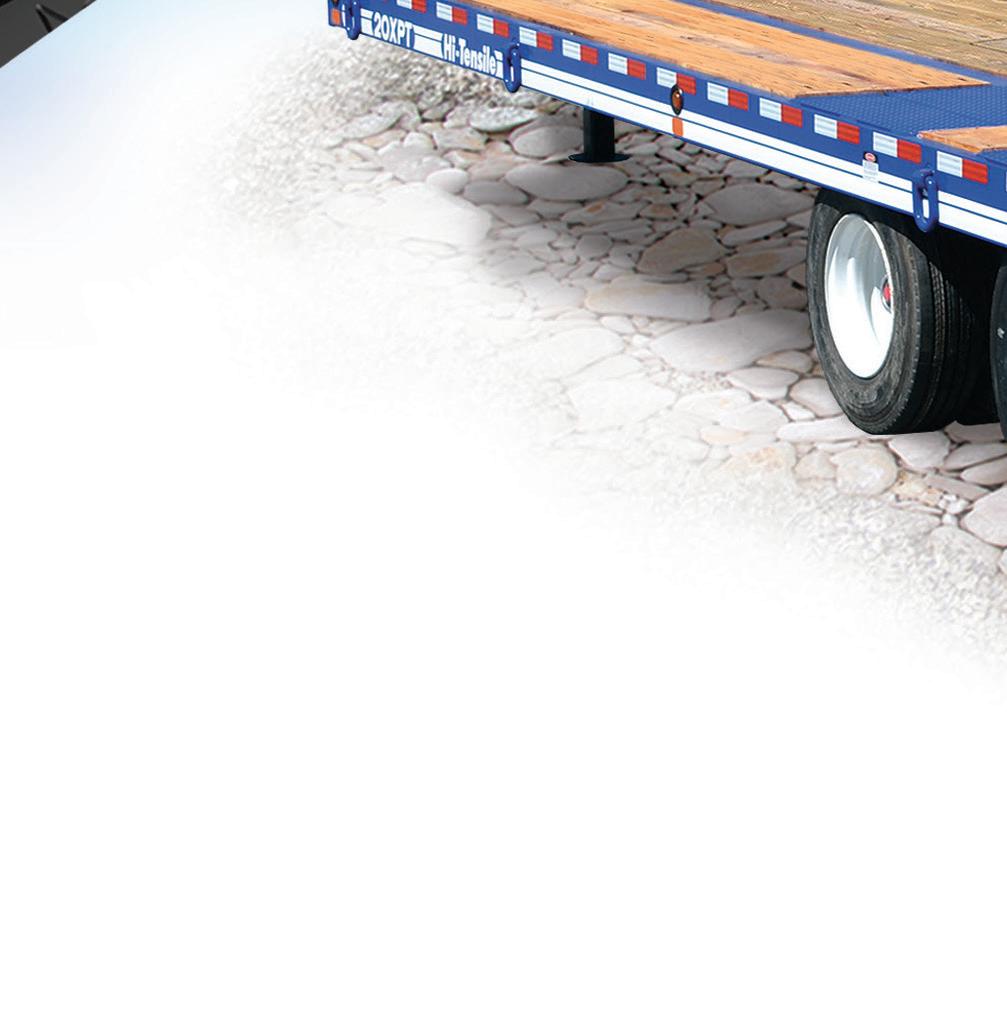
Overall Width:102", Length: 31'4"

Deck Length: 21’ Flat (model shown)
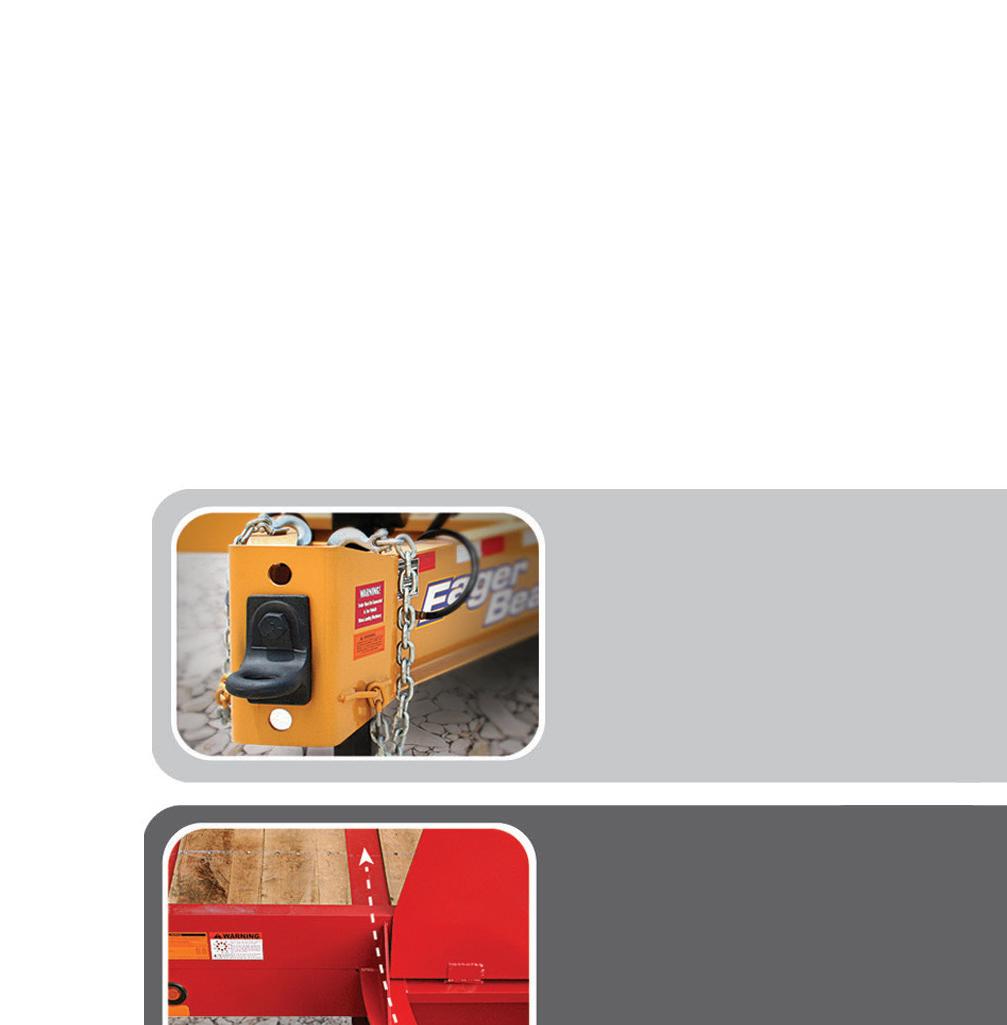
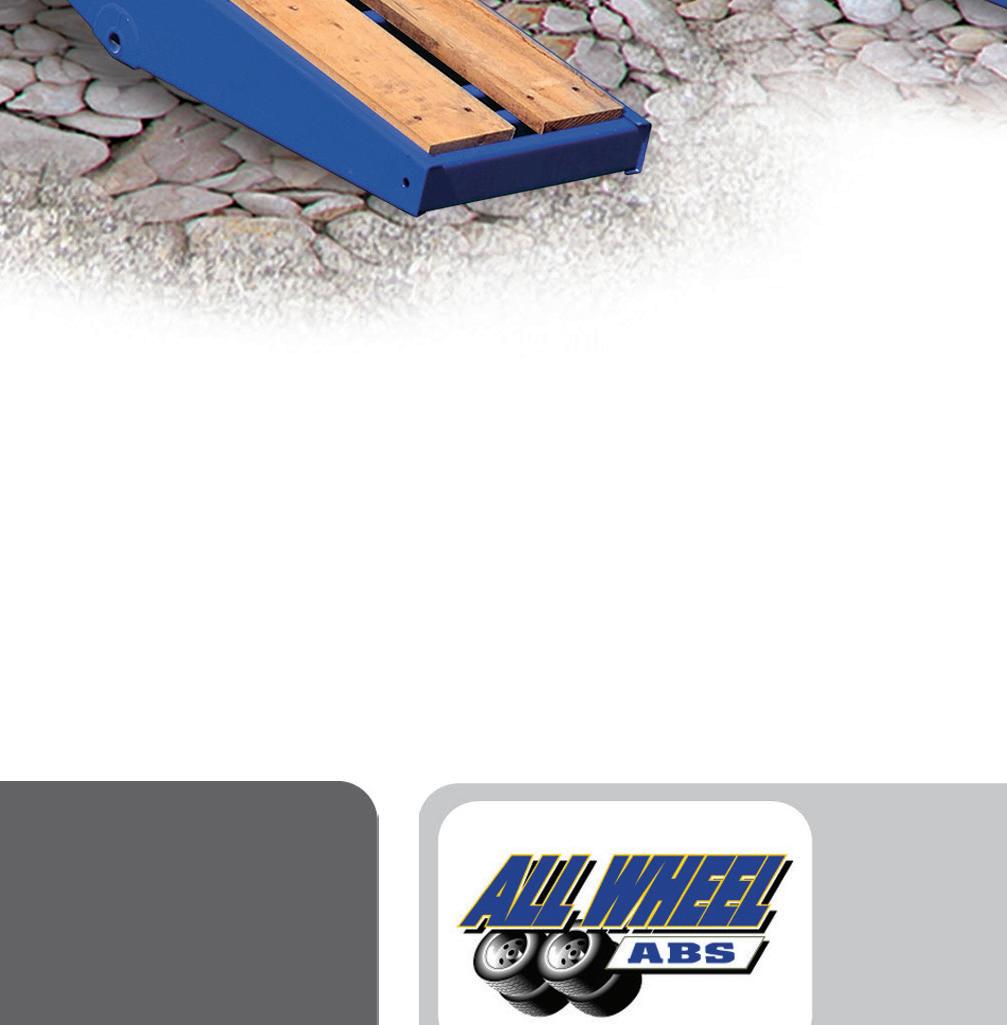
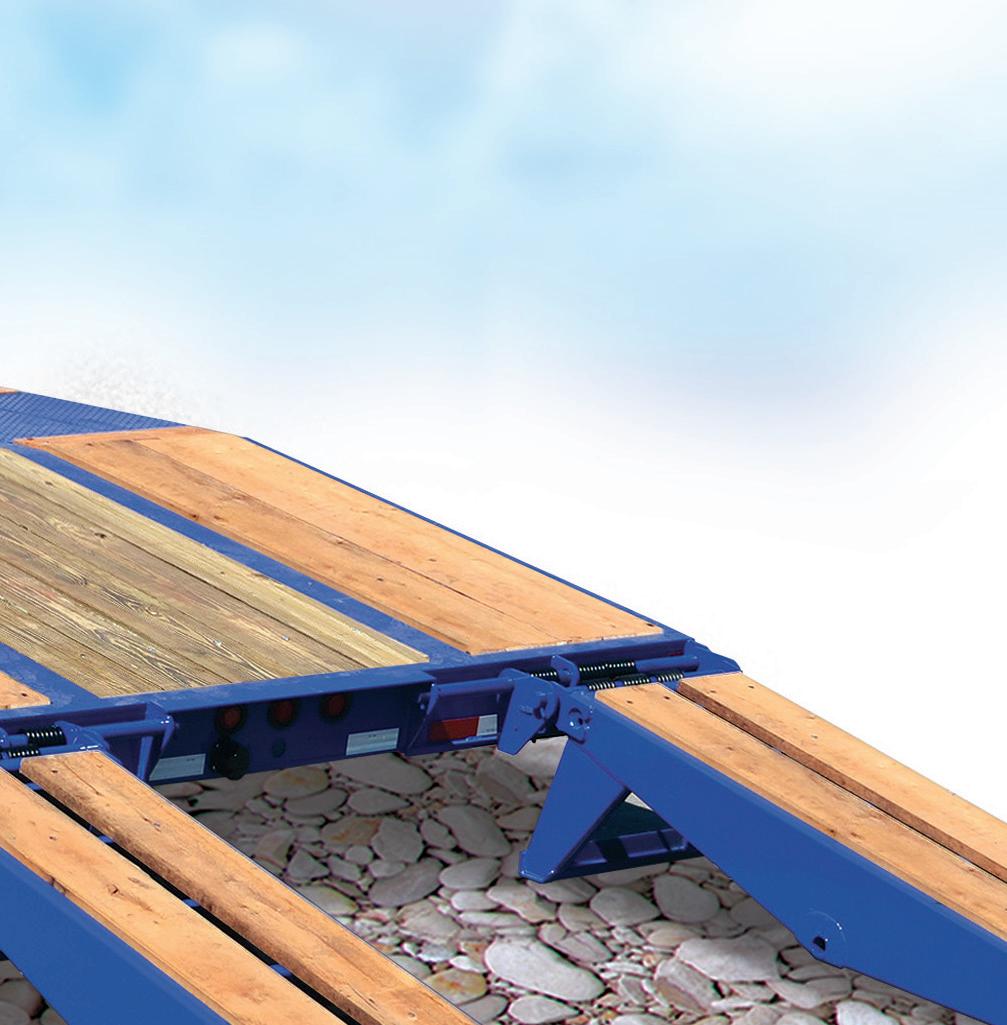
6’ Beavertail

Deck Height: 34"
Tires: Eight 215/75R17.5 (H)









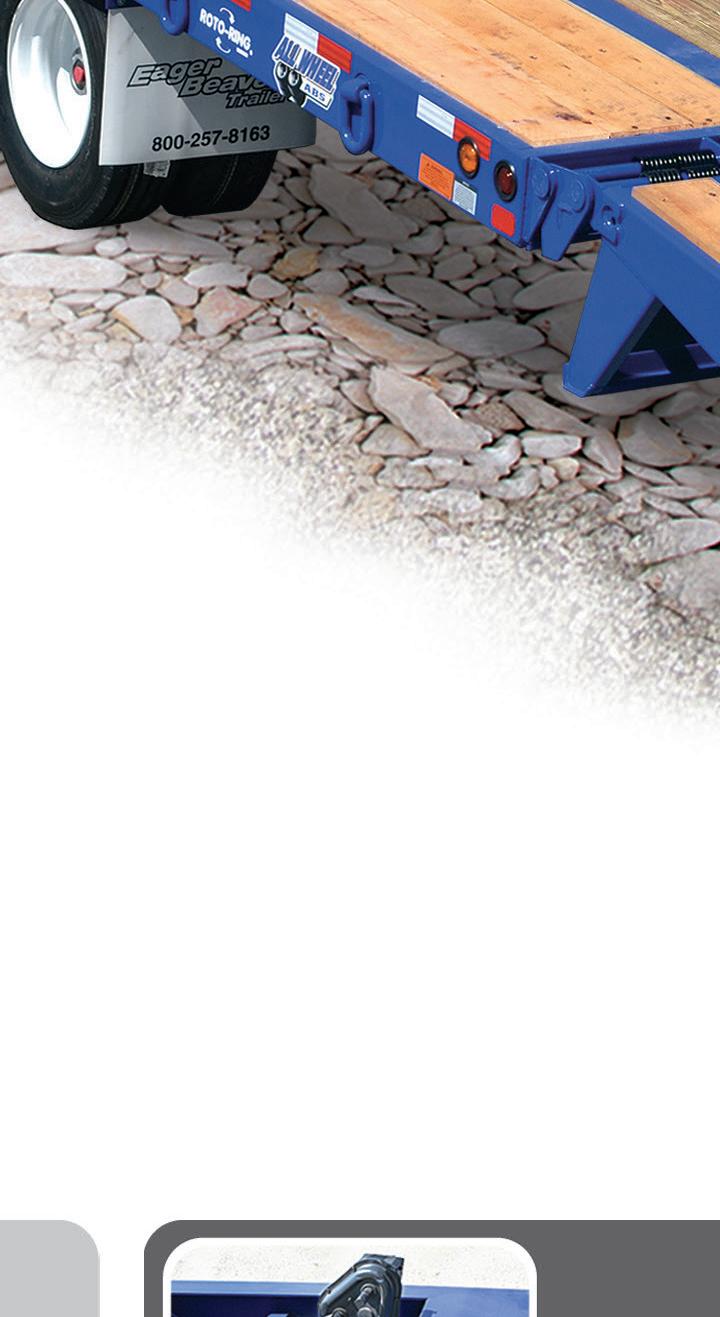



Brakes: Air (Full ABS System)
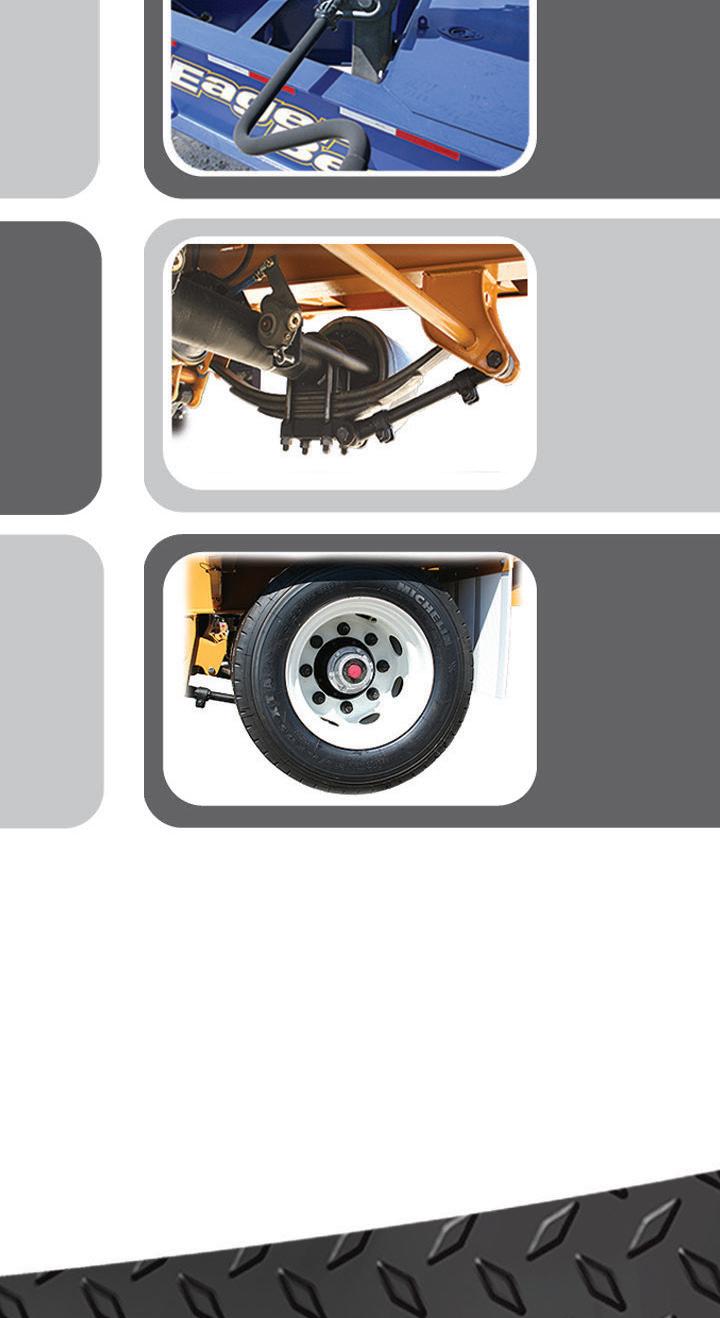
Ramps: 72" Long x 22” Wide Range: 102" Max. 29" Min.
Lighting:100% Sealed Wiring harness and L.E.D. Lights

Take electric to the next level. WE














Get ready to go big with our groundbreaking 22-ton EC230 Electric, the first mid-sized electric excavator in our lineup. Experience the same power and performance — or better — in a machine that significantly reduces your energy running costs.




